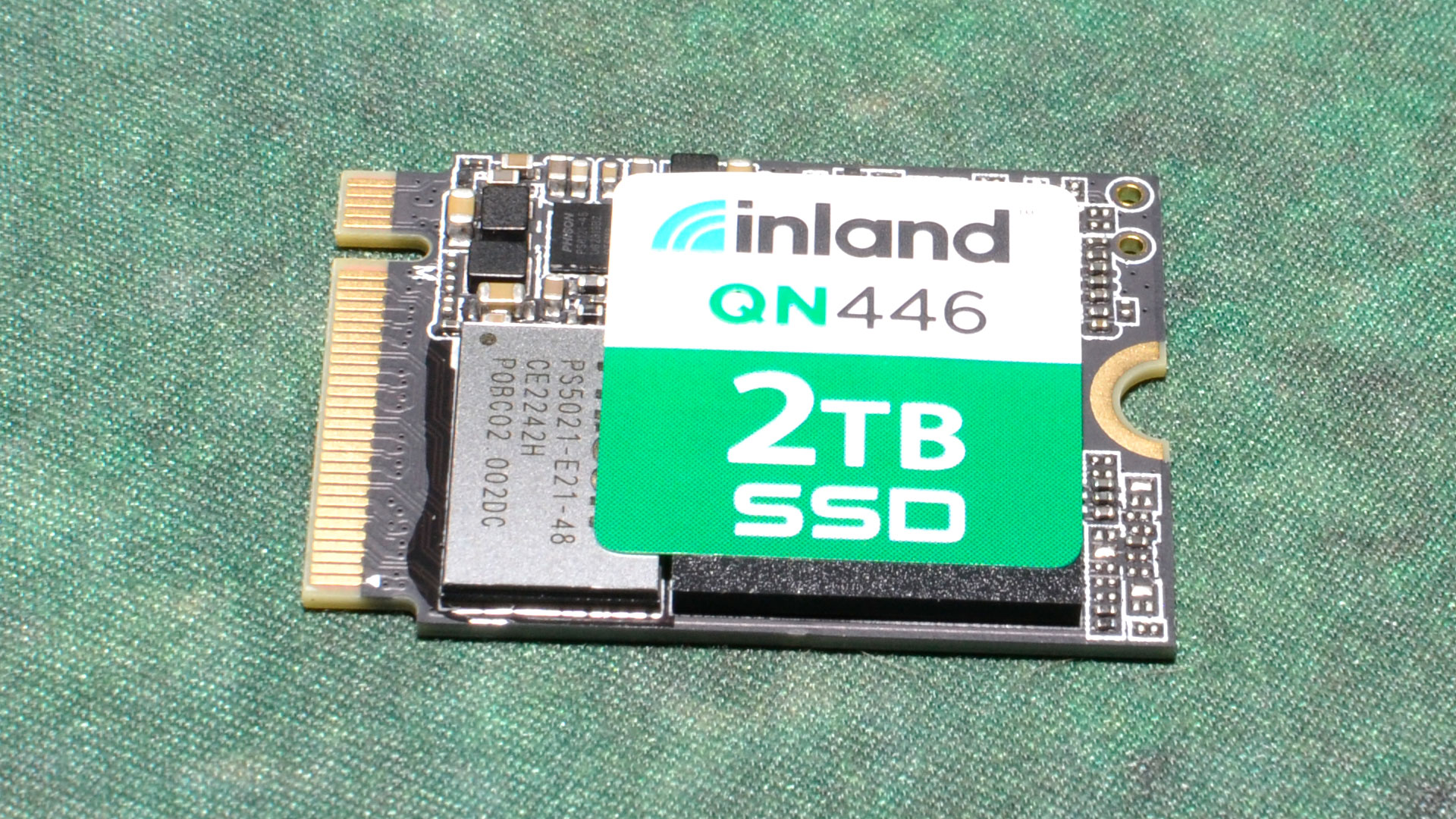Why you can trust Tom's Hardware
Comparison Products
To keep things honest, we’re comparing the QN446 - which currently only comes in the 2TB flavor - to other 2TB drives with QLC. This list includes the Silicon Power UD90 2230, the Addlink S91, and the Sabrent Rocket Q4 2230. The Teamgroup MP44S is a 1TB QLC drive, and the Inland TN436 is a 1TB last-generation drive from Inland. The best 1TB drives, which have TLC, are the Corsair MP600 Mini, the Sabrent Rocket 2230, and the Inland TN446. We’ve also included the powerful 2TB WD Black SN770M to round things out for the high-capacity models.
Steam Deck - General
To gauge general Steam Deck performance we engage in a variety of typical storage situations with active time measurement. These activities include dealing with the default SteamOS through initial setup, re-imaging, initial booting, and booting in general. For game testing we see how long it takes to install and boot the popular title Hollow Knight. For a full explanation of our testing procedure, see our main article.
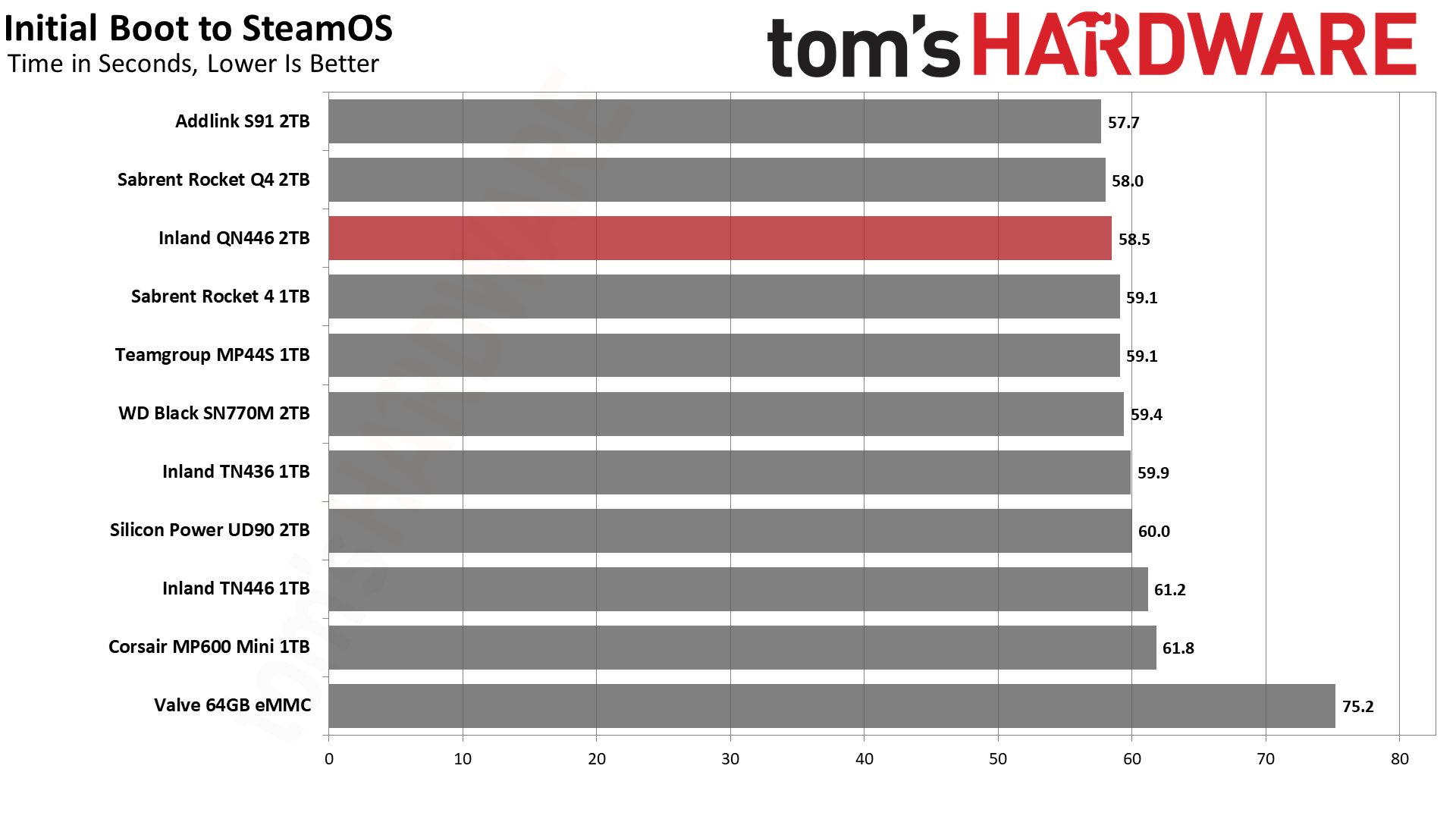
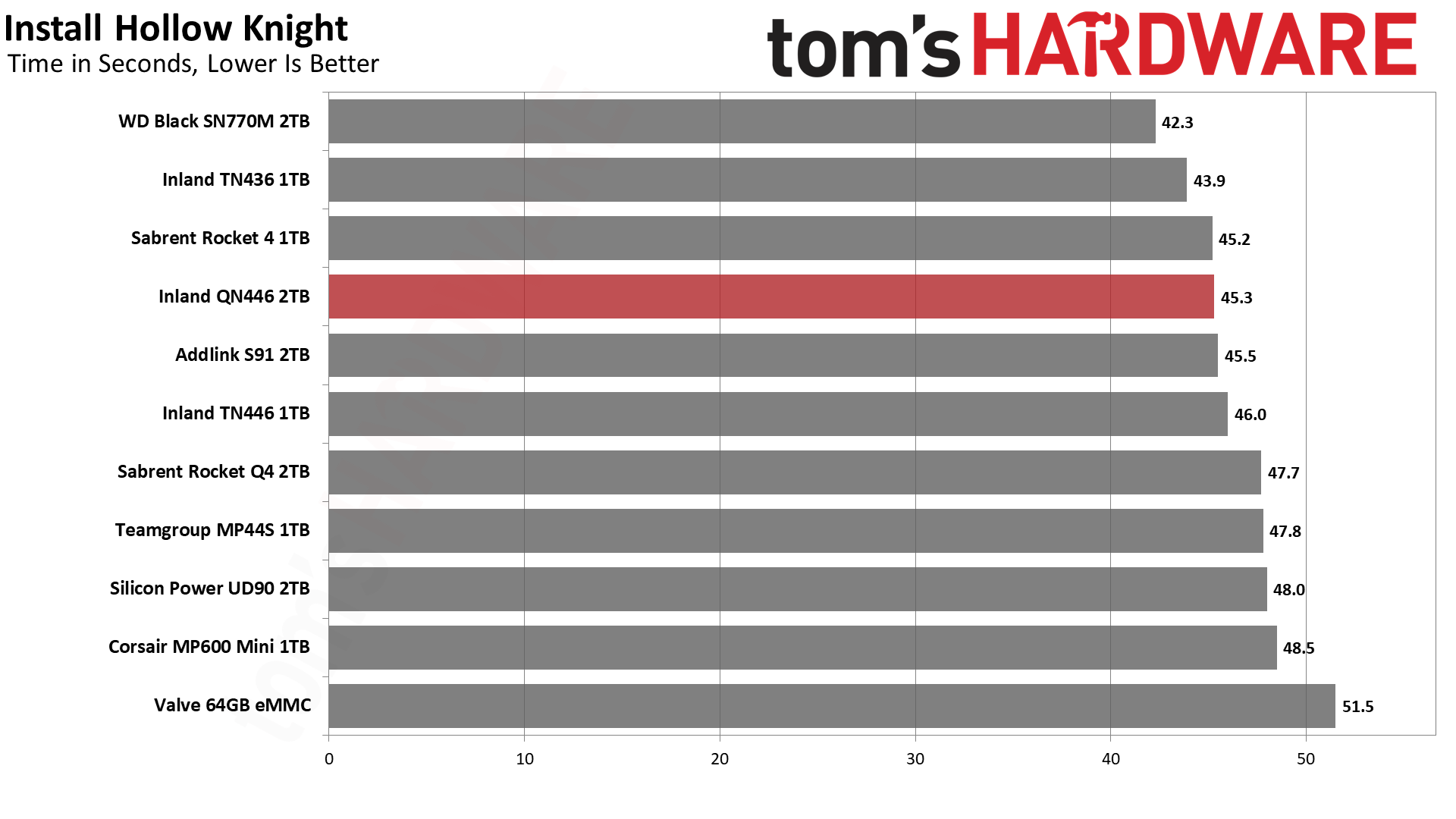
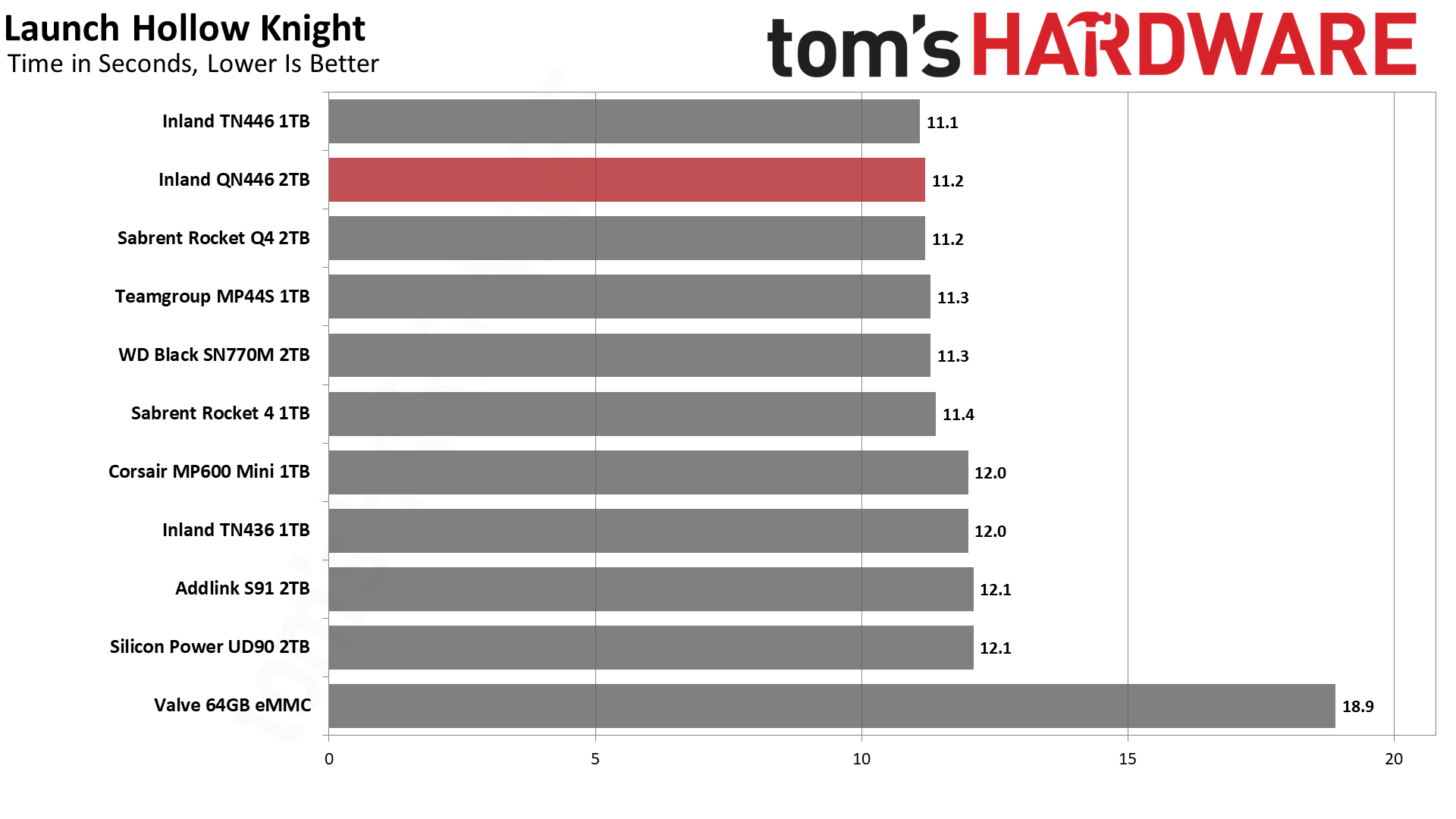
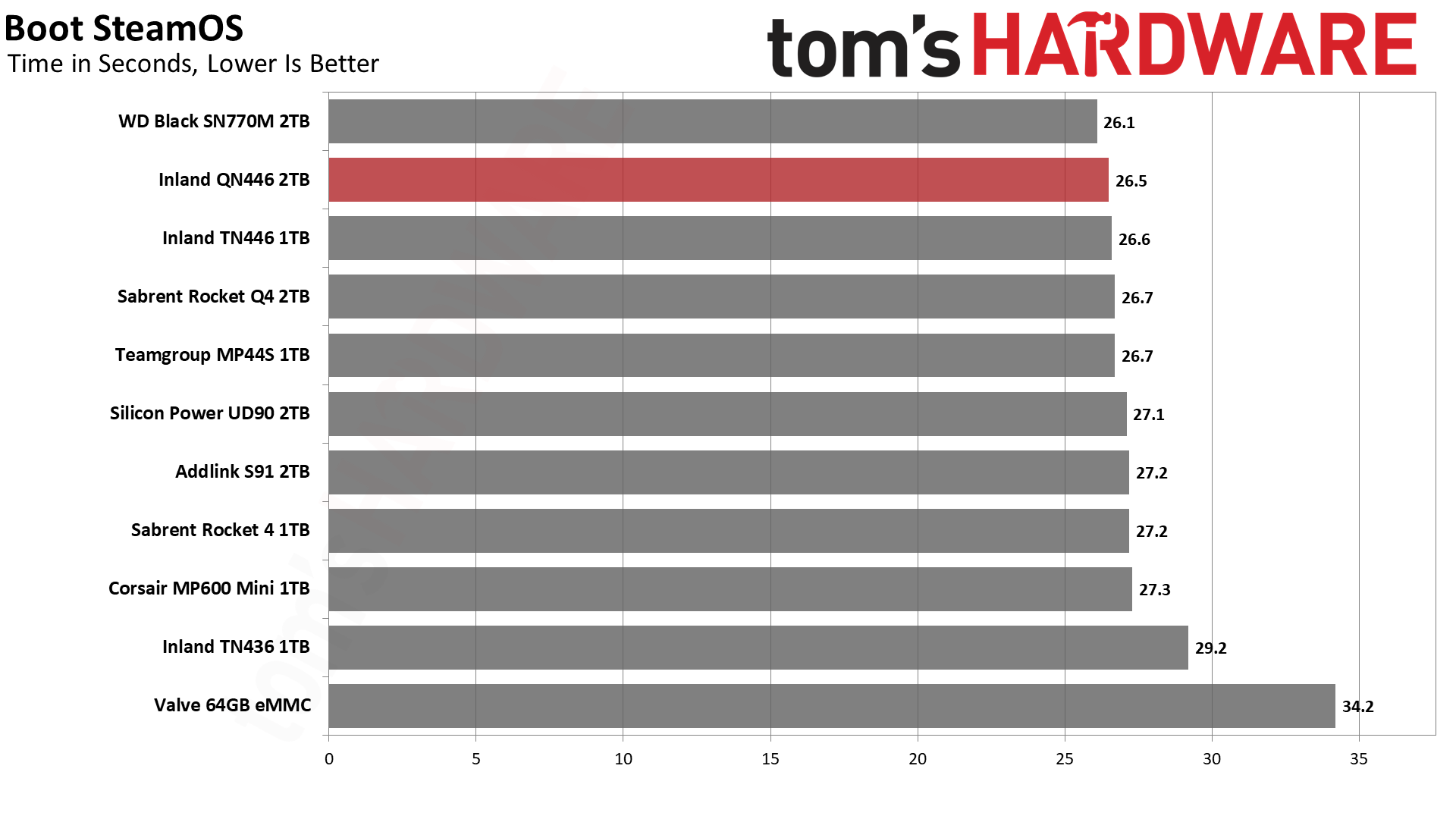
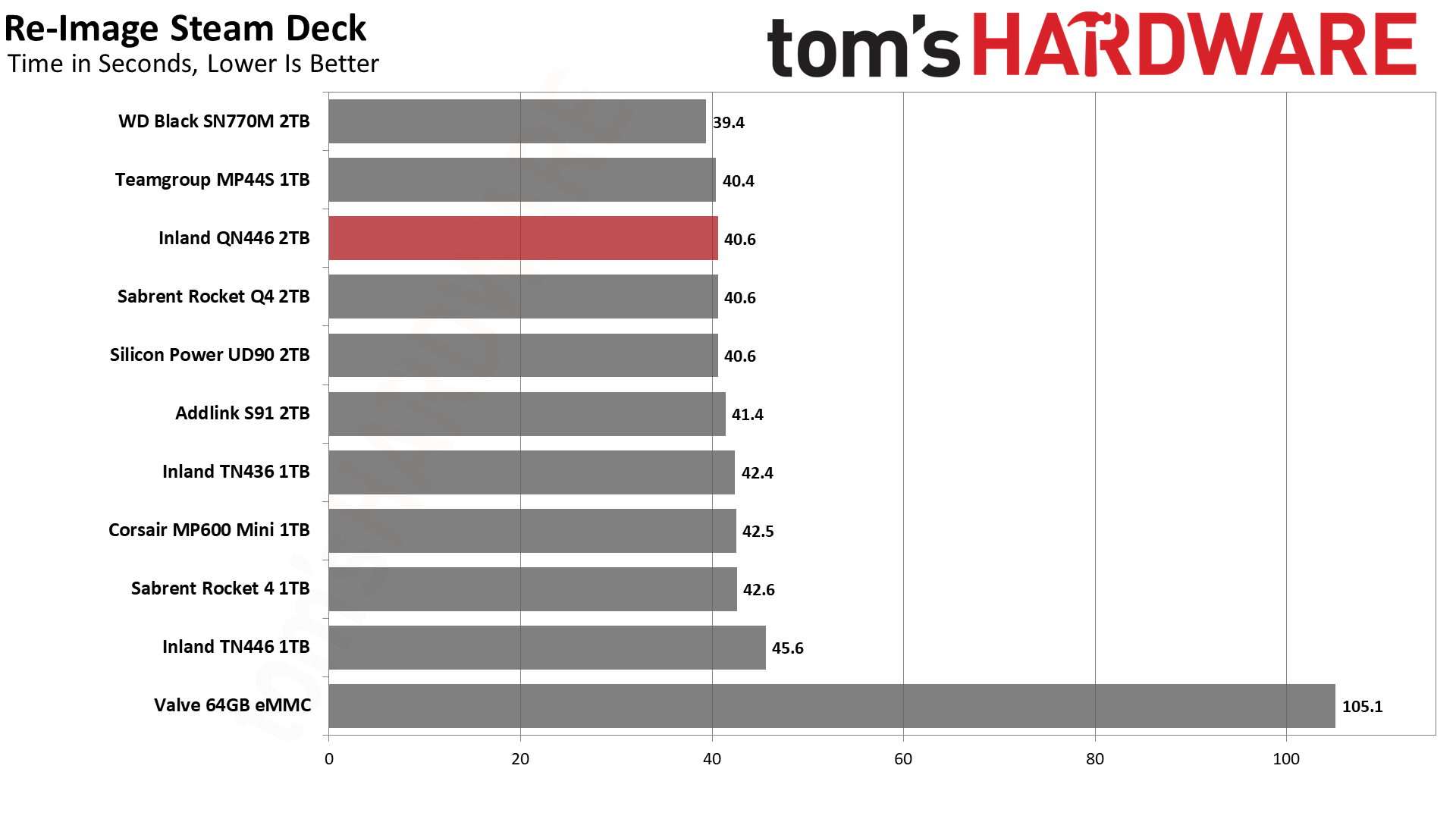
It’s very difficult to perceive real differences in everyday performance between these drives. We can say that they all provide a significant improvement over the stock 64GB drive, and likely a smaller improvement over the stock 256GB and 512GB SSDs. If any one drive stands apart, it is the SN770M, but given its power draw and thermal output, that isn’t too surprising. We feel that a QLC-based solution could be a good compromise when considering all factors, including cost.
Steam Deck - KDiskMark and Temperature
One of the most popular, if not the most popular, storage benchmarks is CrystalDiskMark (CDM), which we use in our own Windows-based SSD testing suite. This benchmark relies on Microsoft’s DiskSpd with templated test settings. CDM lets you quickly see how a drive performs against its idealized, rated specifications and the benchmark can also hint at a more “real world” feel with low queue depth I/O testing.
The Linux flavor of this benchmark, which is easy to install on the Steam Deck, is KDiskMark. The “K” refers to the KDE desktop environment used on the Deck. KDiskMark relies on the Flexible I/O tester, or FIO, instead of DiskSpd. For the temperature portion we use data from the SMART sensors on the drive which can be directly polled and from which the maximum temperature can be extracted.
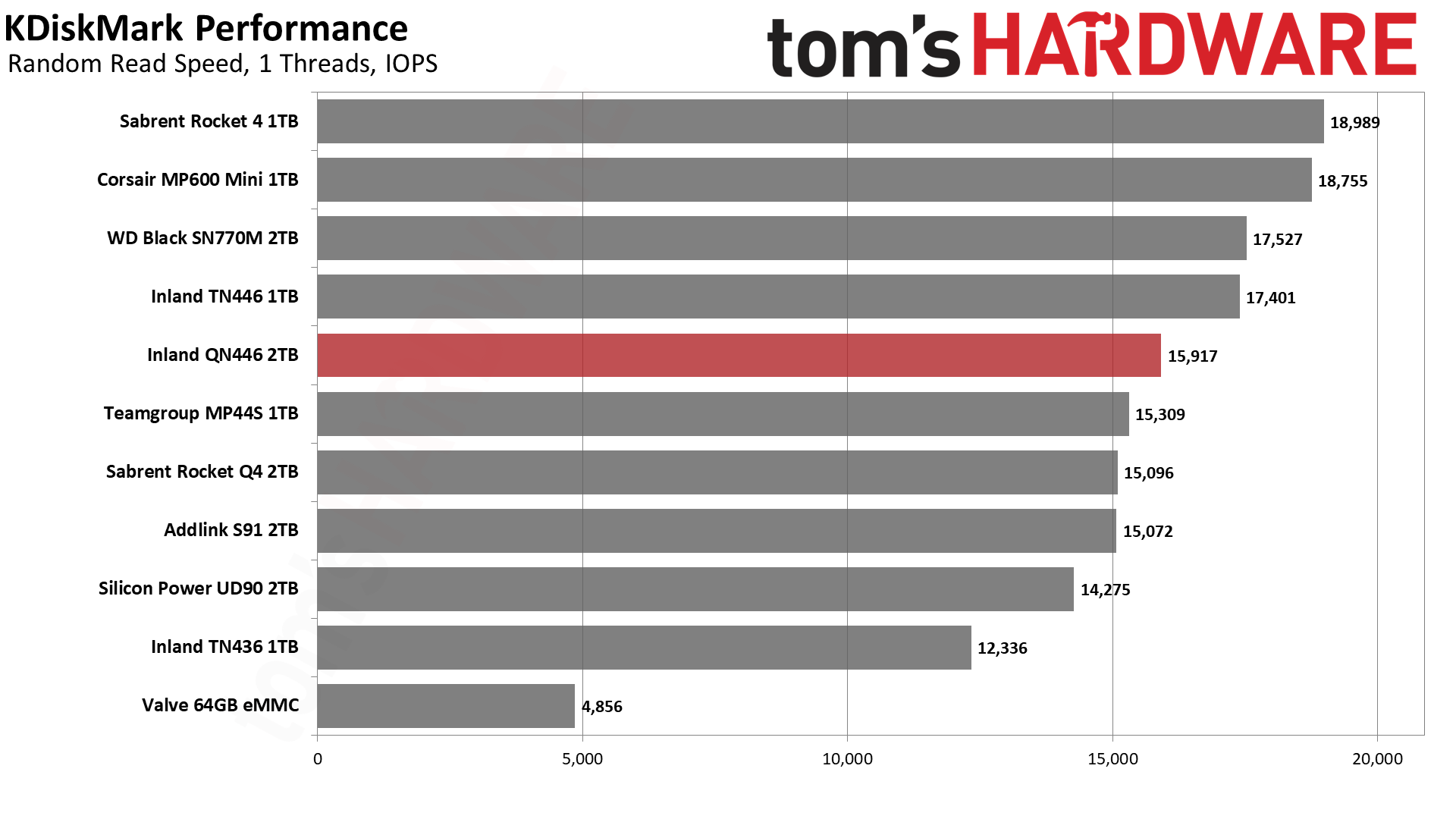
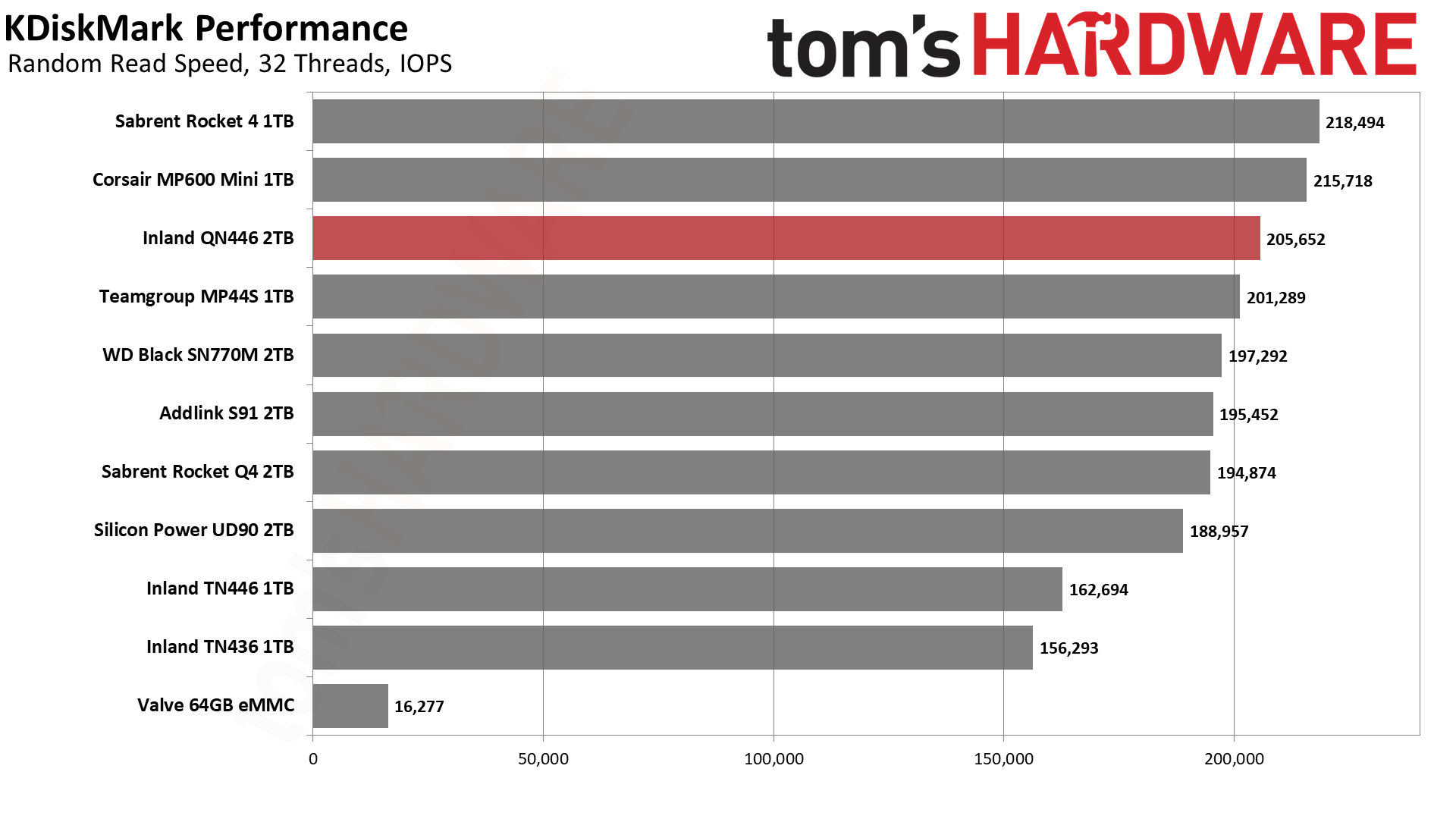
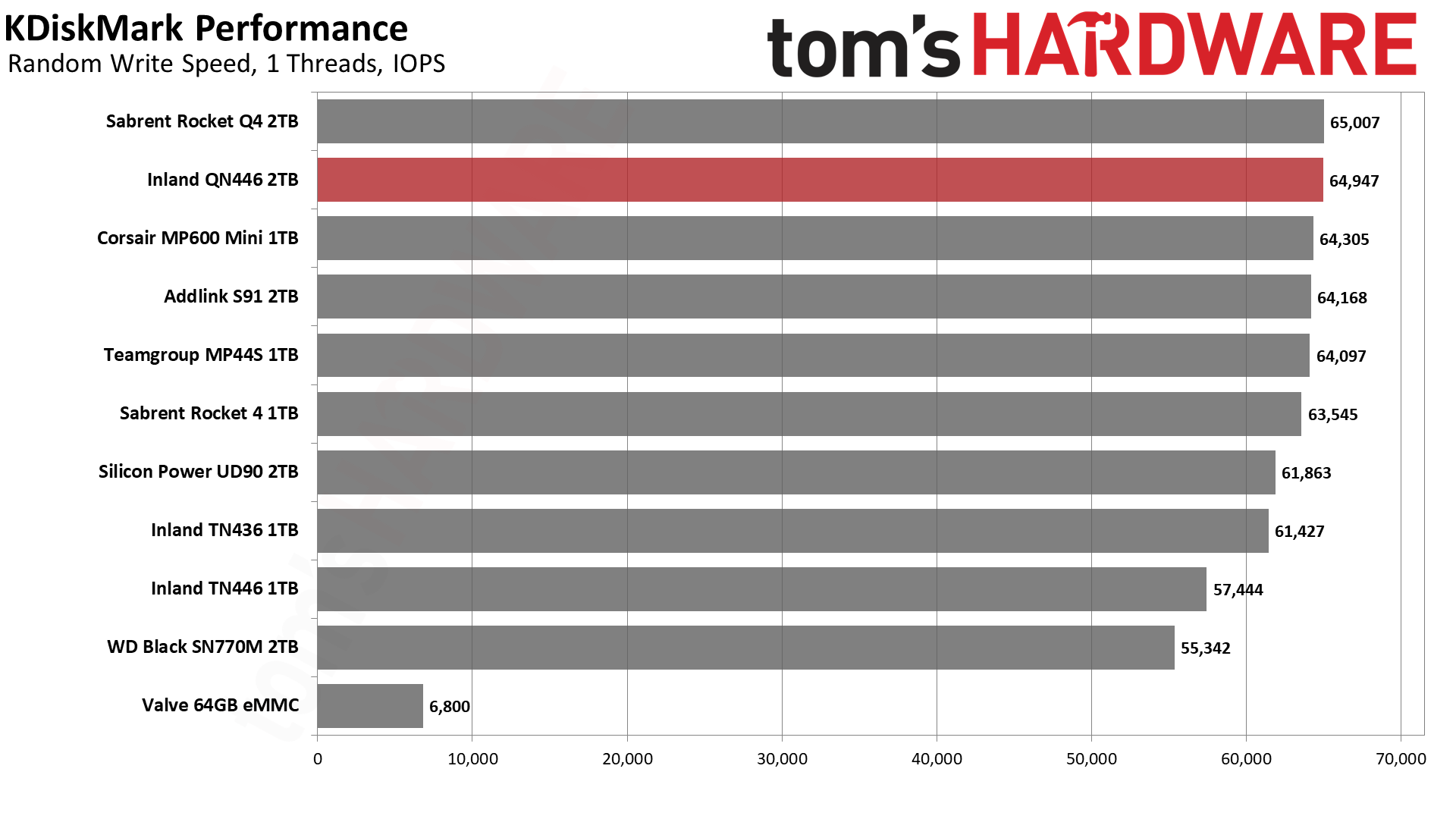
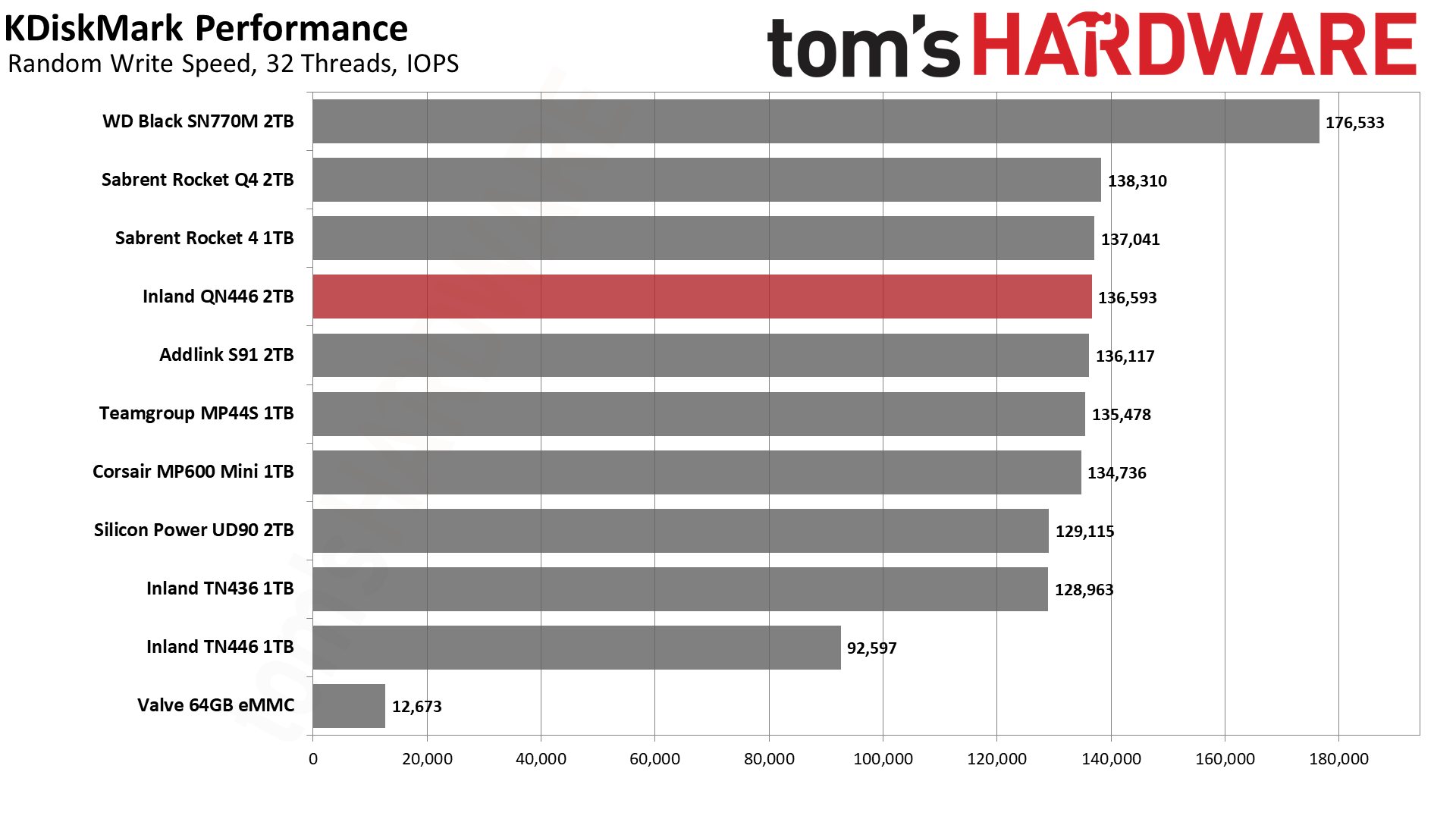
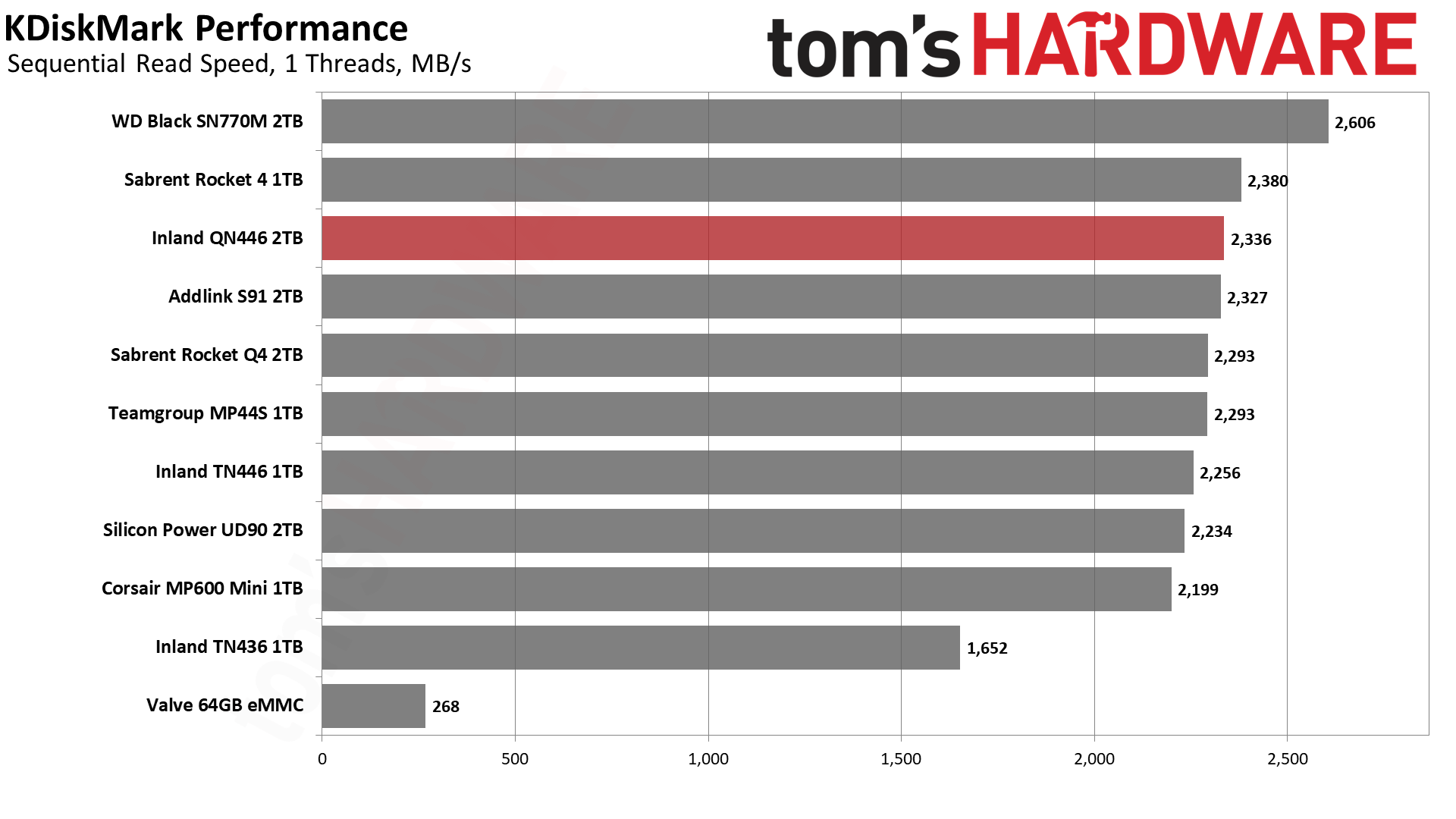
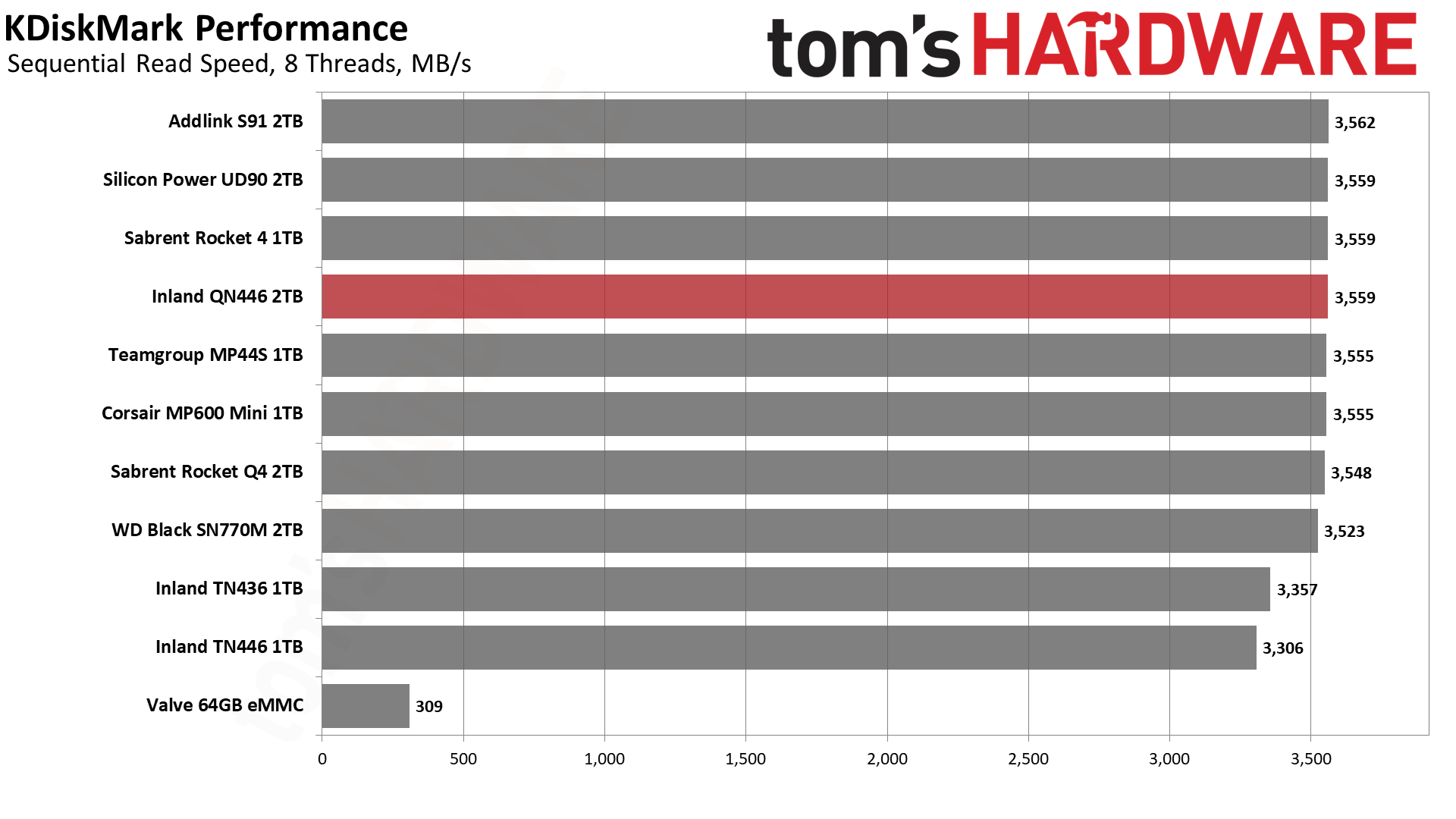
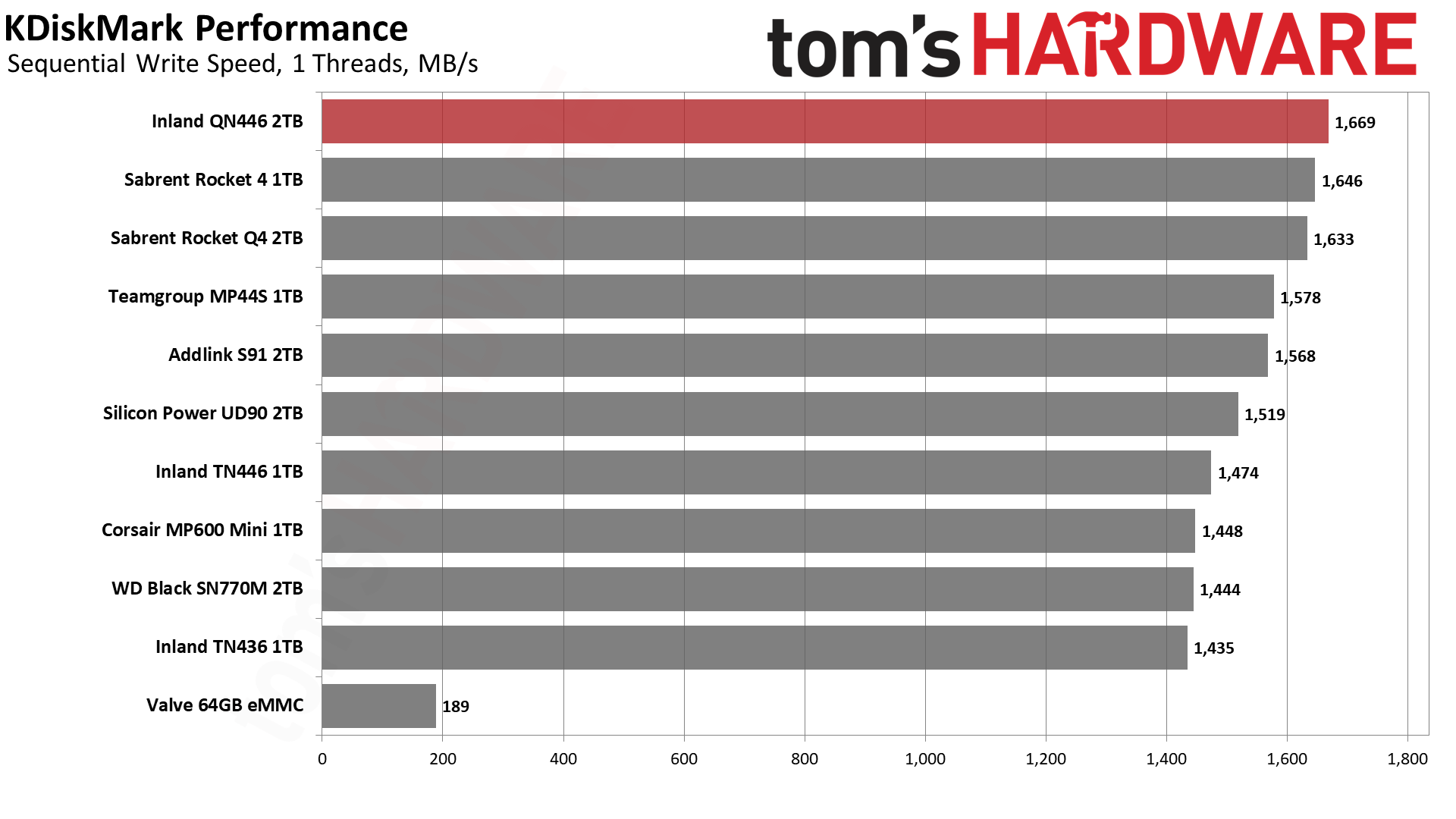
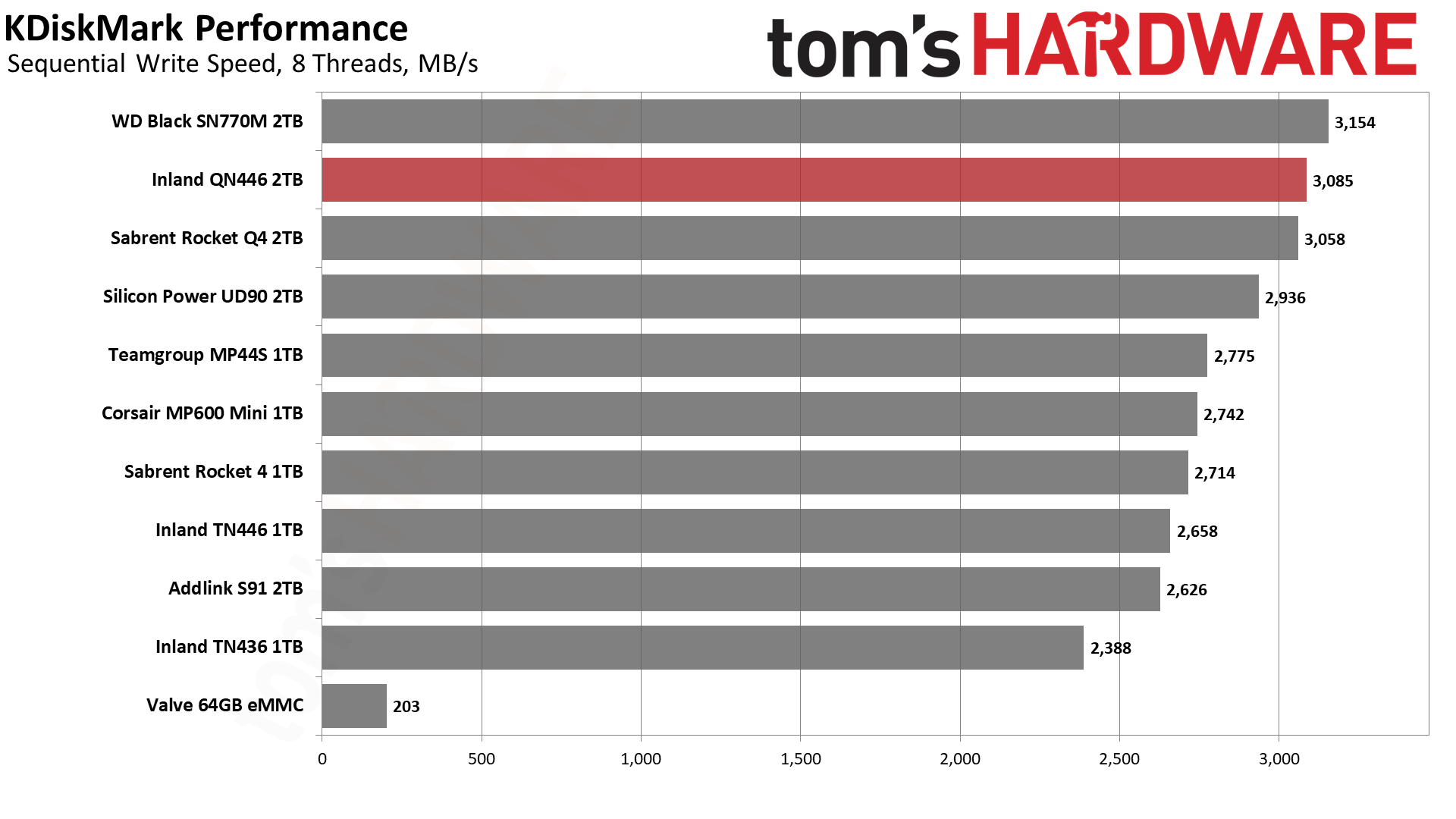
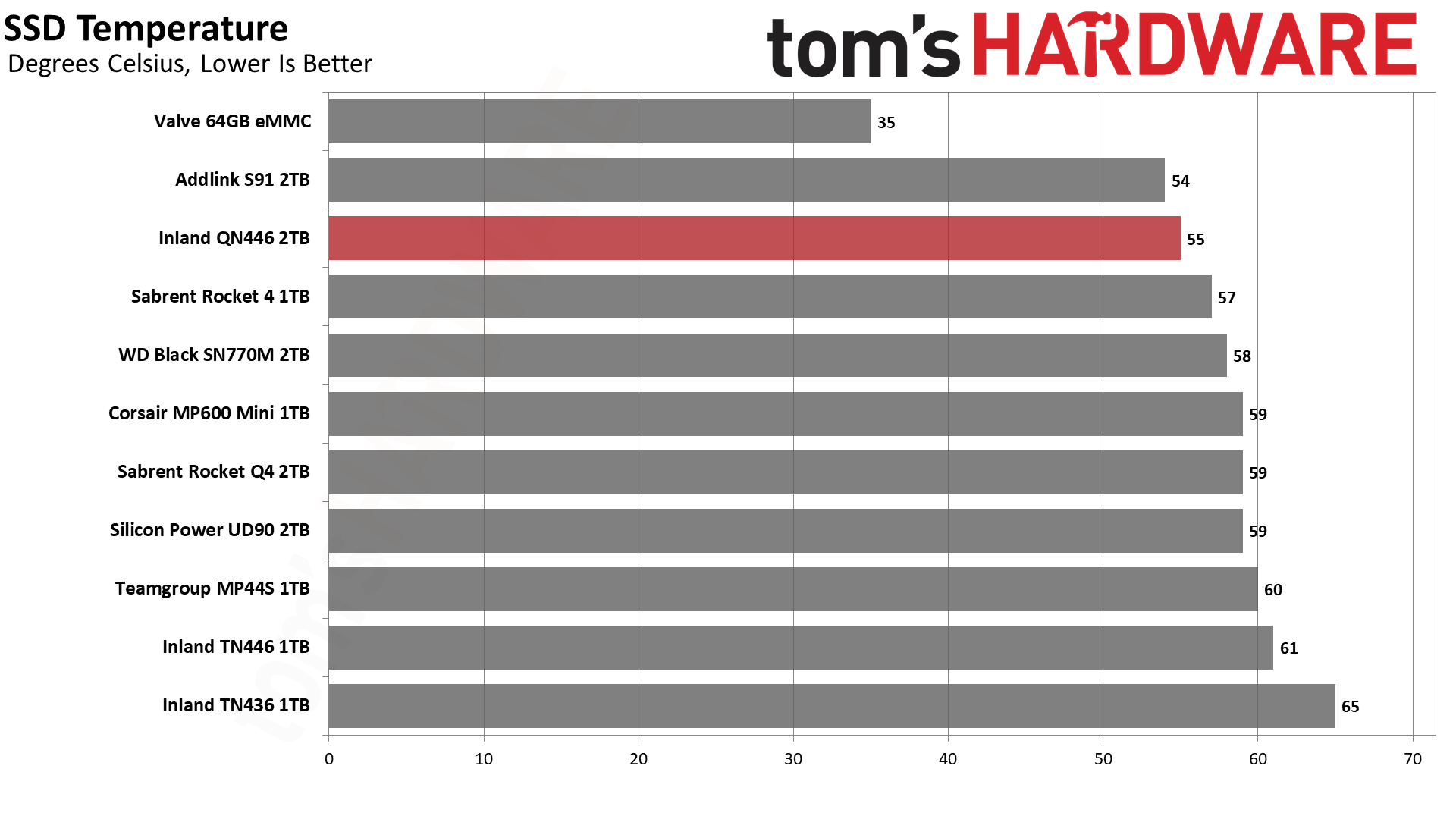
The QN446 gives good overall results from KDiskMark, and does it while running relatively cool. Gaming workloads will usually push the storage less than KDiskMark, but the adjacent heat from the APU will get the driver hotter.
We recommend any of the drives with Phison’s E21T controller, TLC or QLC, for the best overall experience. Future drives will open this discussion up a bit, and drive choice is still contingent on your particular host device. PCIe 4.0 devices can push the storage more but may also have better options for after-marketing cooling. Additionally, longer slots - which can work with M.2 2230 drives if there are offsets or with an extender - can open the door to 2280 drives that have greater surface area.
Get Tom's Hardware's best news and in-depth reviews, straight to your inbox.
PC Trace Testing - 3DMark Storage Benchmark
Built for gamers, 3DMark’s Storage Benchmark focuses on real-world gaming performance. Each round in this benchmark stresses storage based on gaming activities including loading games, saving progress, installing game files, and recording gameplay video streams.
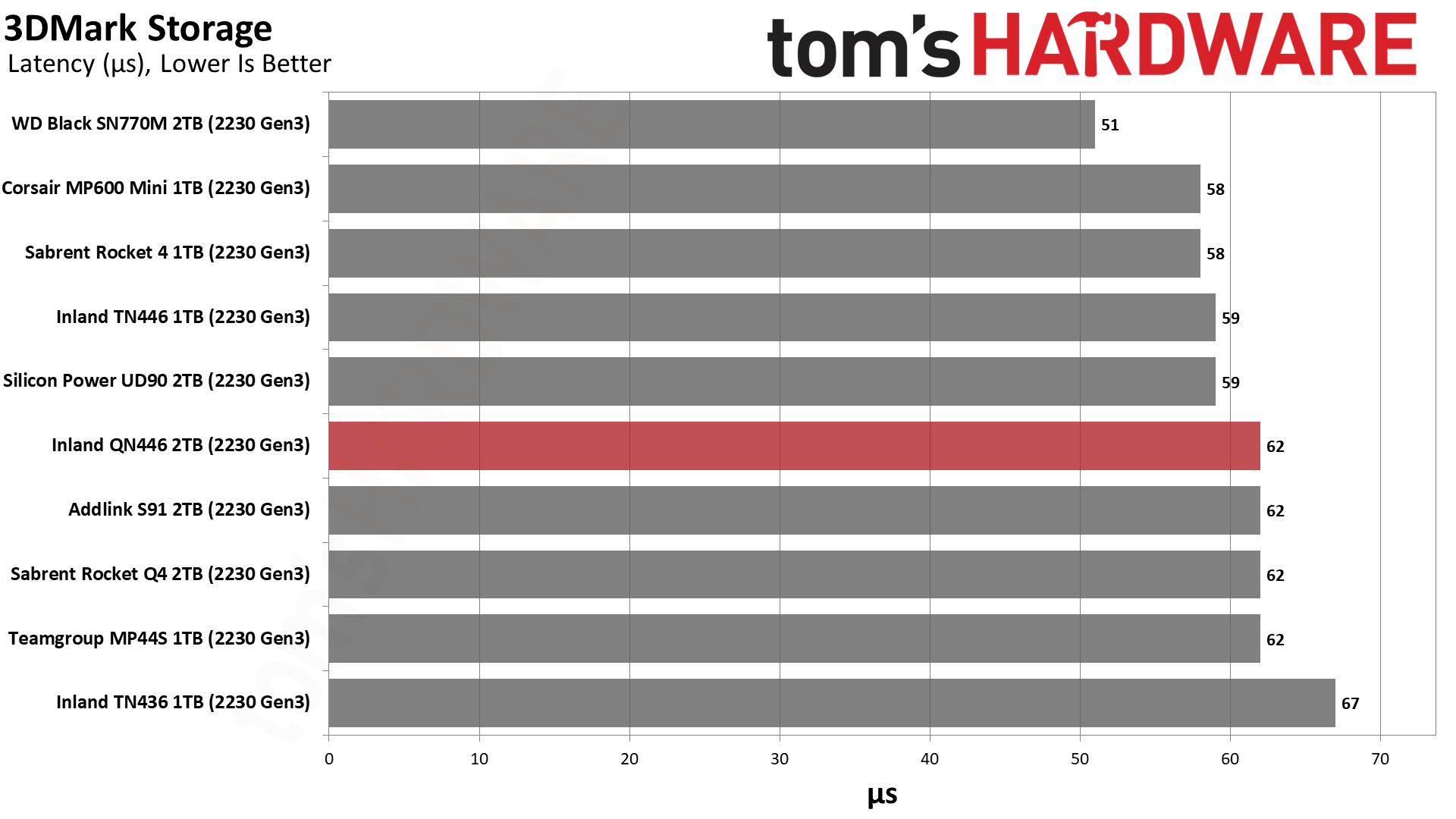
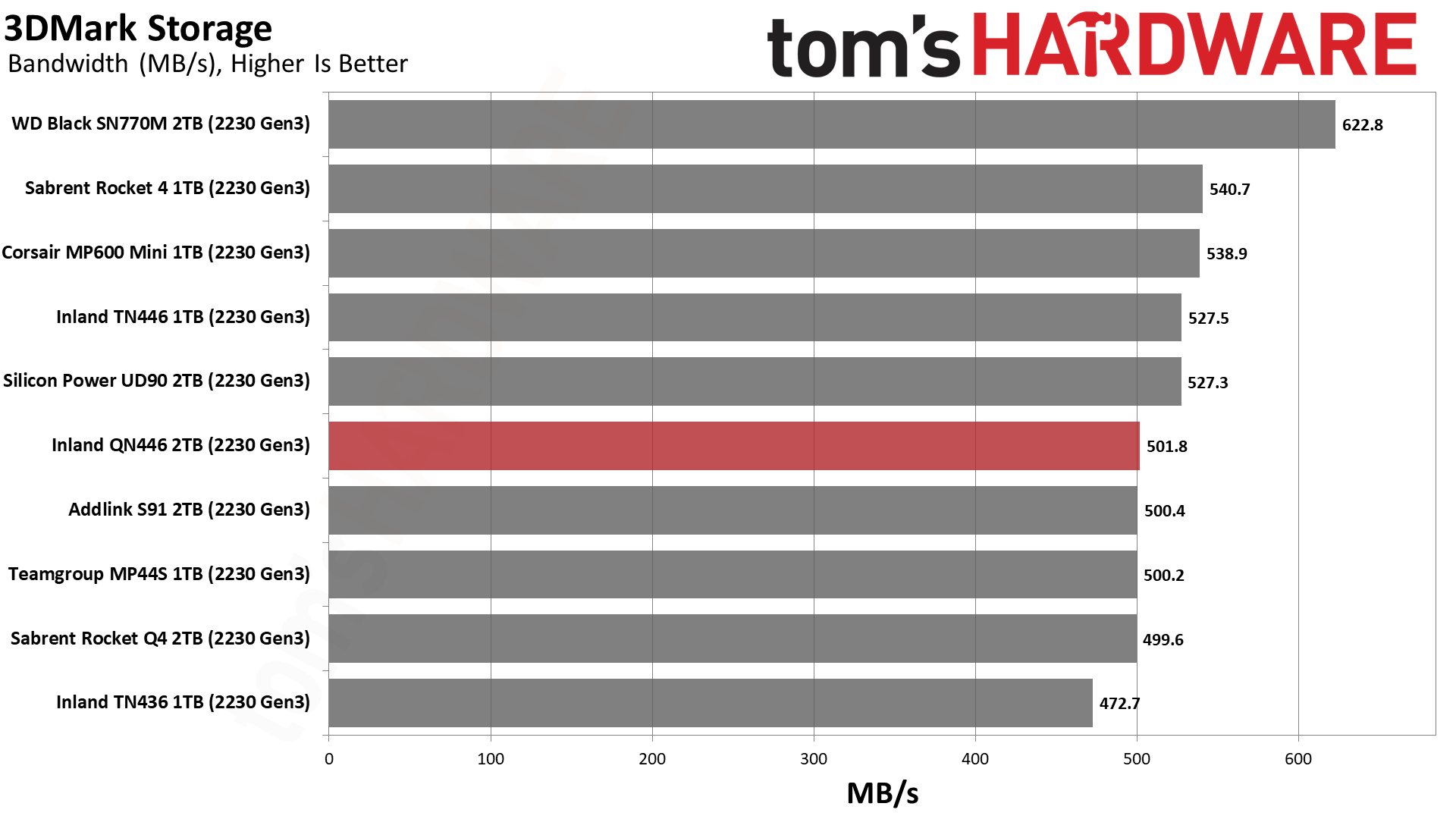
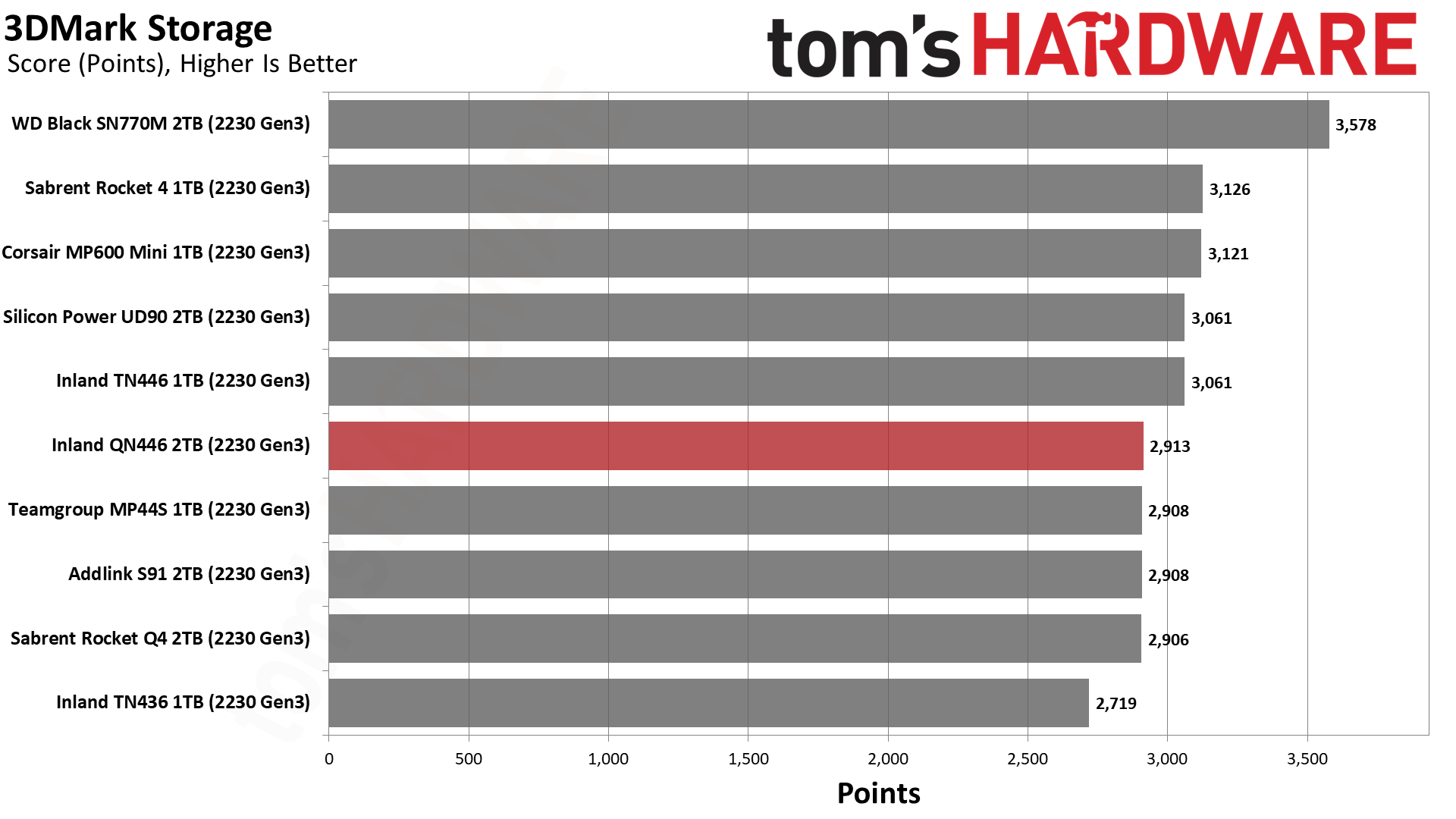
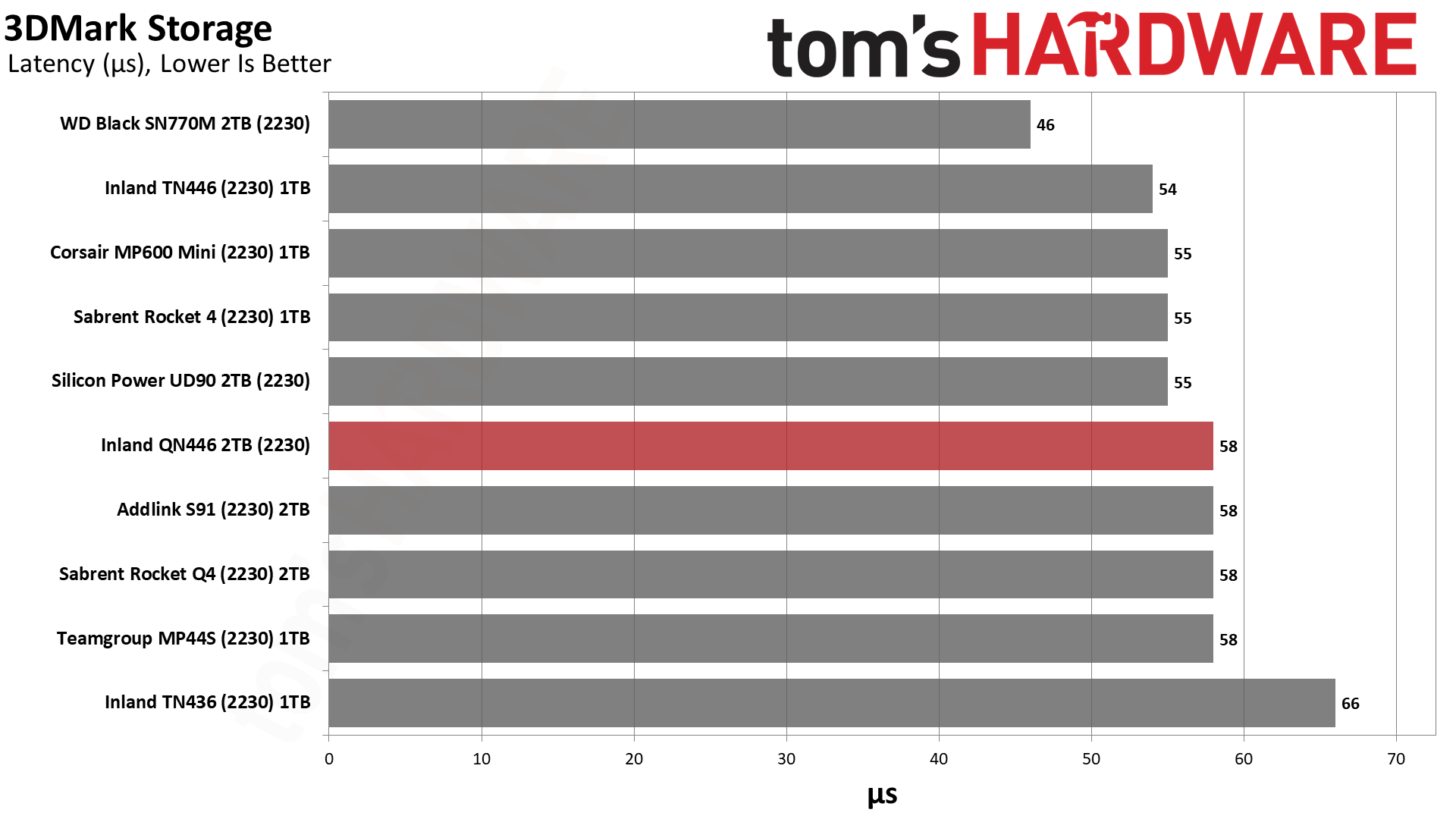

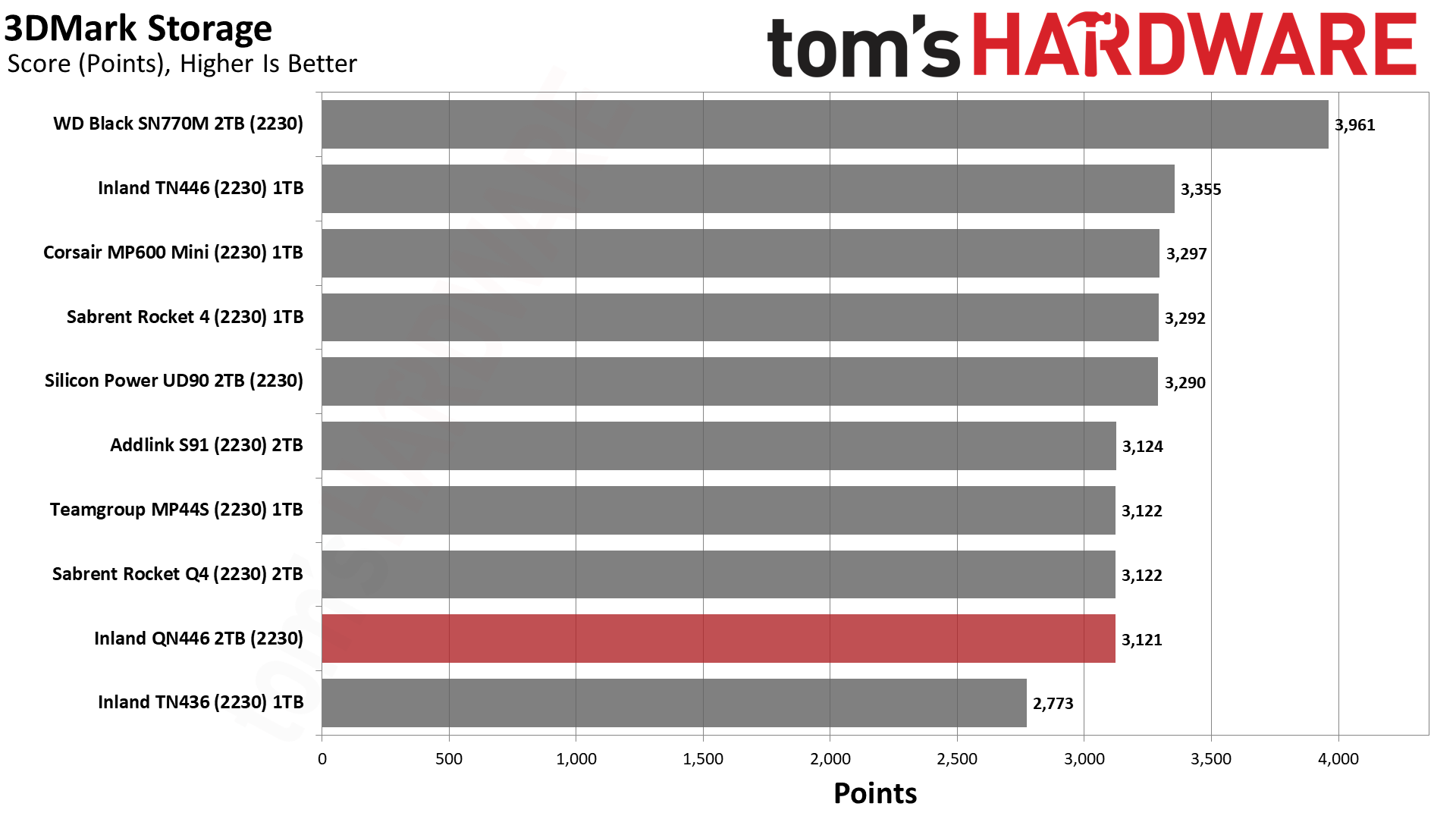
The QN446 is merely average in 3DMark in PCIe 3.0 mode and below average in PCIe 4.0. We think QLC works just fine for the Deck as its M.2 slot only supports a PCIe 3.0 SSD link speed. The 3DMark performance gap at PCIe 4.0 isn’t particularly large, either. The only real standouts are the SN770M, which is very fast, and the TN436, which is significantly slower.
PC Trace Testing – PCMark 10 Storage Benchmark
PCMark 10 is a trace-based benchmark that uses a wide-ranging set of real-world traces from popular applications and everyday tasks to measure the performance of storage devices.
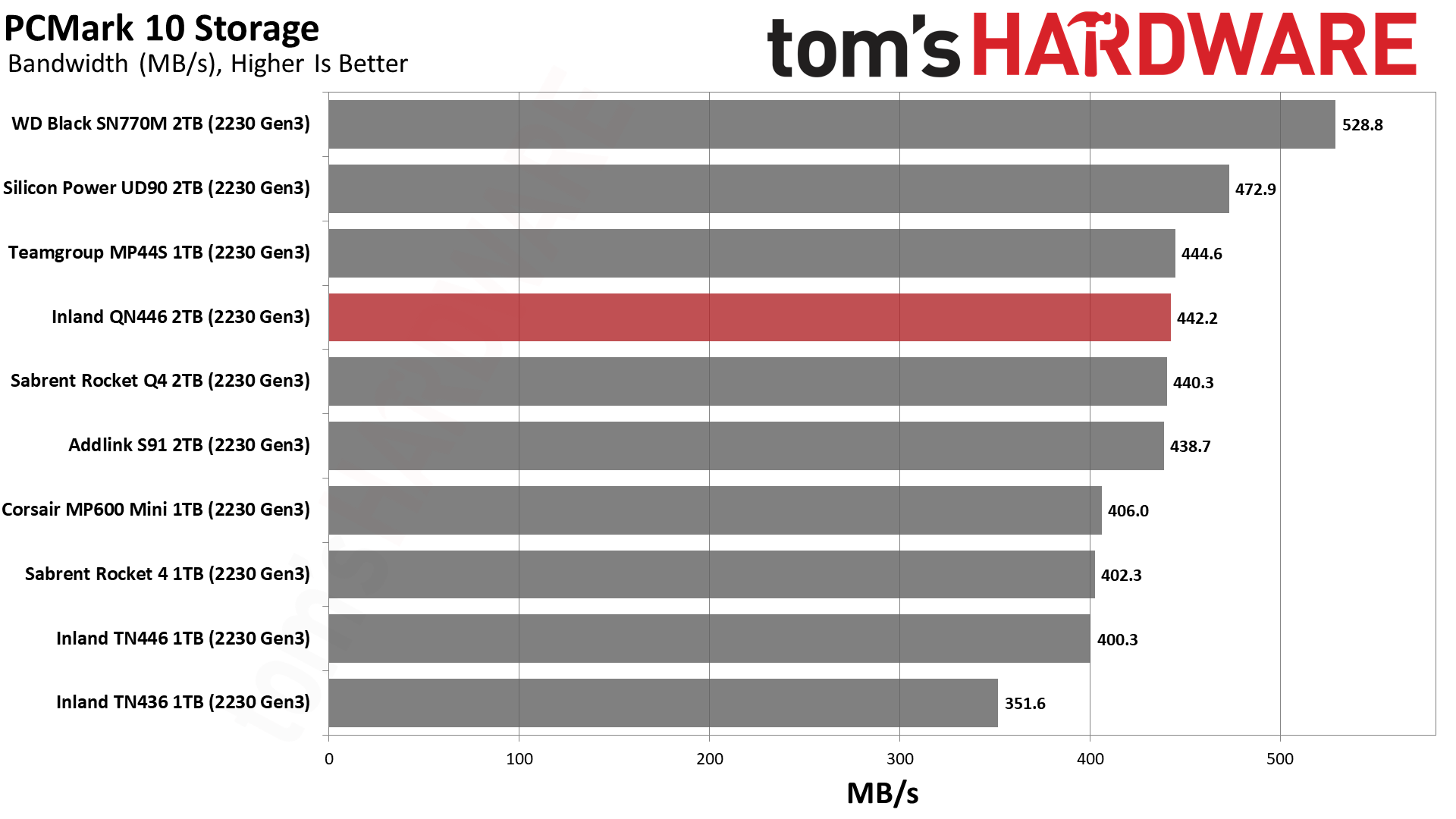
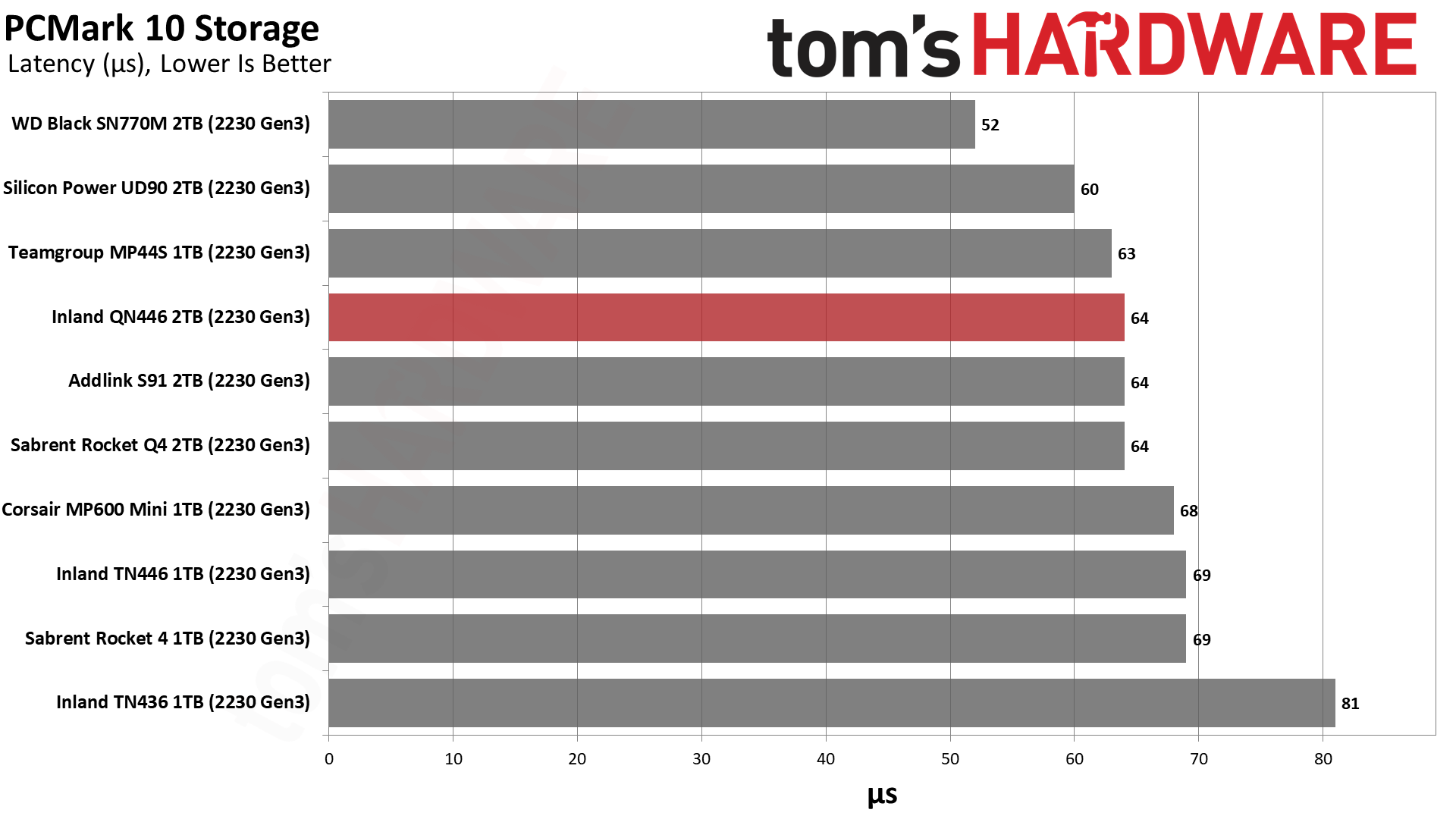
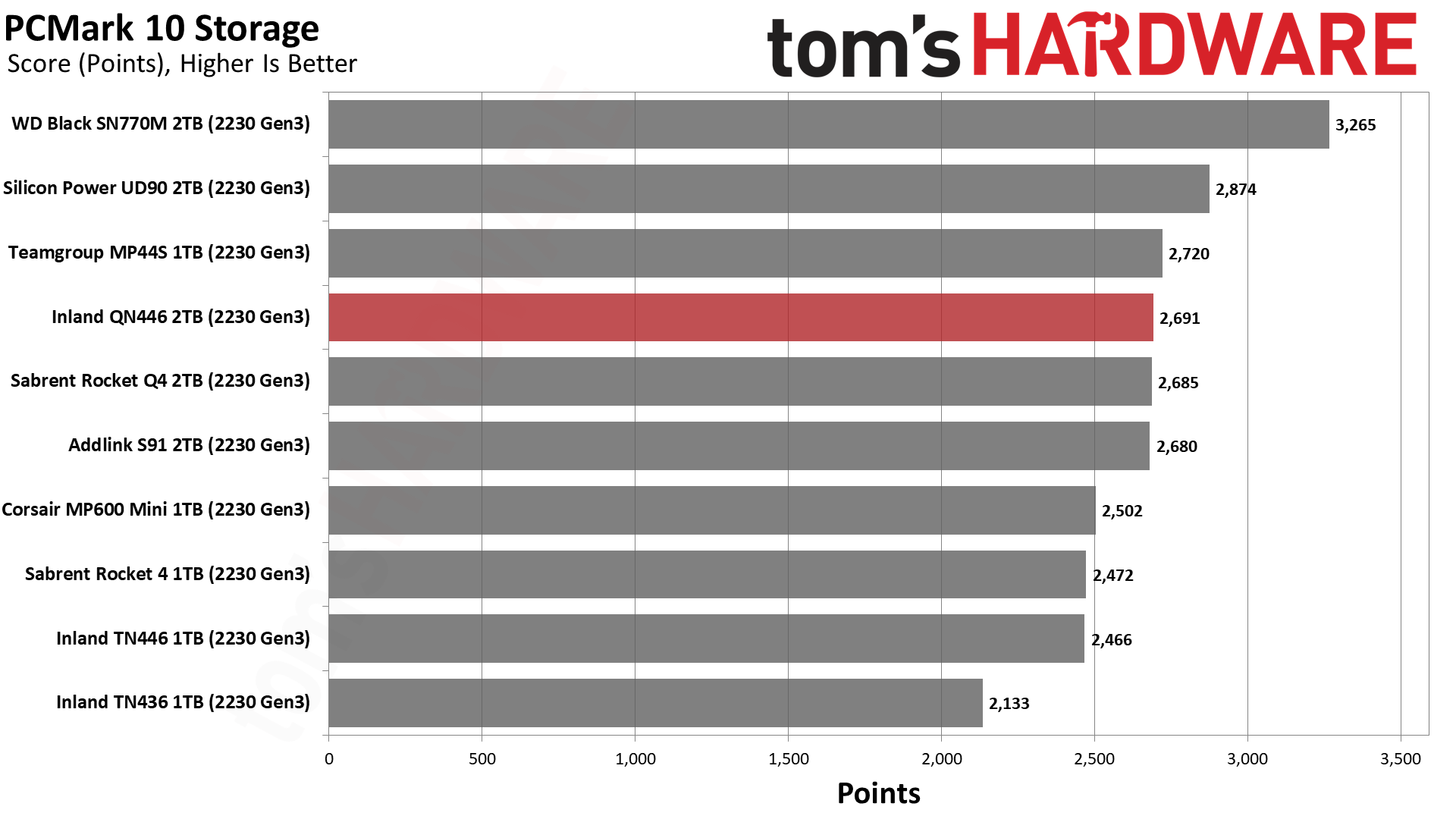
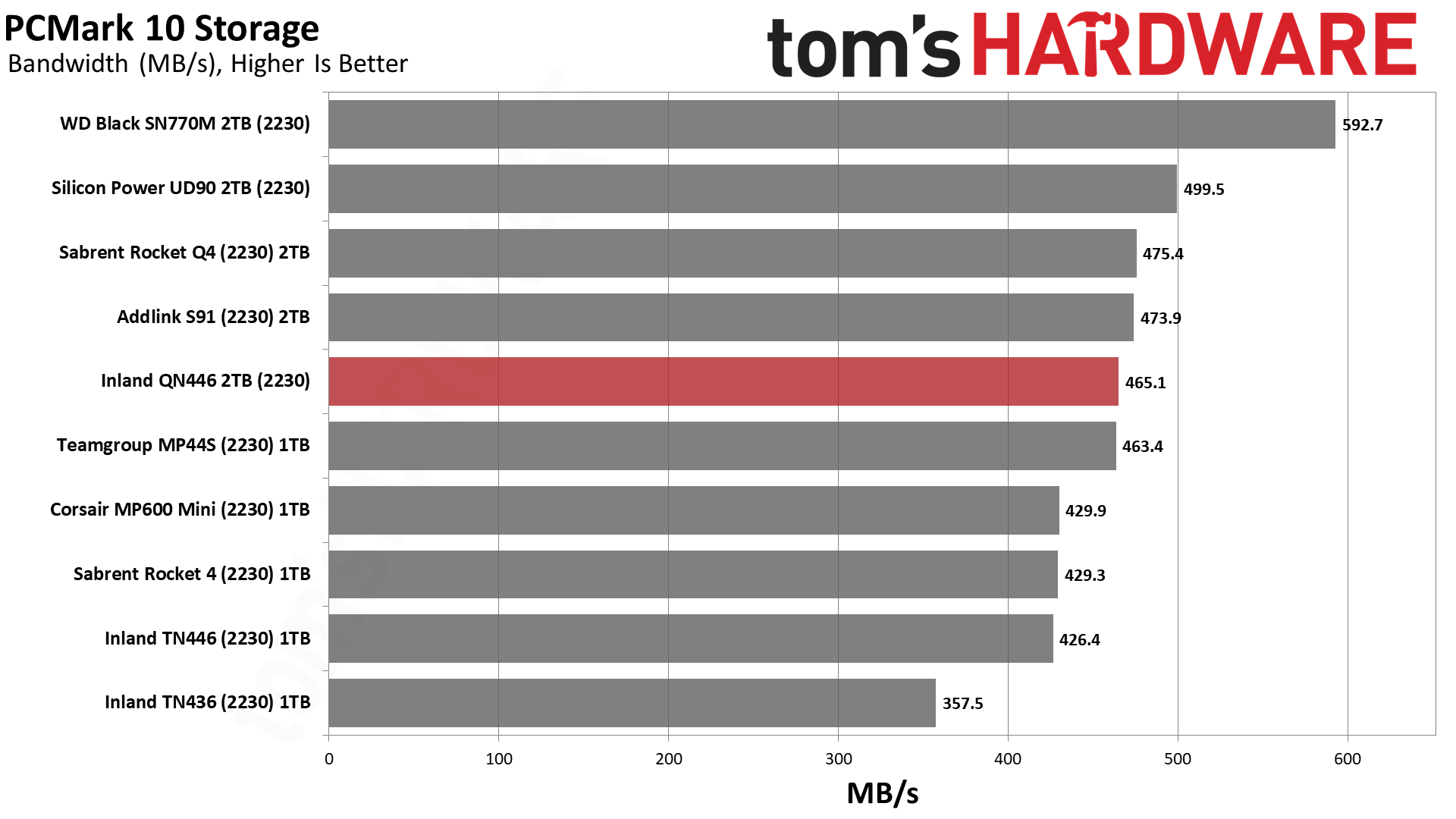
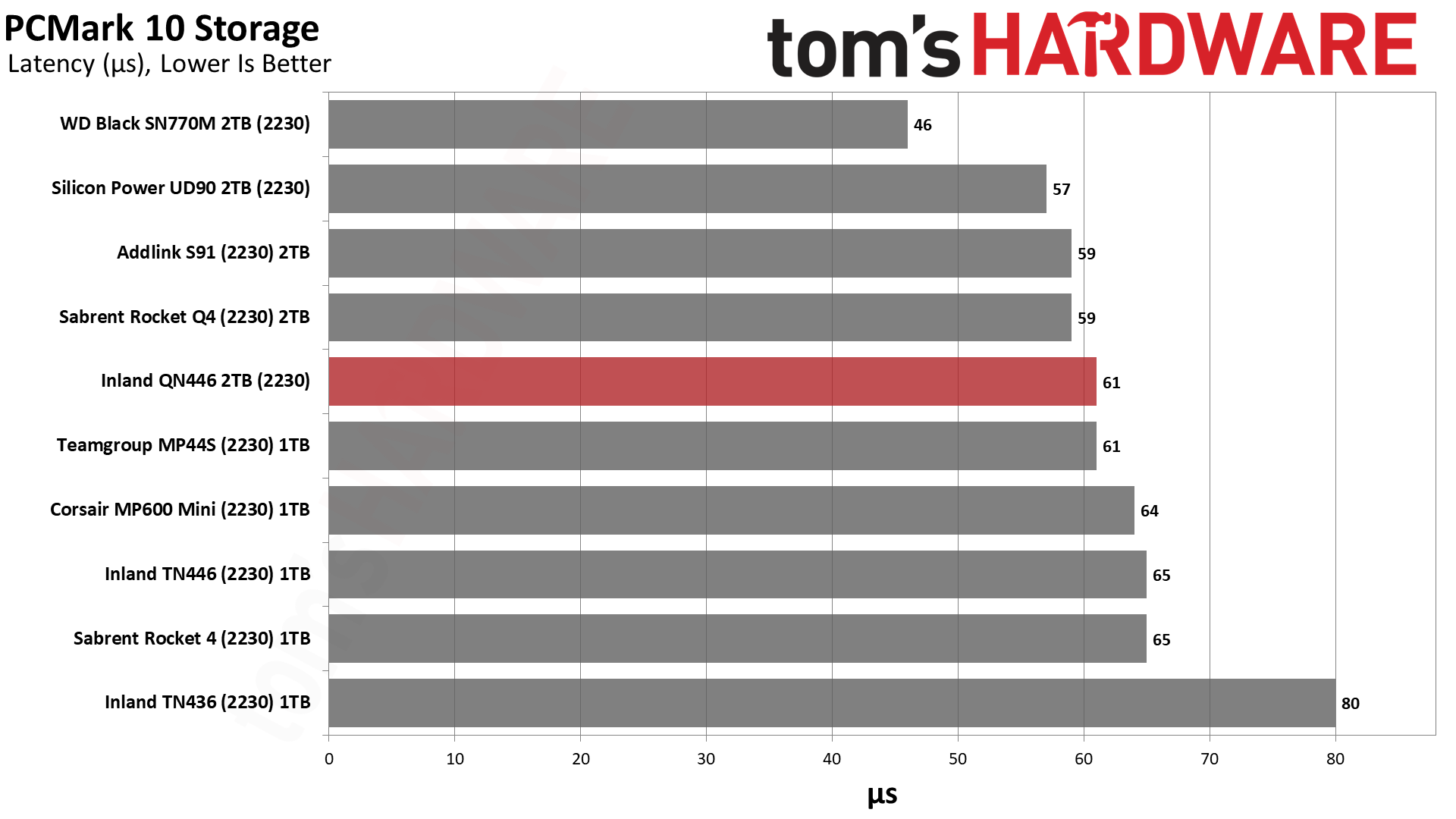
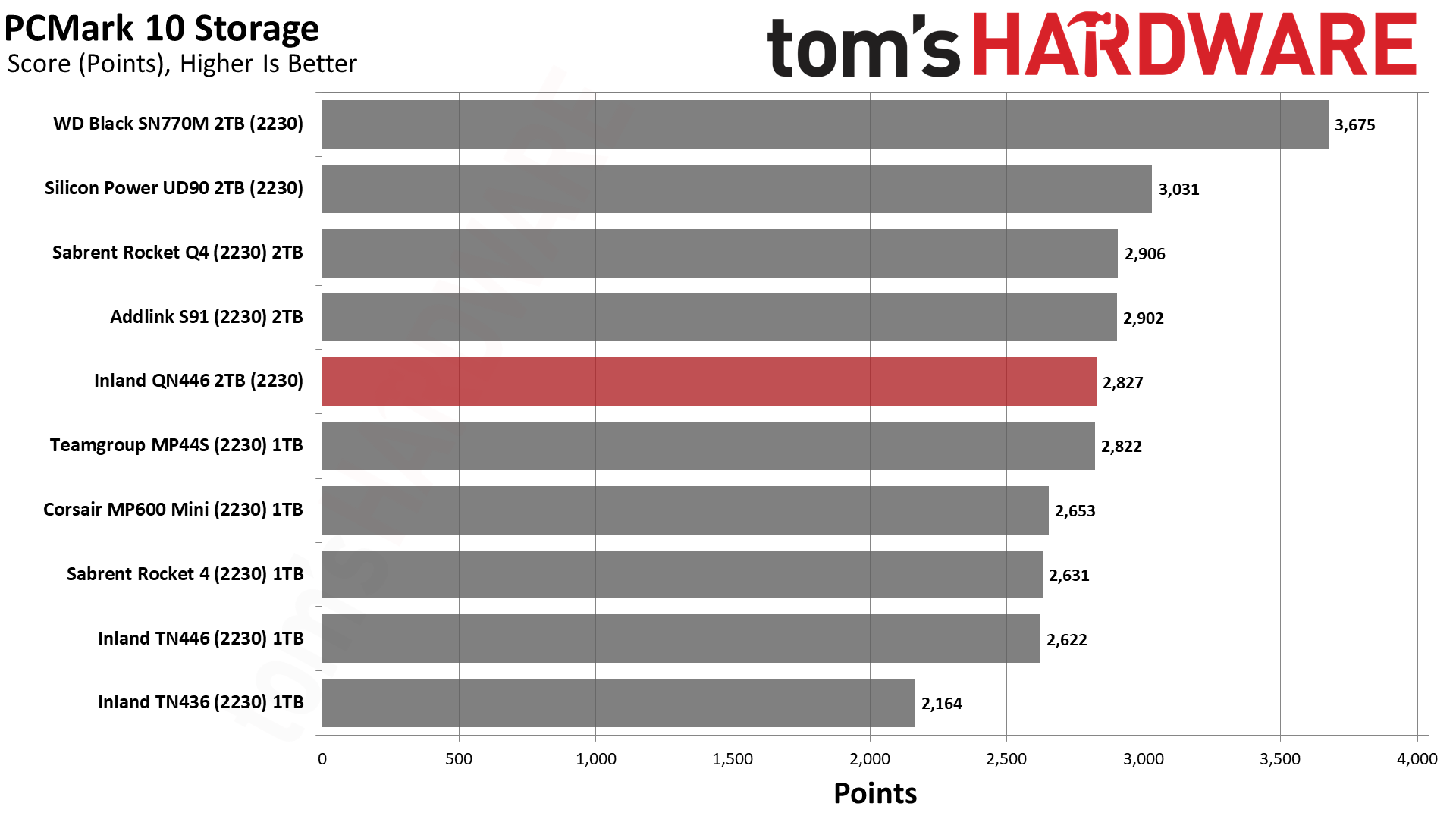
The QN446 is average on the whole in PCMark 10 when considering both PCIe 3.0 and PCIe 4.0 modes. You will get a satisfactory experience out of the QN446 in either case. Otherwise, the SN770M remains on top, and the TN436 remains at the bottom.
PC Transfer Rates – DiskBench
We use the DiskBench storage benchmarking tool to test file transfer performance with a custom, 50GB dataset. We copy 31,227 files of various types, such as pictures, PDFs, and videos to a new folder and then follow-up with a reading test of a newly-written 6.5GB zip file.
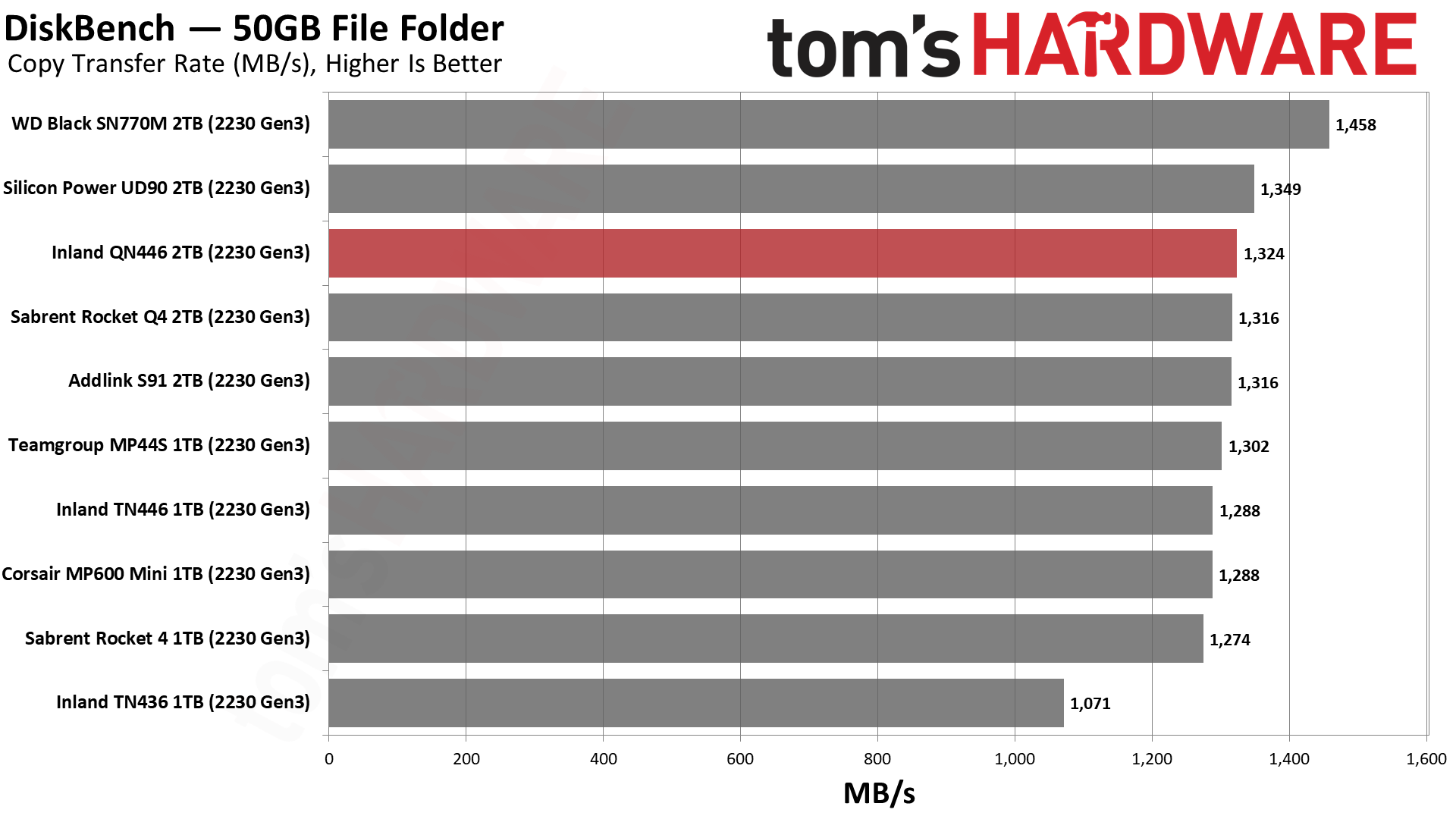
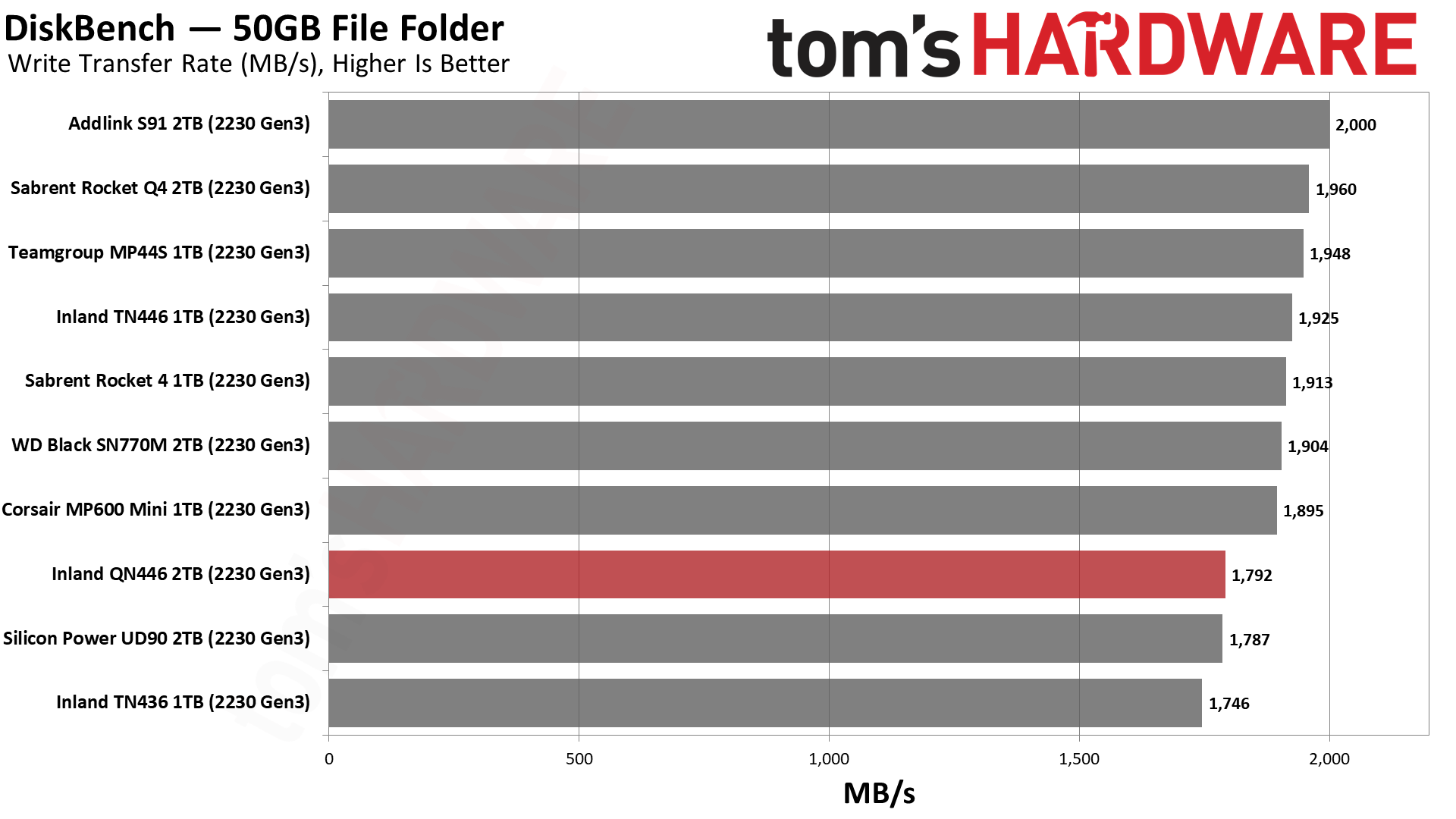
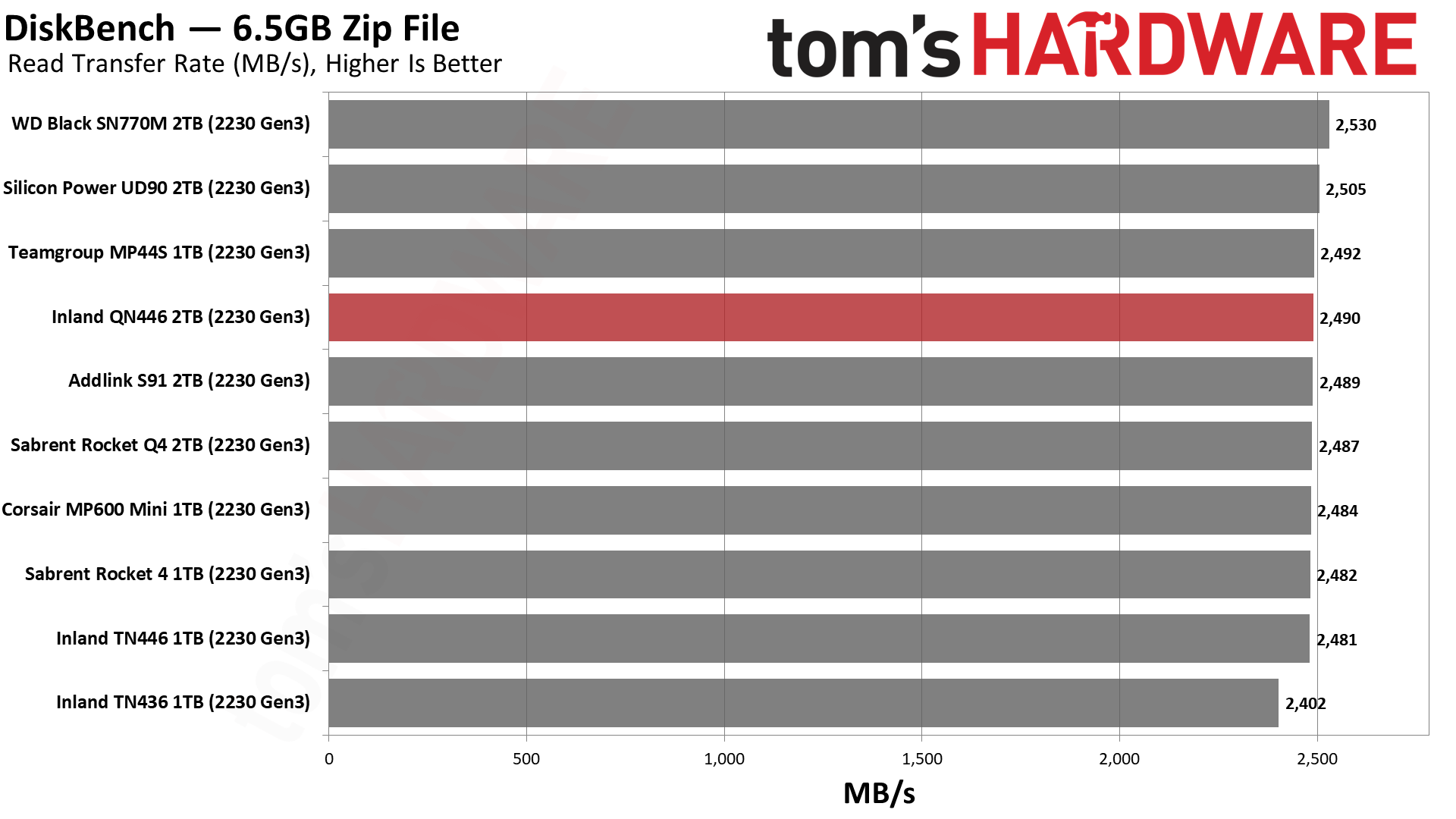
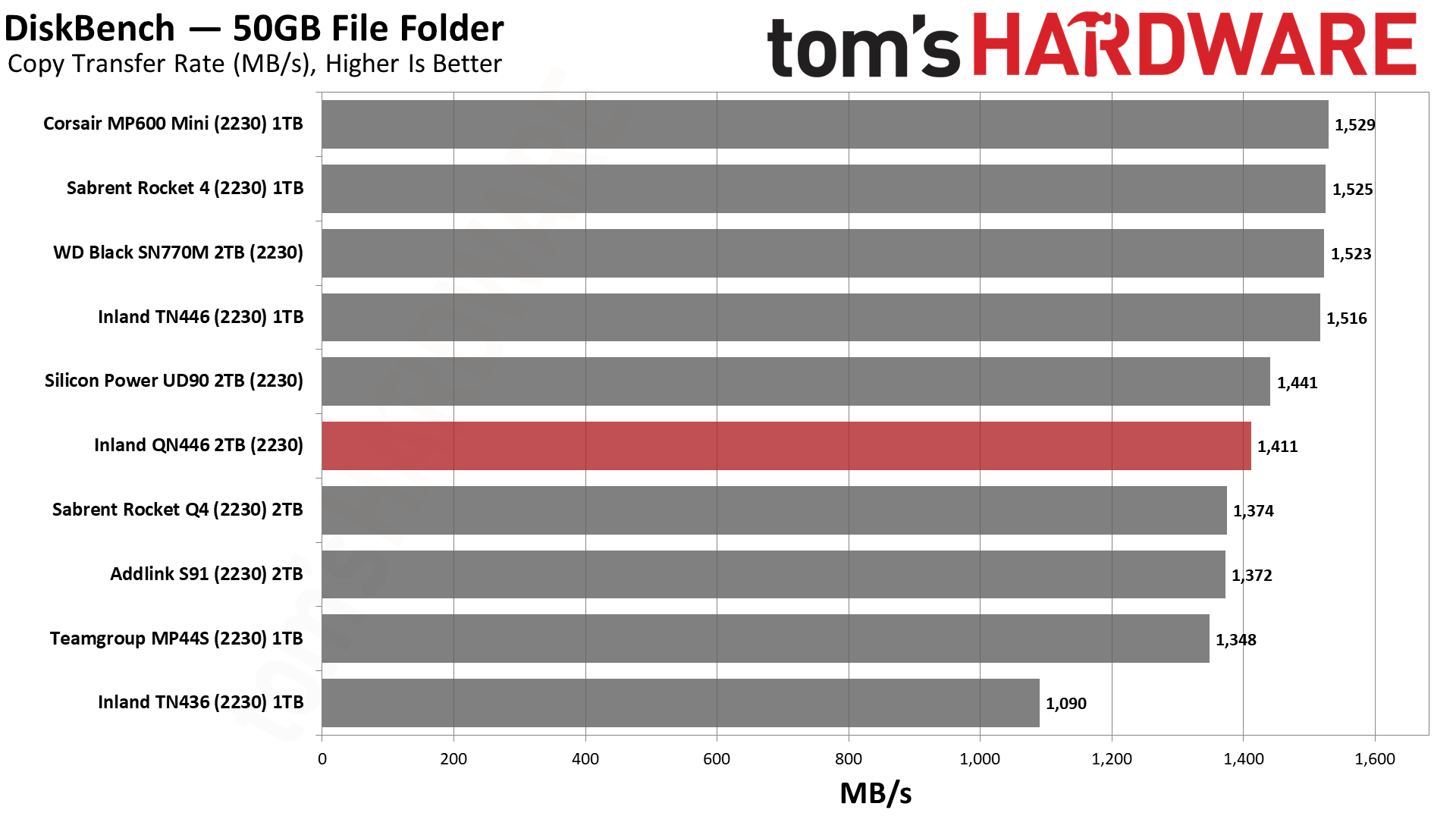
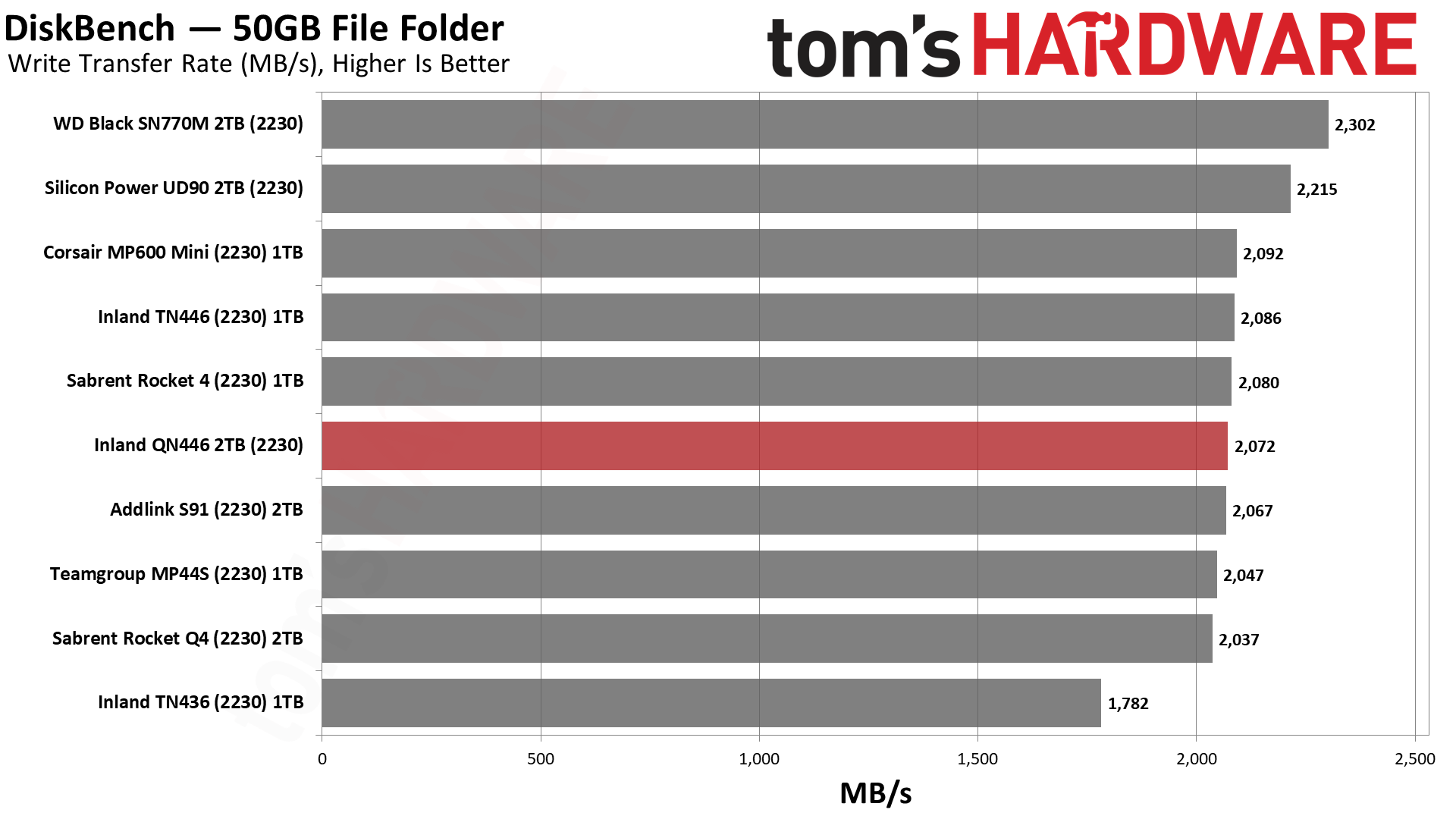
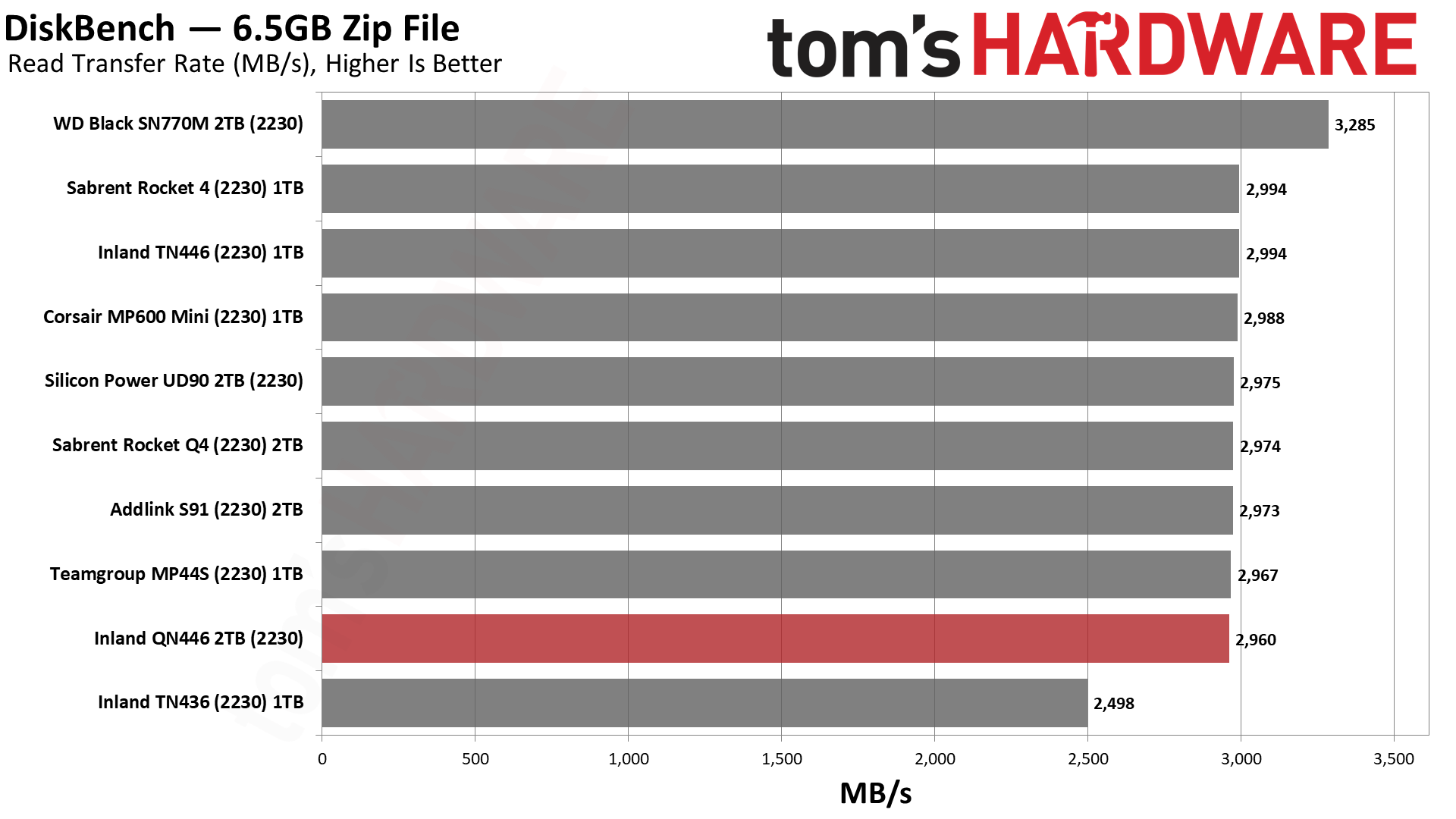
The copy transfer rate shows that the QN446 doesn’t do too bad in either PCIe mode. It’s more comfortable at PCIe 3.0 with no practical loss versus the 1TB TLC alternatives, but even the gap at PCIe 4.0 is relatively small. Prolonged transfers and/or transfers when the drive is fuller may see worse performance, however.
PC Synthetic Testing - ATTO / CrystalDiskMark
ATTO and CrystalDiskMark (CDM) are free and easy-to-use storage benchmarking tools that SSD vendors commonly use to assign performance specifications to their products. Both of these tools give us insight into how each device handles different file sizes.
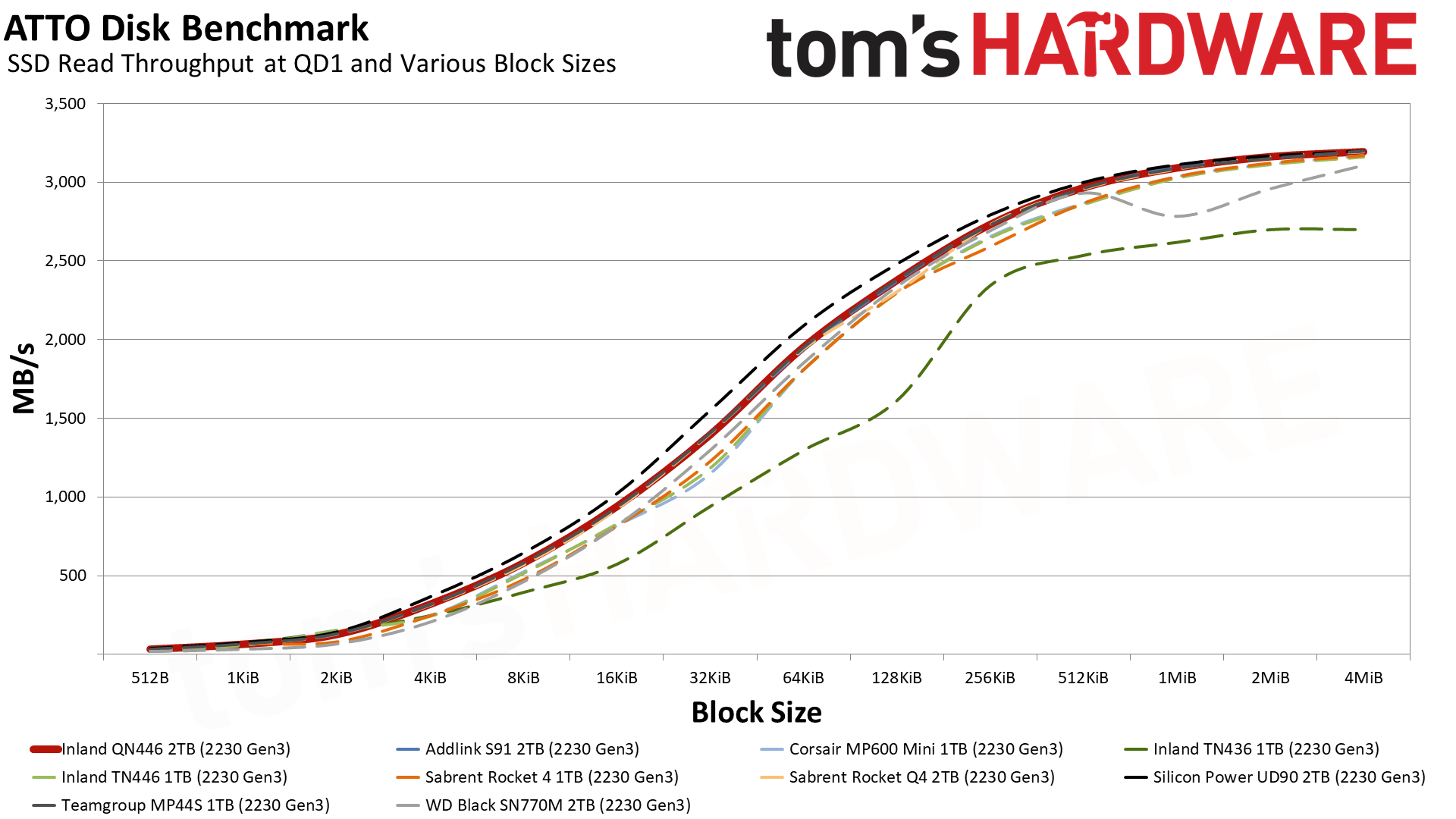
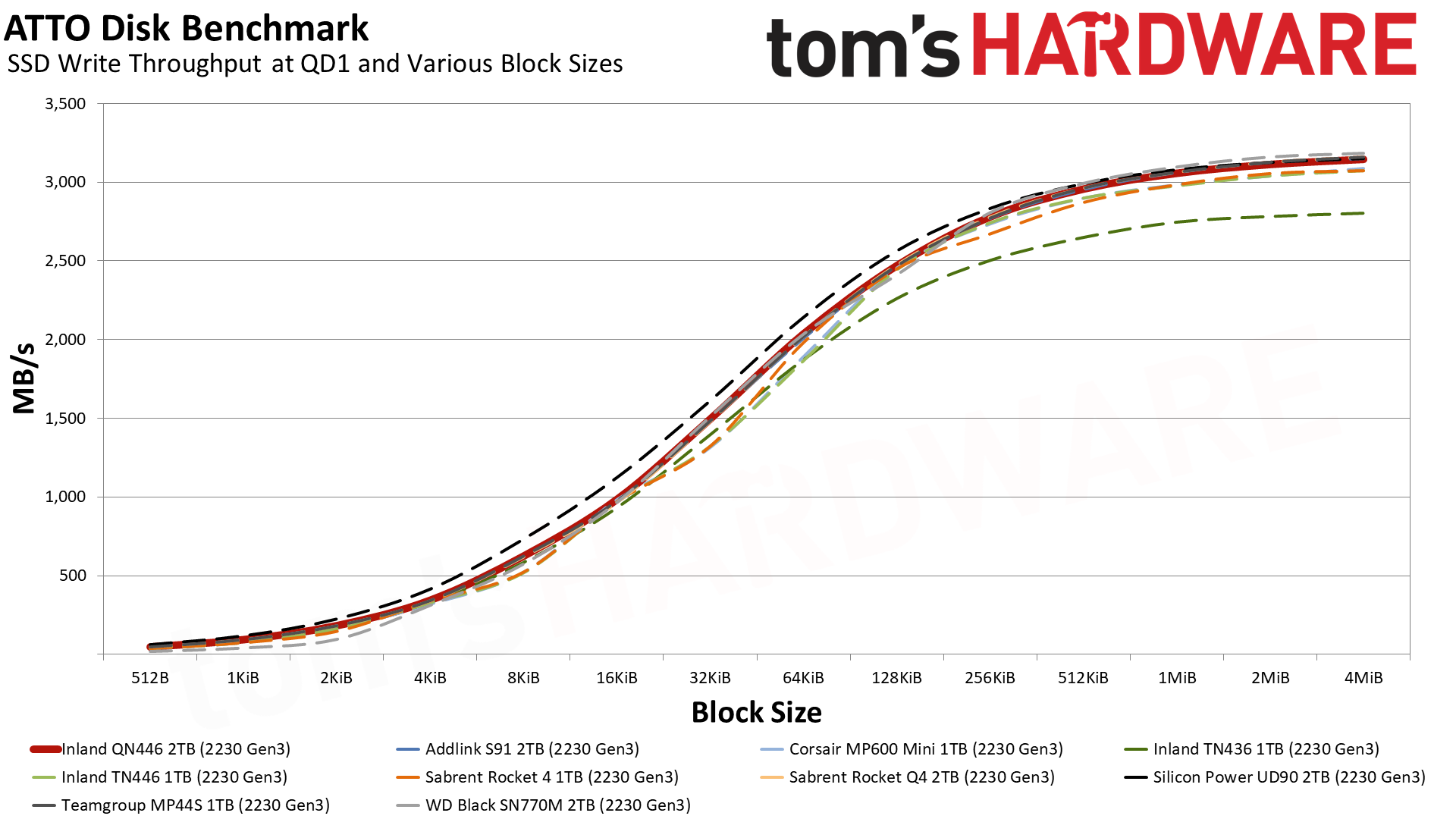
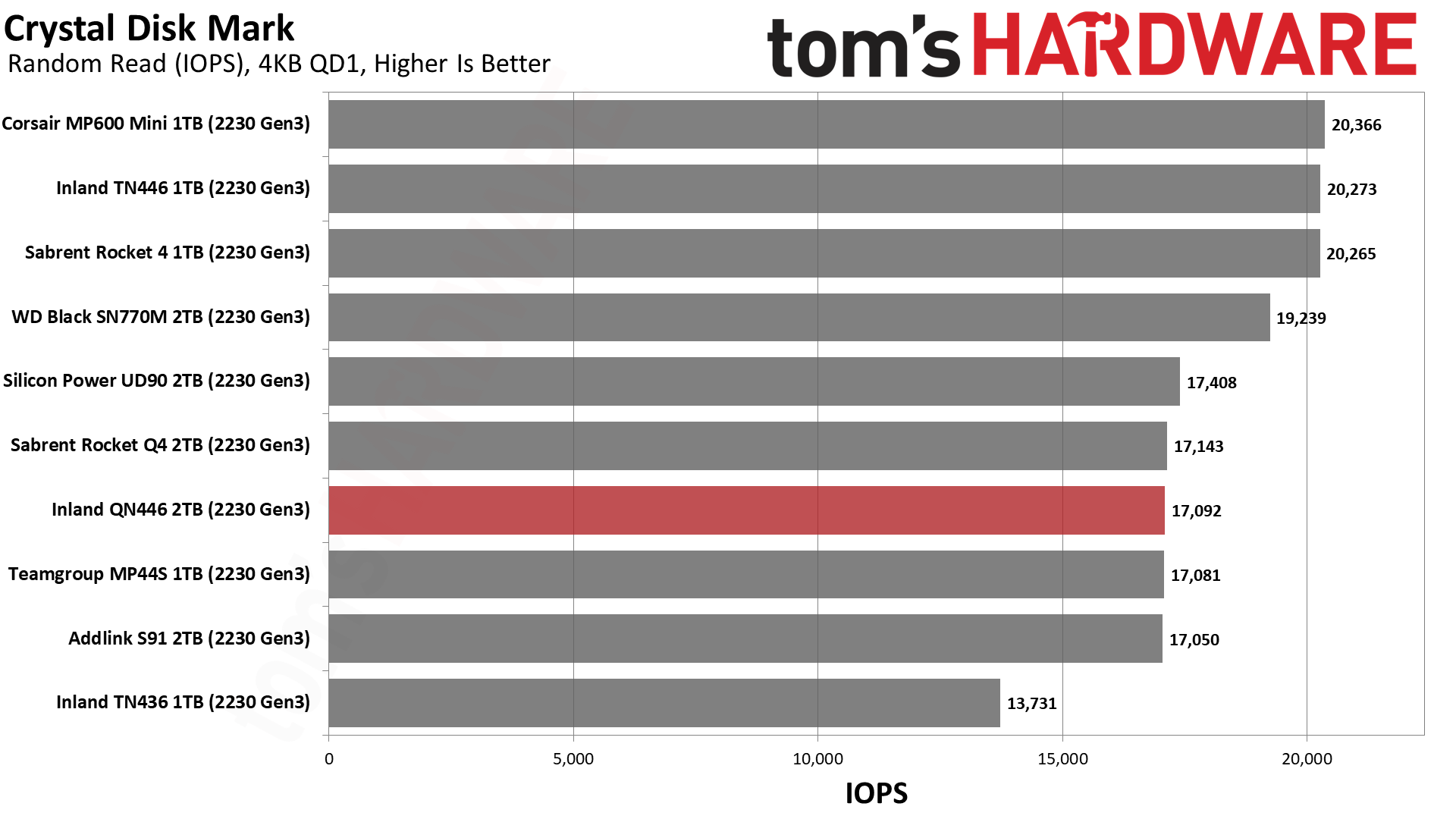
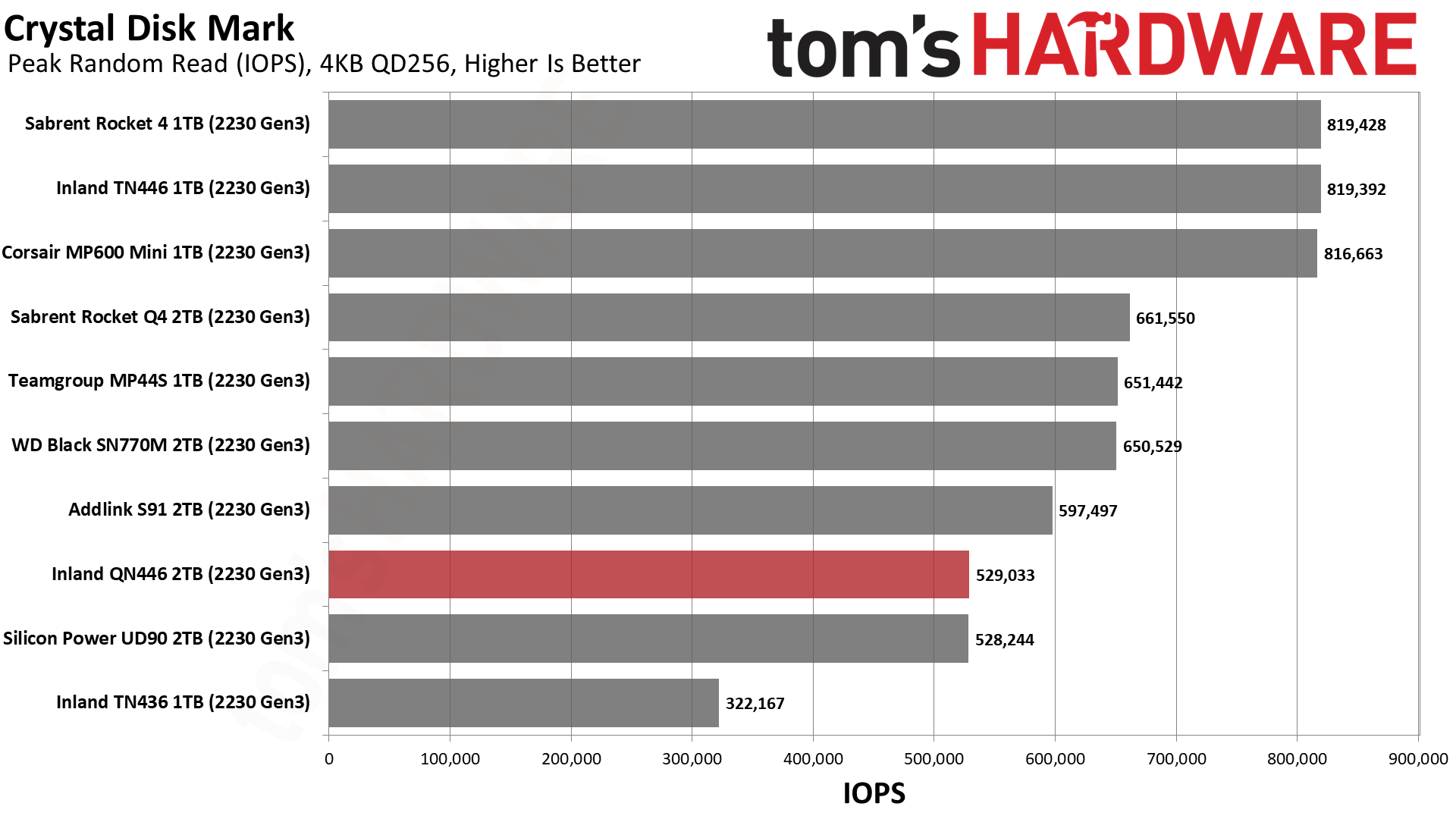
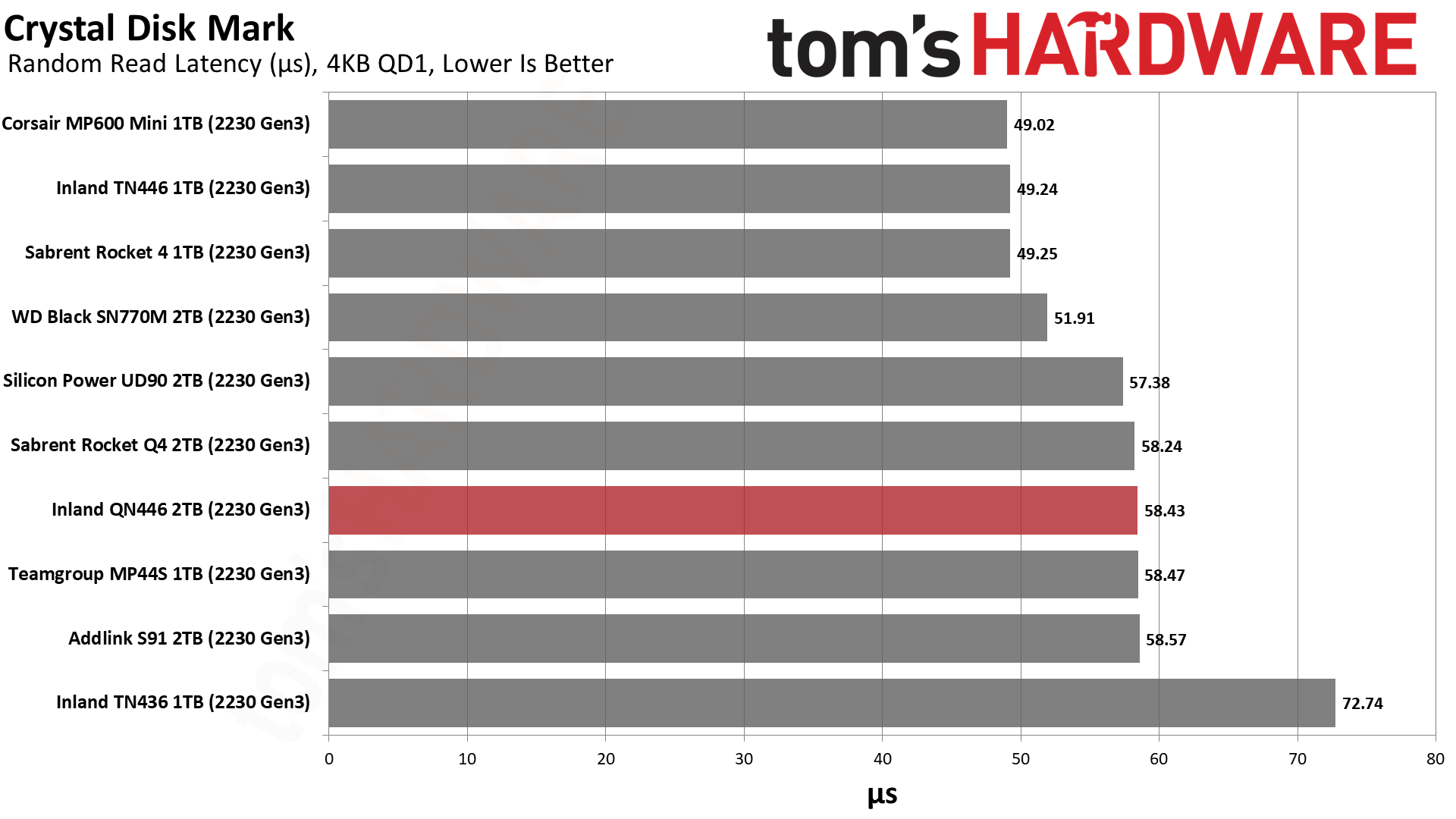
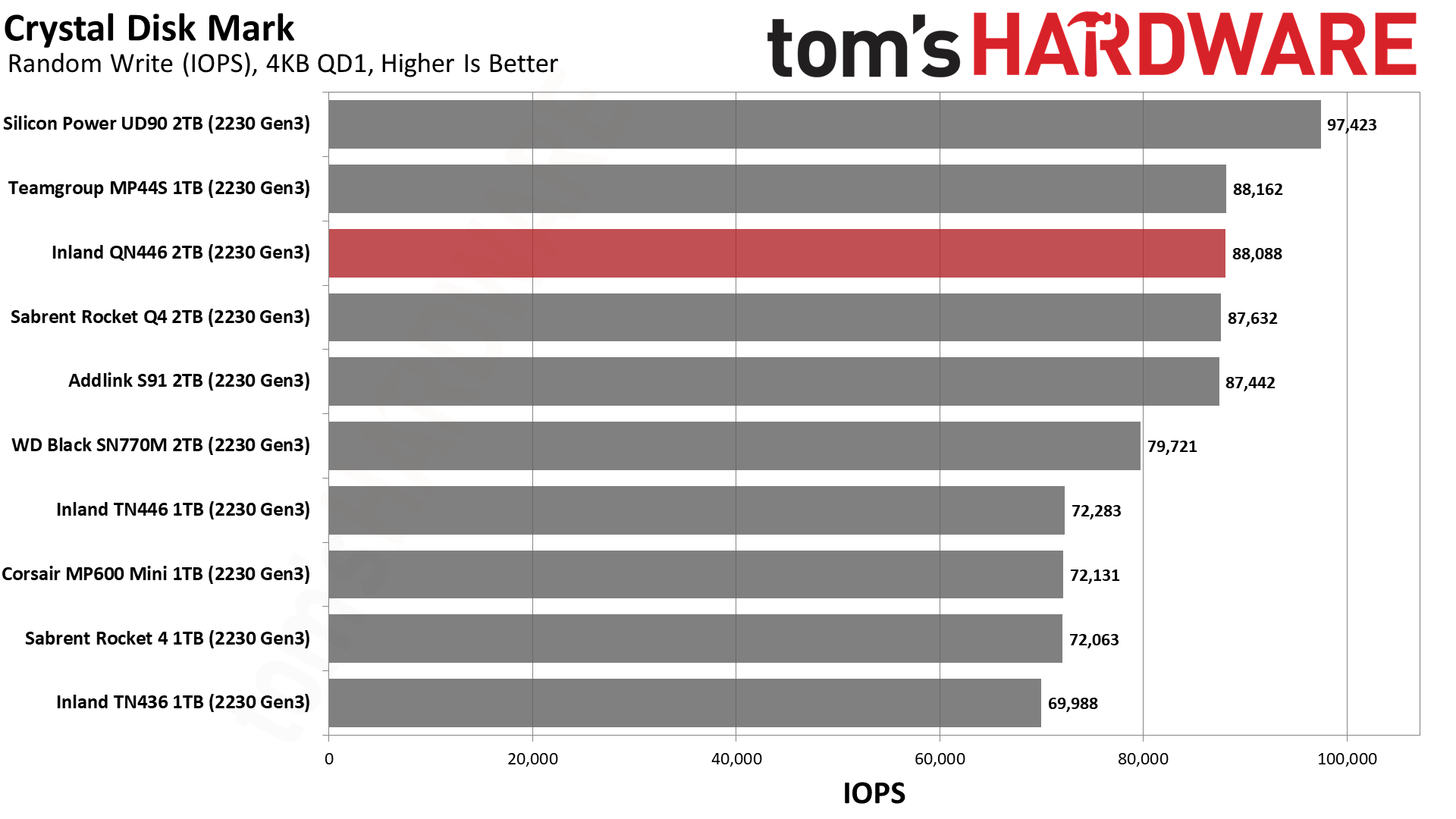
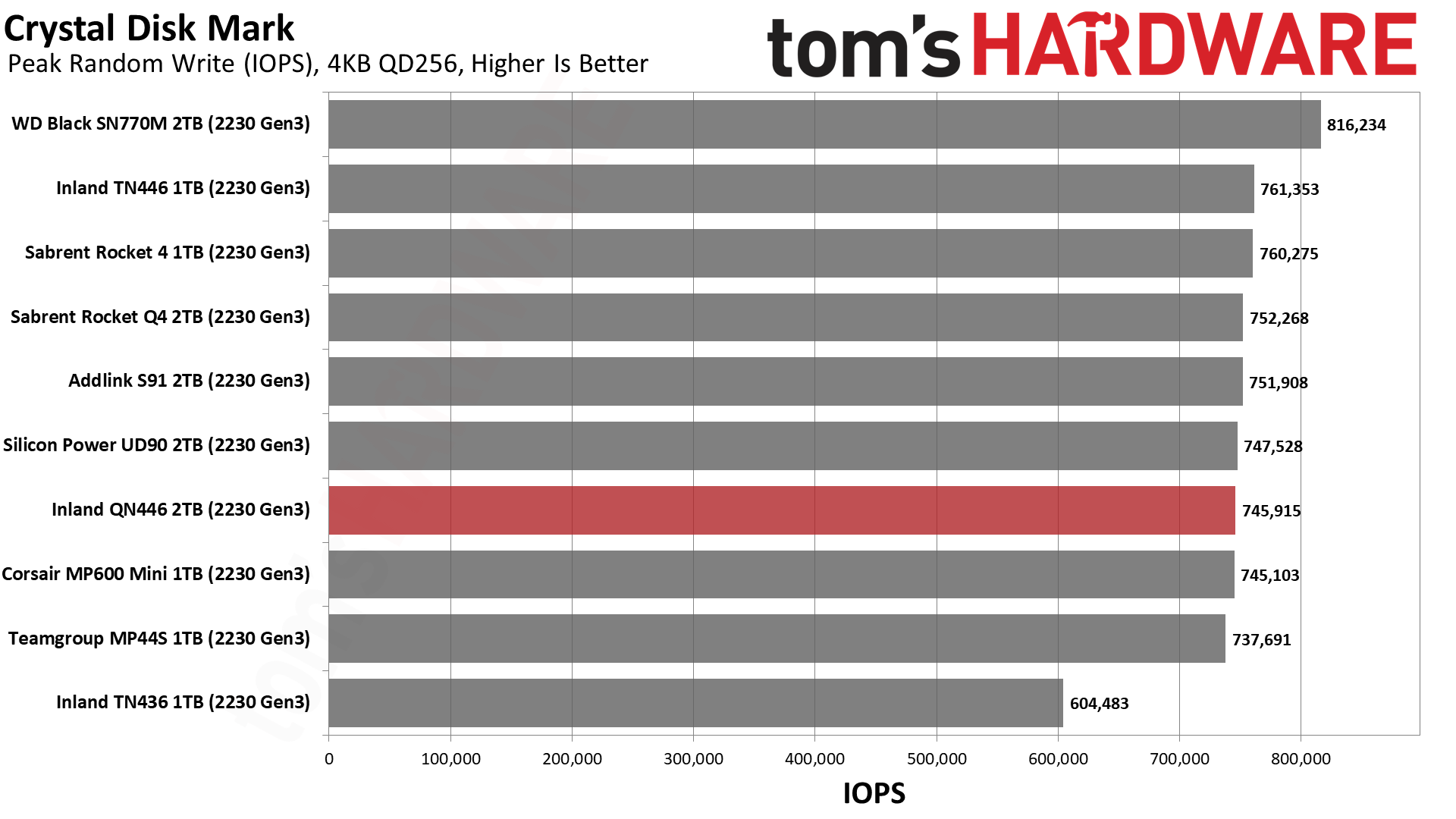
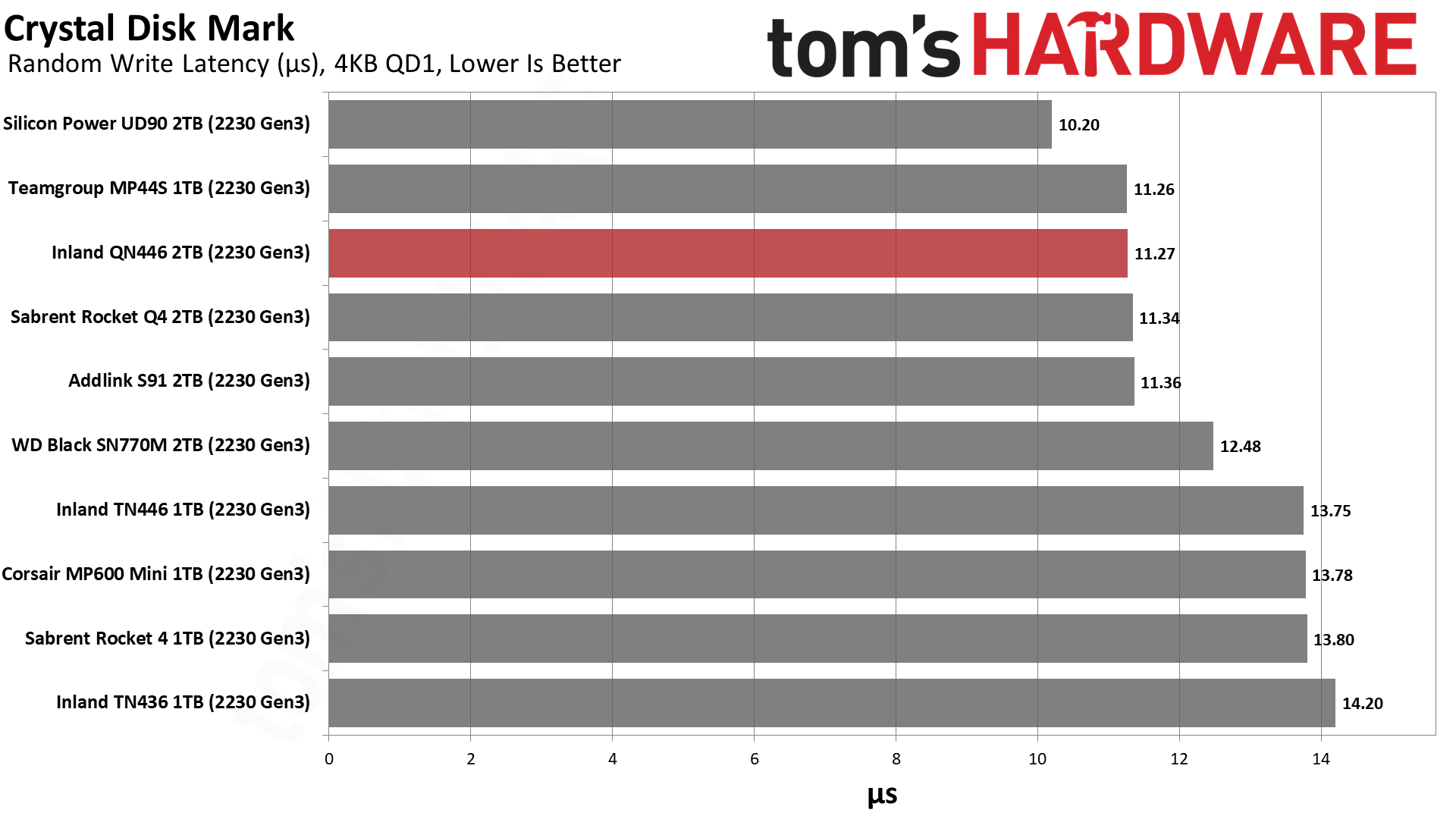
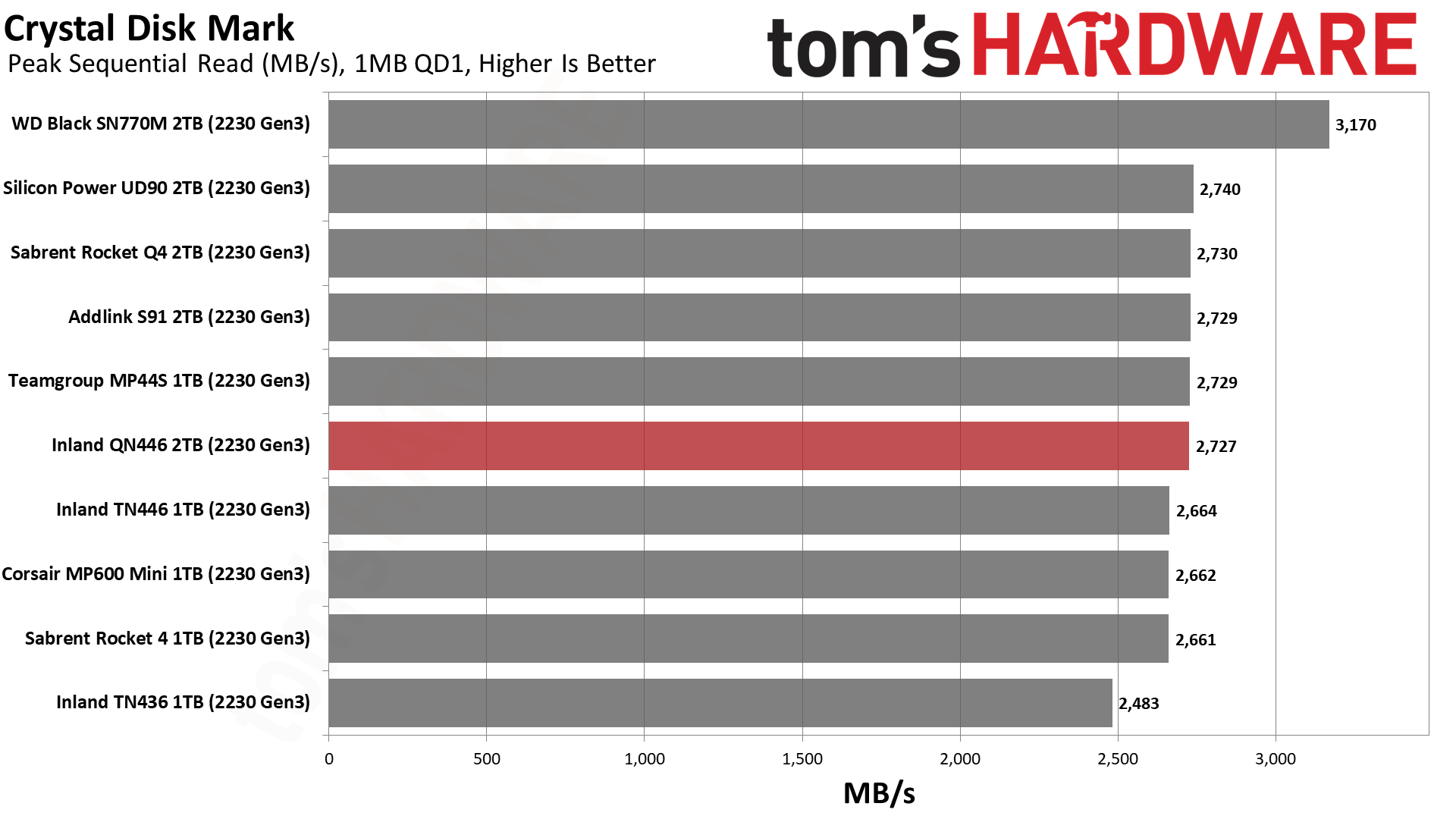
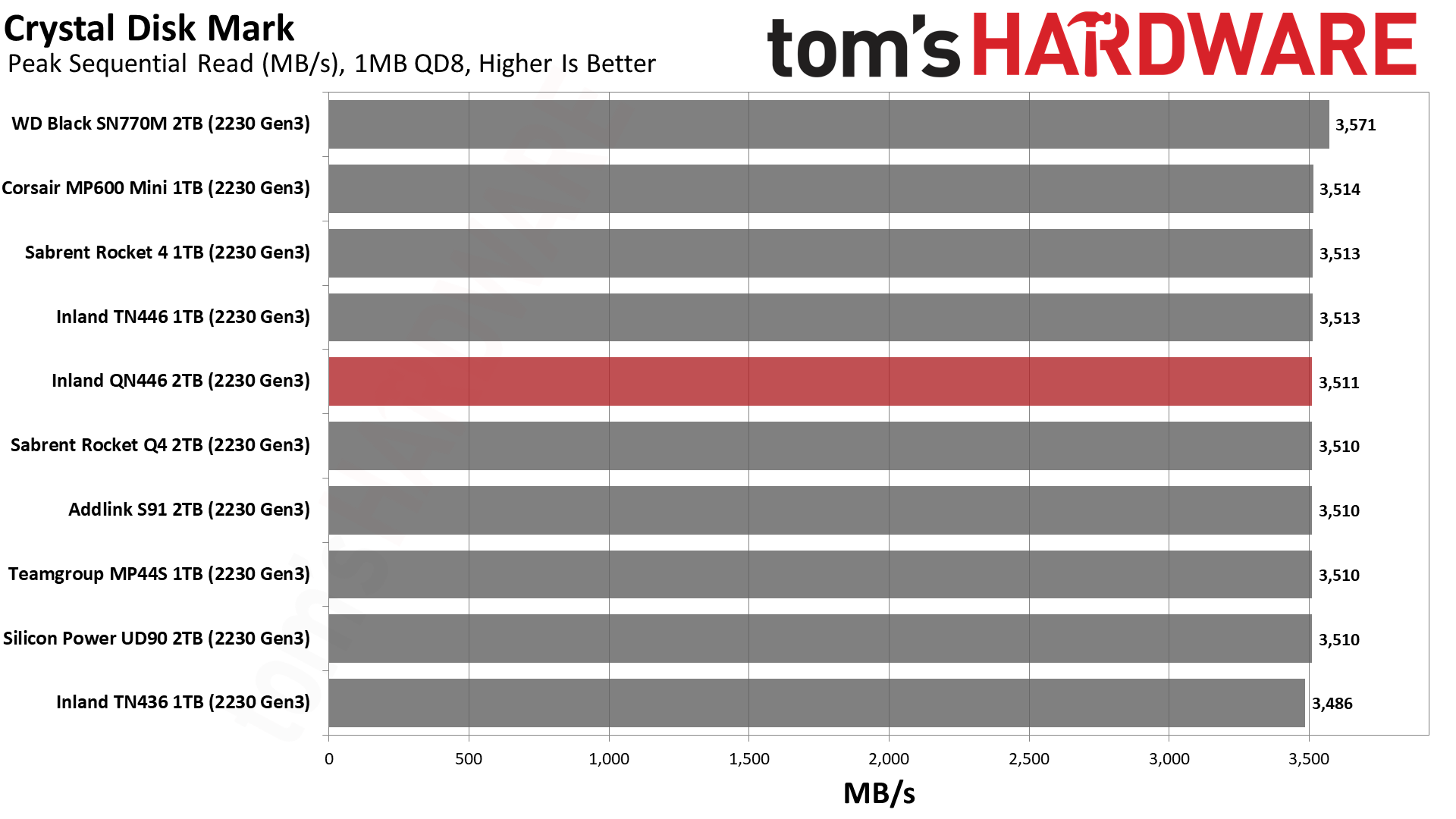
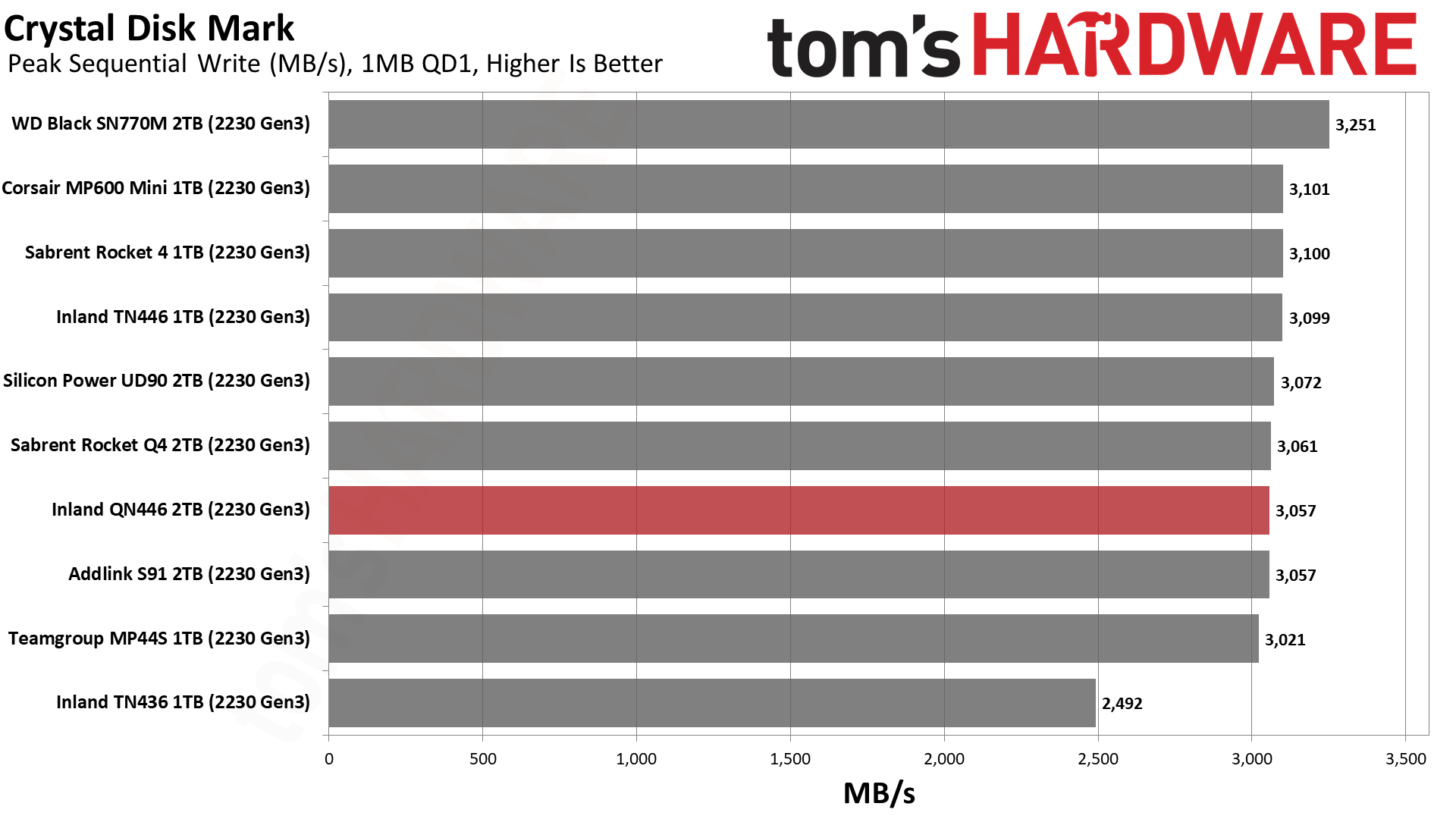

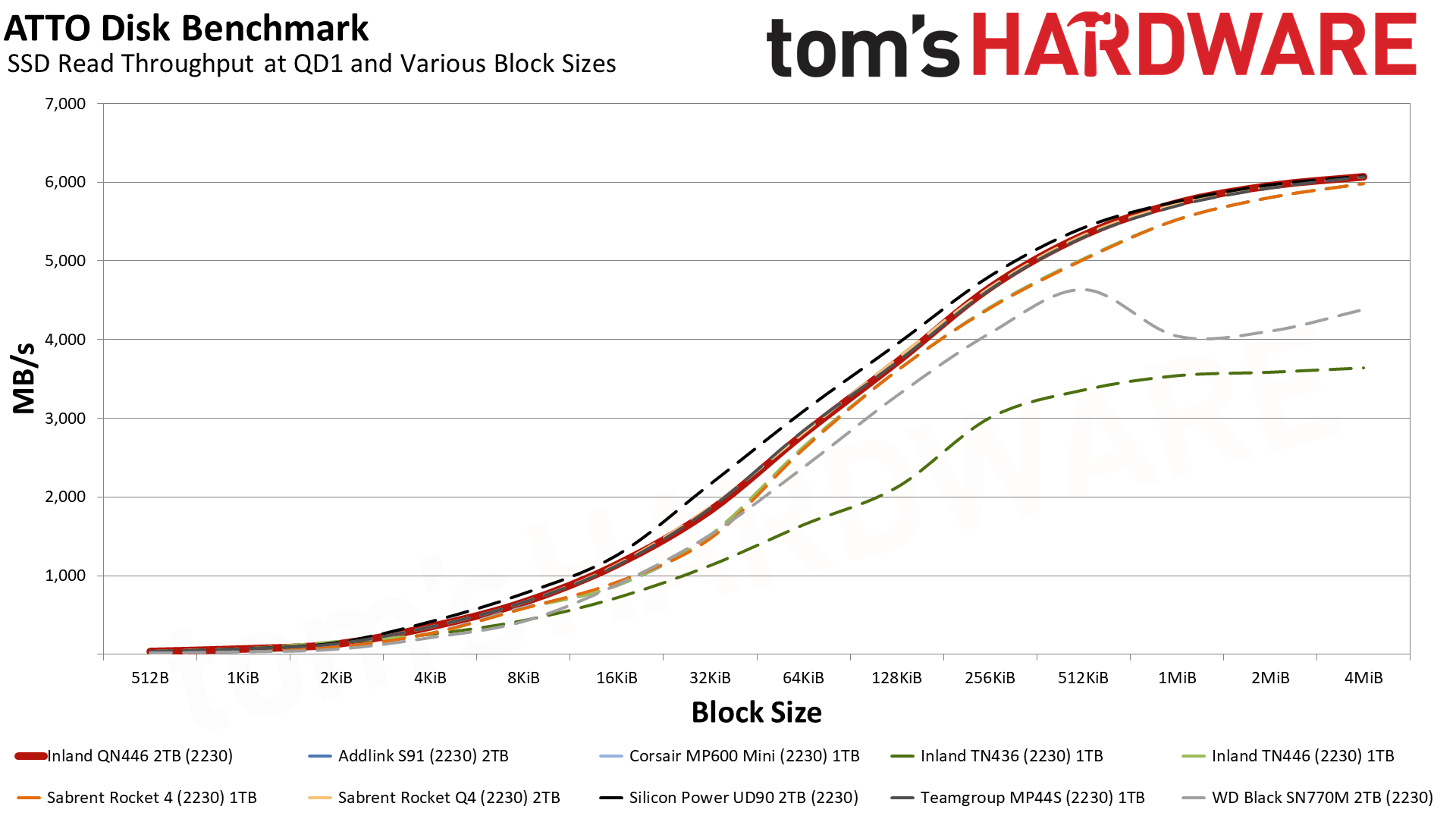

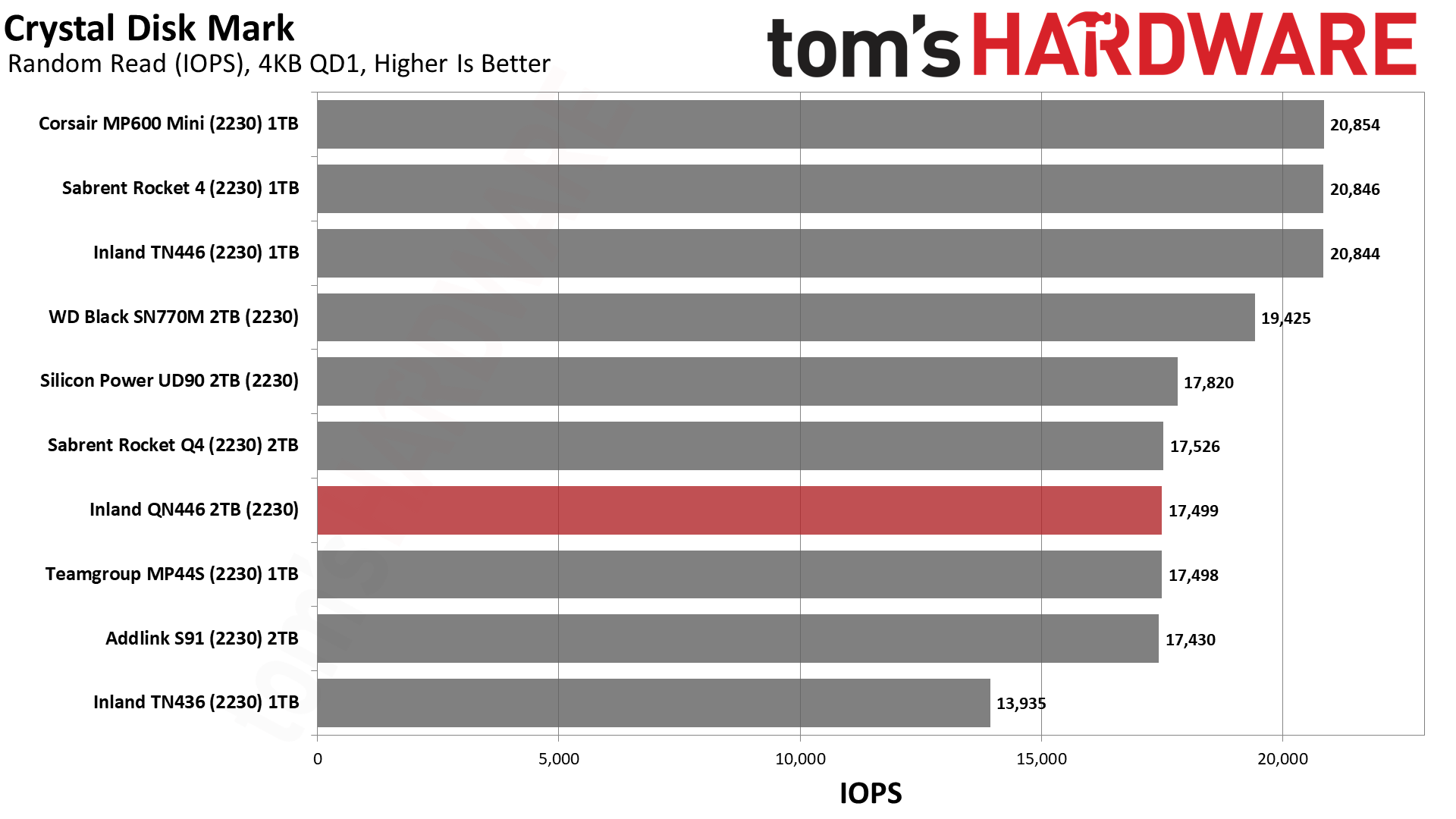
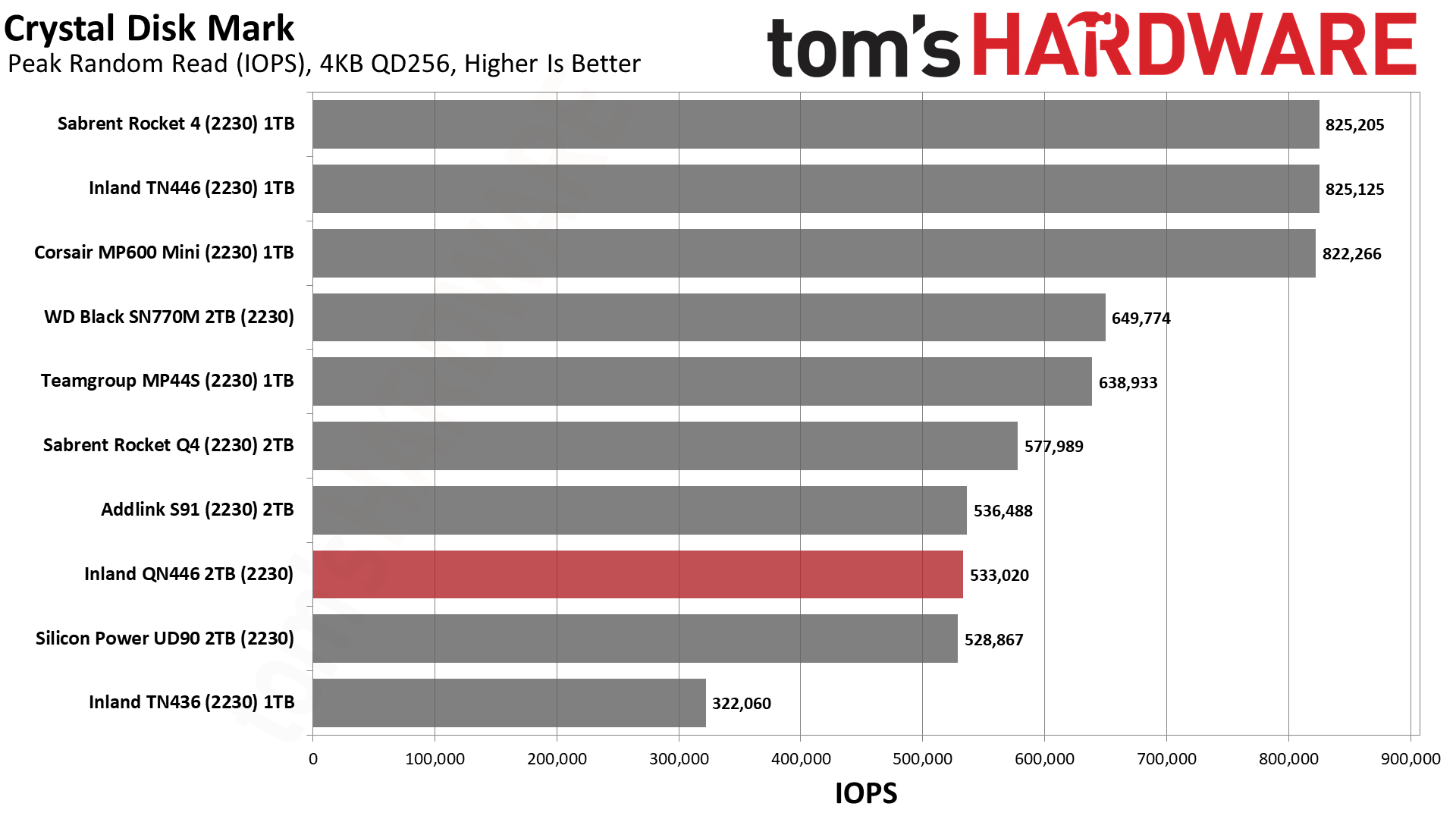
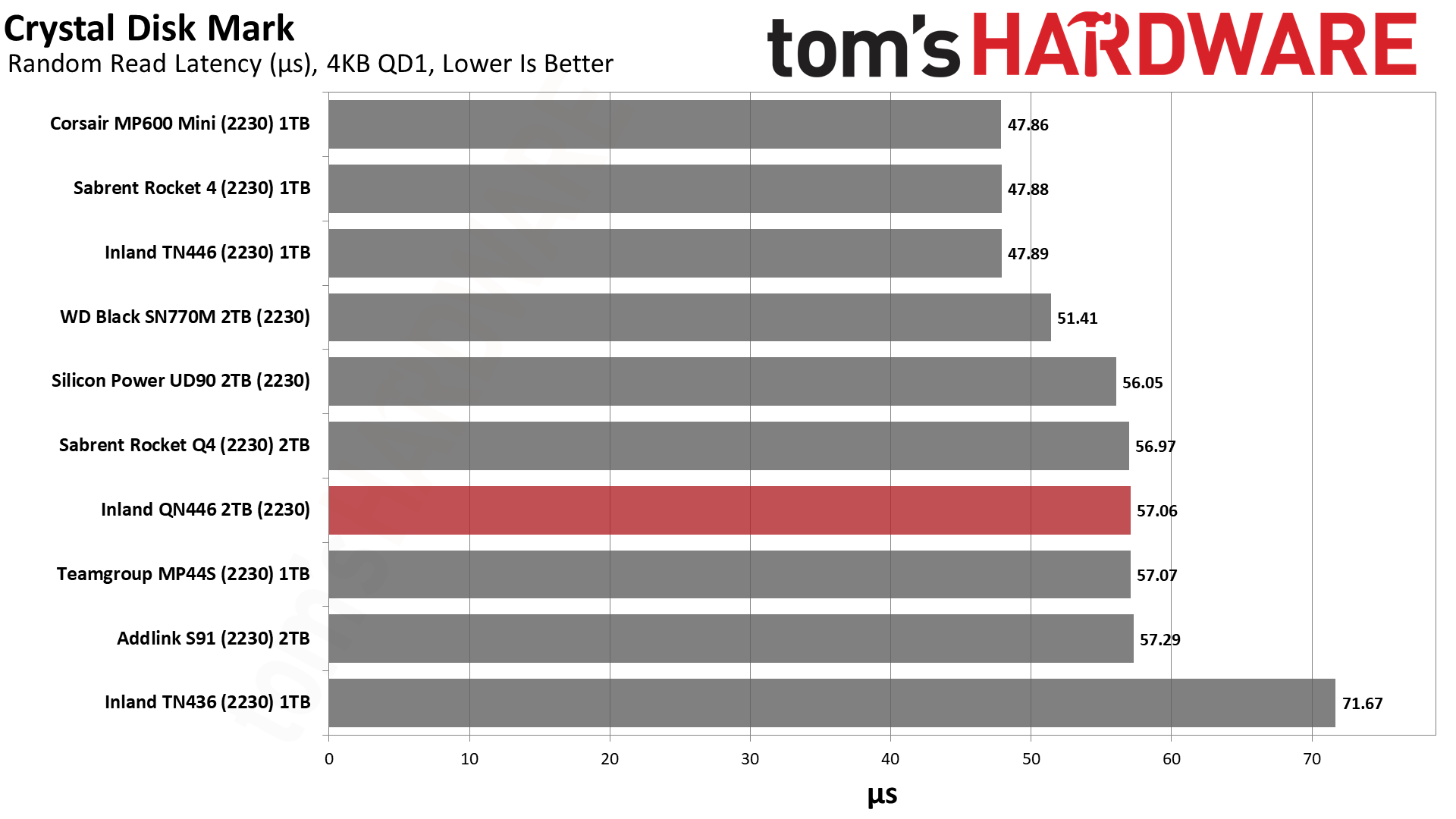
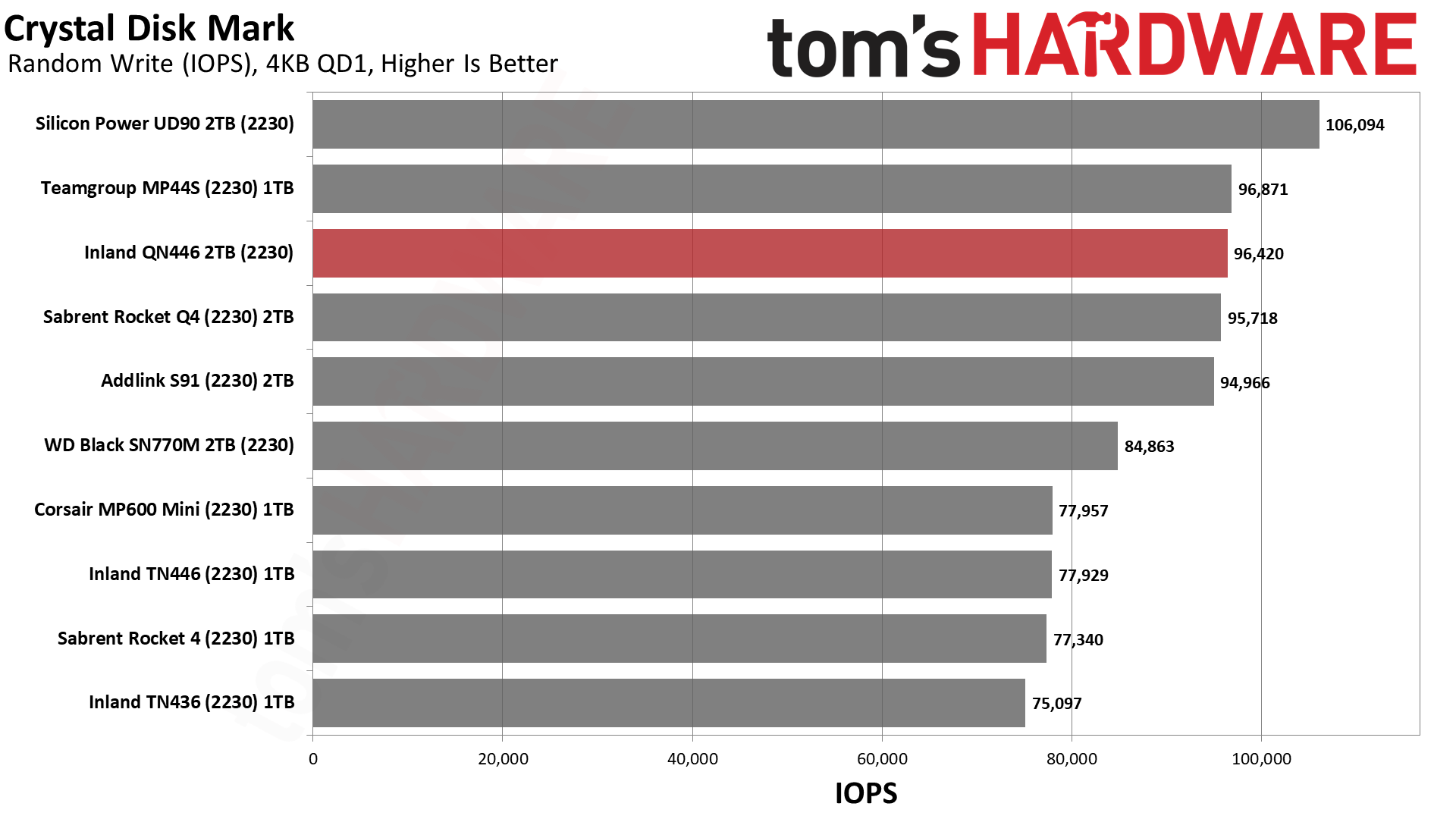
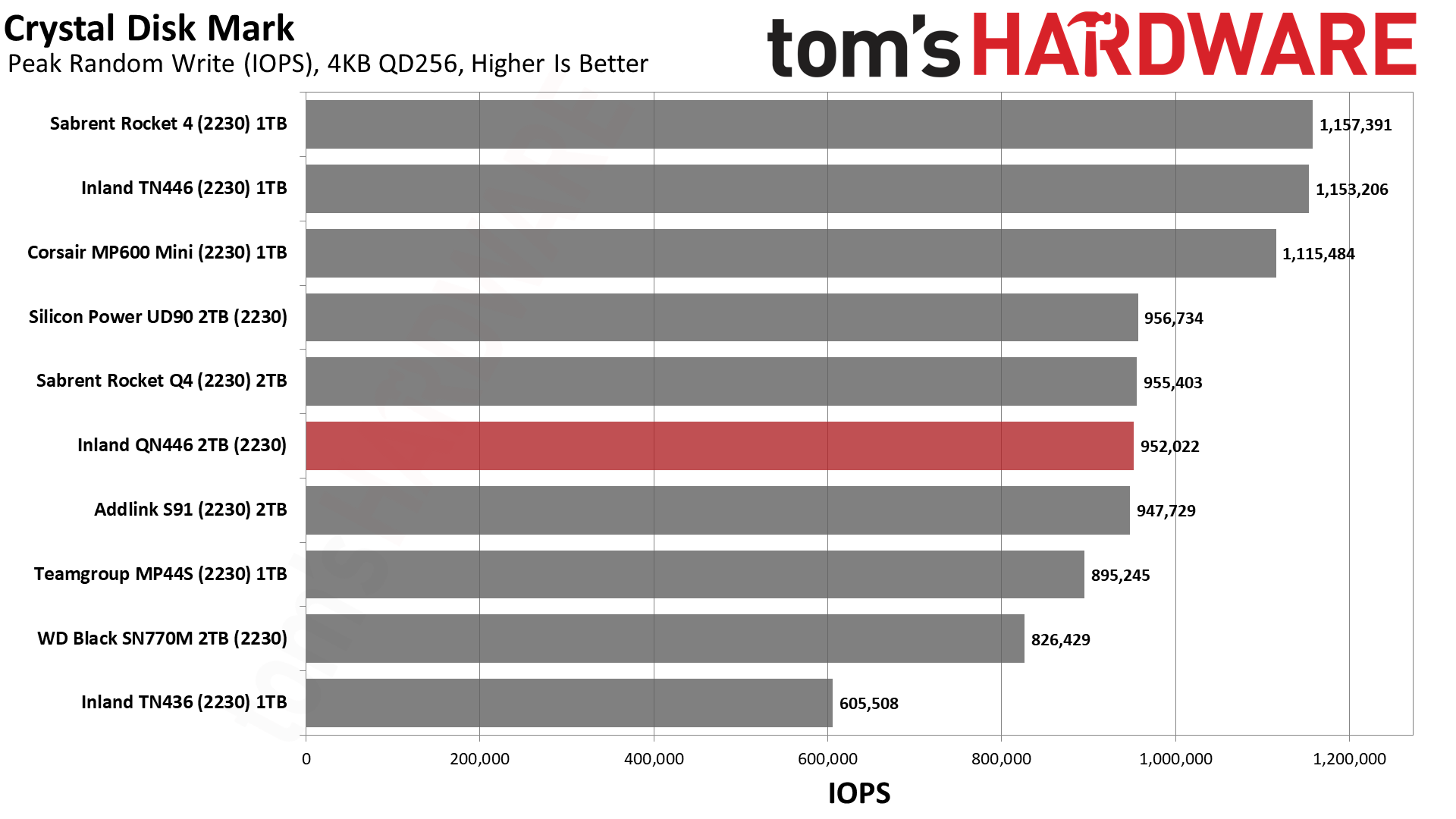
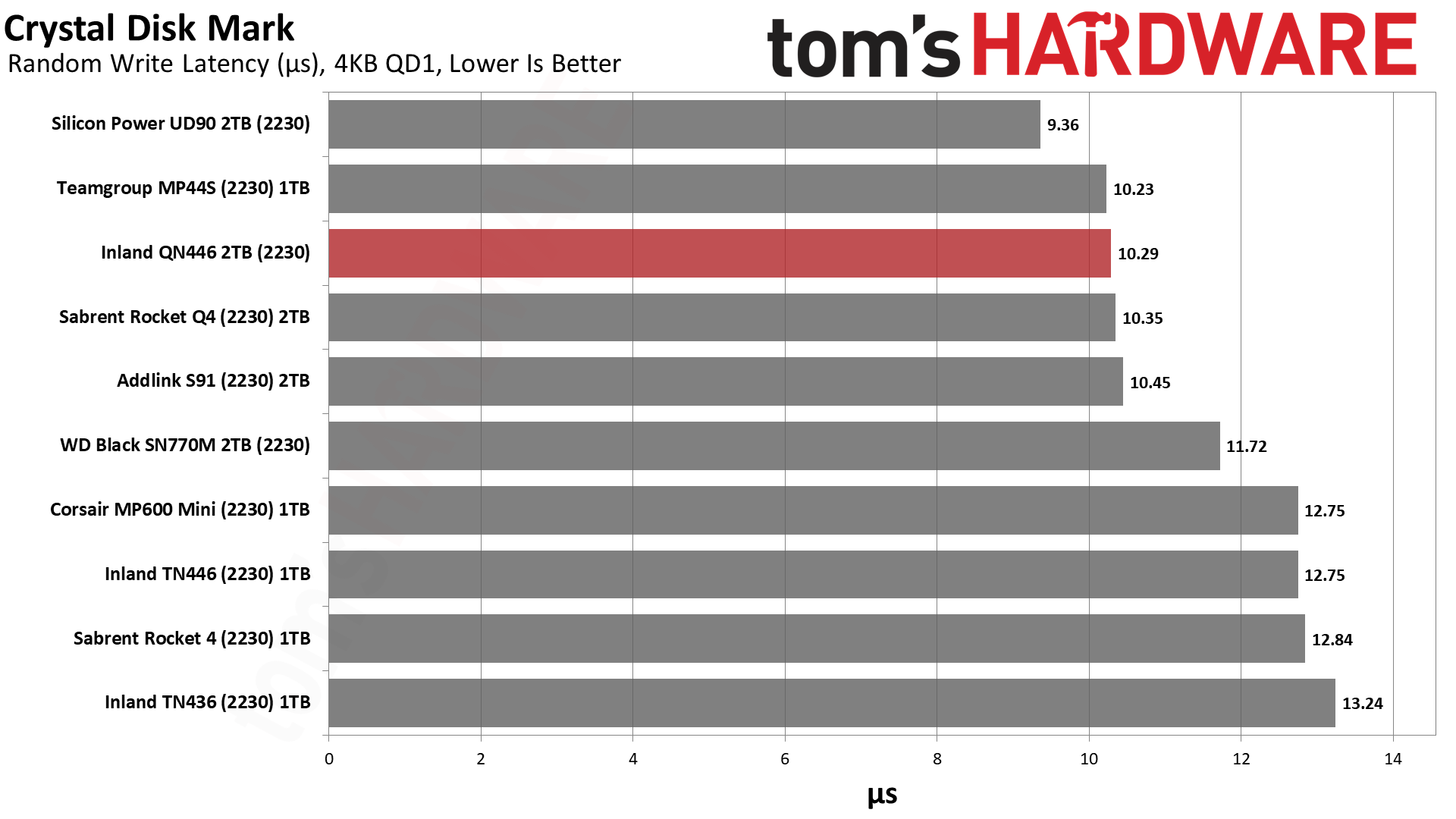
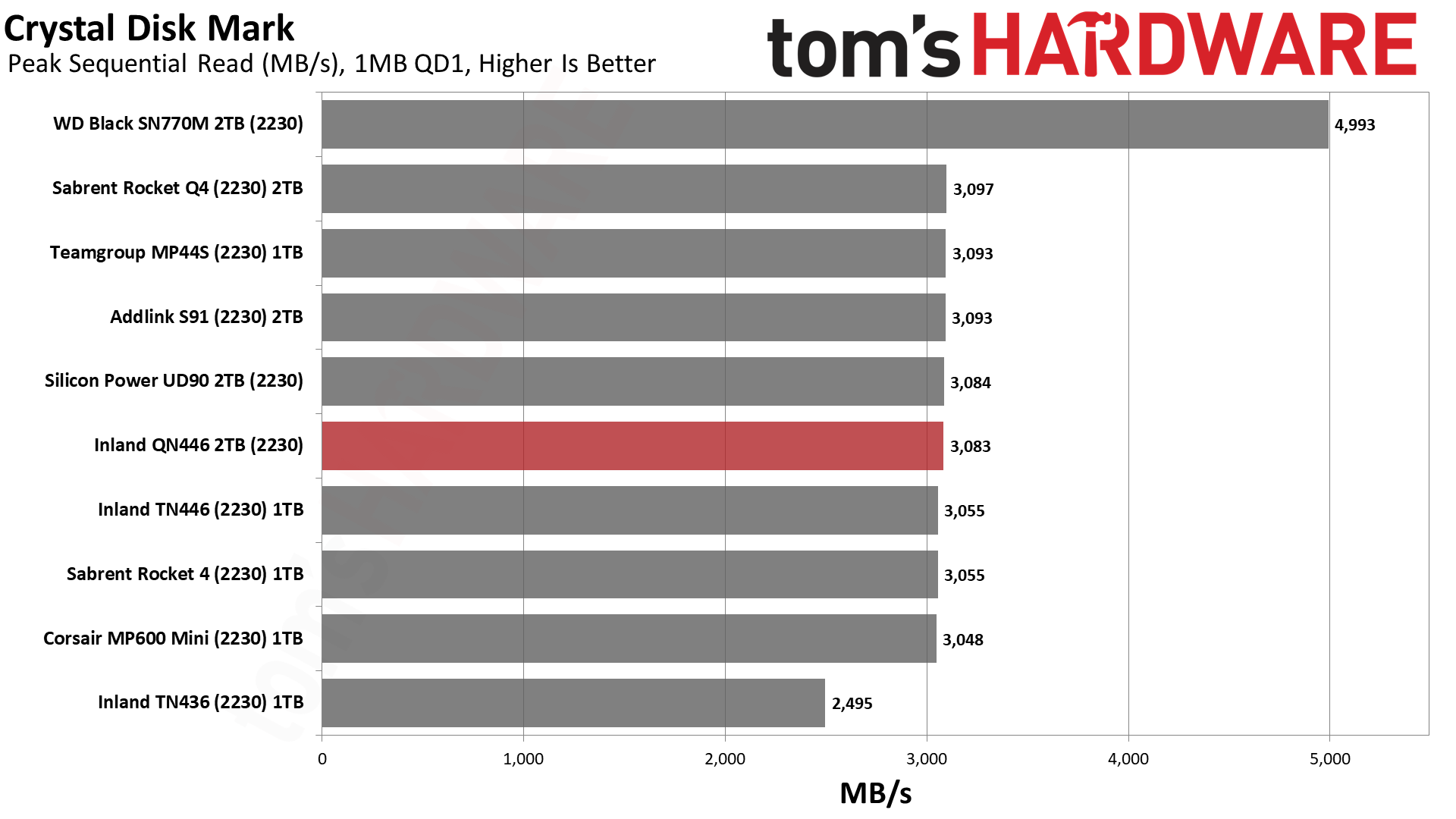
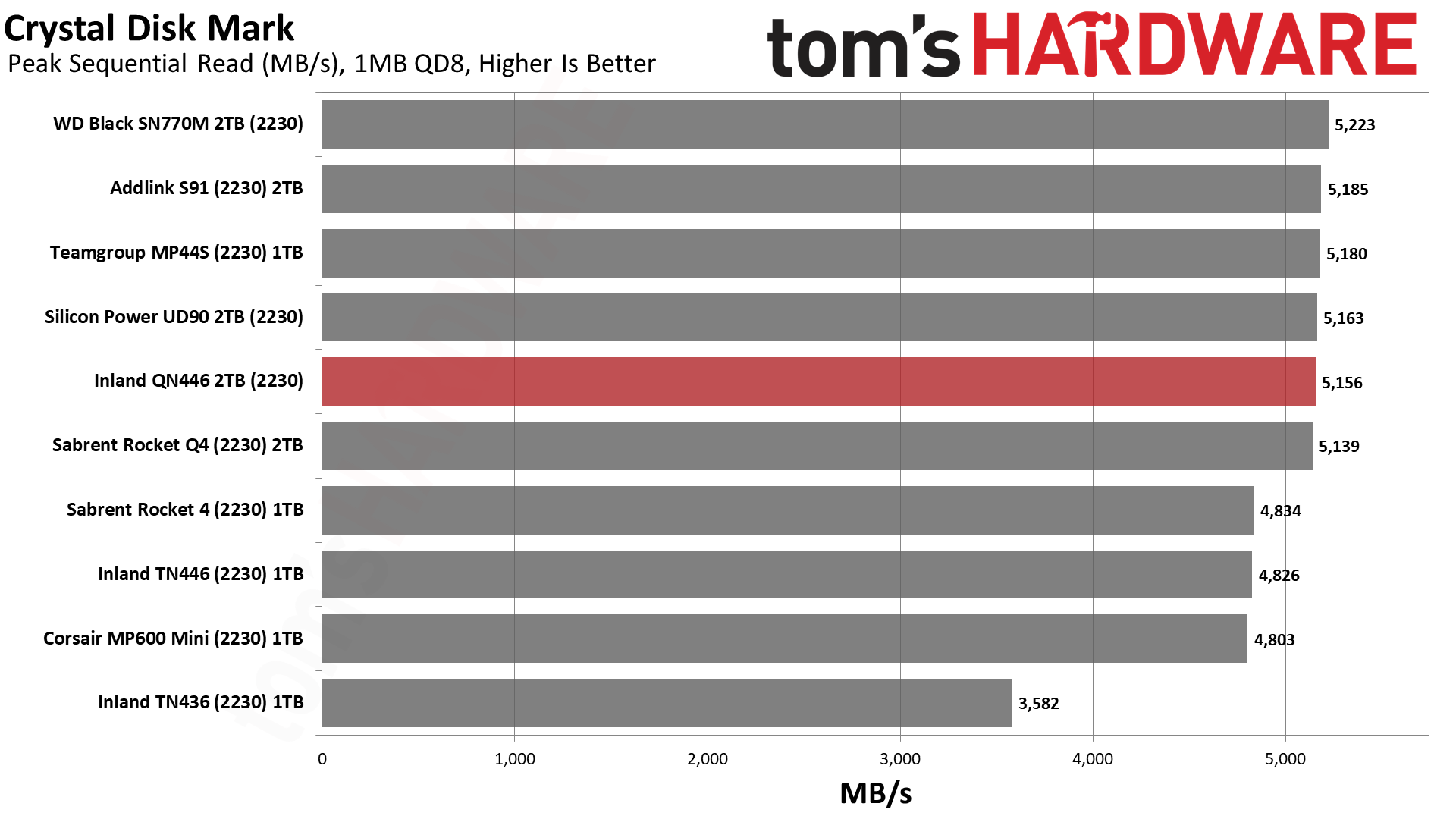

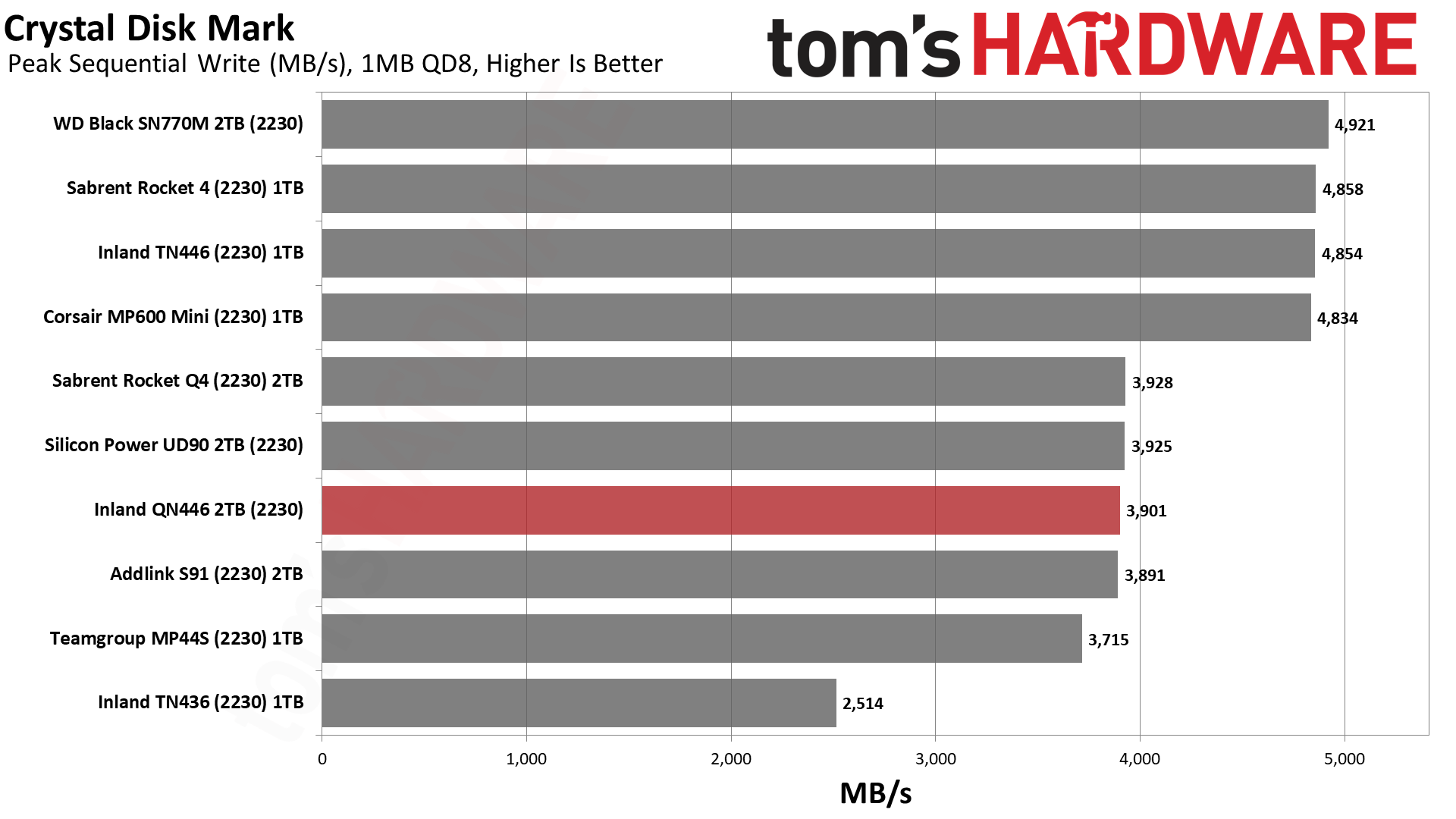
The Phison E21T controller delivers as always in ATTO; performance is good. Sequential performance for the QN446 is good in CDM, too, when restricted to PCIe 3.0. A PCIe 4.0 slot can open up more drive potential, and the QLC drives, including the QN446, will fall behind with sequential writes. This is always a pitfall for QLC and can be worrisome in edge cases, but an SSD will still perform better than a typical microSD card when its back is to the wall.
Random performance paints a different picture than sequential. Here, the QLC-based QN446 falls behind the TLC options for random reads in both modes. There is a significant gap in latency, which in some cases can lead to an inferior experience. This is usually difficult to feel subjectively, and objectively, the difference will usually be very small. Nevertheless, most of your data will end up in QLC mode for long-term storage, and this flash type has up to twice the read latency of TLC. However, this should be rarely felt, especially for a dedicated gaming device.
4K write latency is excellent, possibly due to architectural differences between Micron’s 176-Layer TLC and QLC. In fact, QLC from other manufacturers - like Intel’s 144-Layer QLC on the Solidigm P41 Plus - also sees good results here, likely derived from improvements to multi-planar operations. This is often a focus for development with QLC as the flash has denser dies and can benefit more from innovations like independent reads. This does not translate to peak IOPS, though, where TLC continues to dominate.
PC Sustained Write Performance and Cache Recovery
Official write specifications are only part of the performance picture. Most SSDs implement a write cache, which is a fast area of (usually) pseudo-SLC programmed flash that absorbs incoming data. Sustained write speeds can suffer tremendously once the workload spills outside of the cache and into the "native" TLC or QLC flash.
We use Iometer to hammer the SSD with sequential writes for 15 minutes to measure both the size of the write cache and performance after the cache is saturated. We also monitor cache recovery via multiple idle rounds.
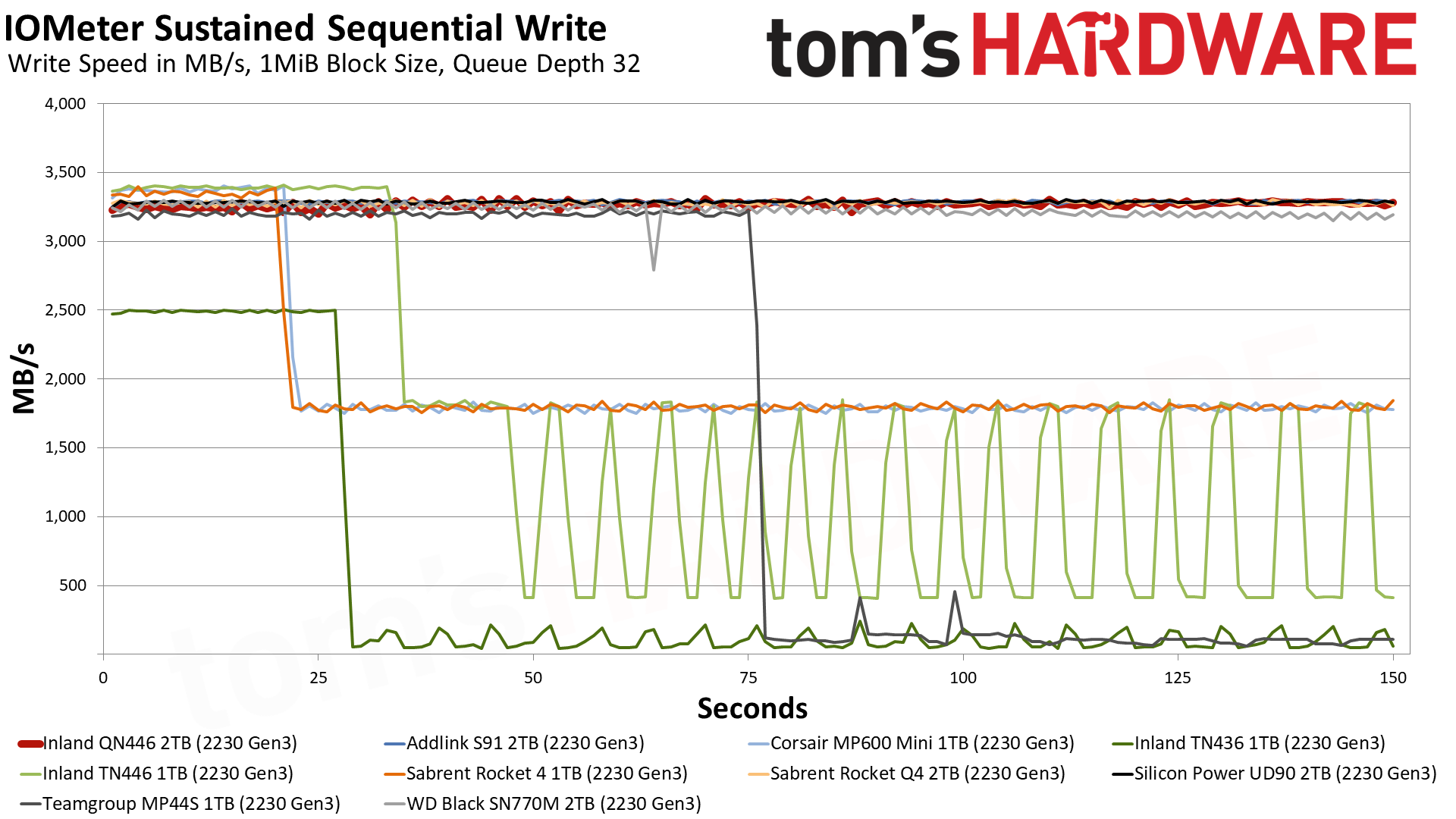
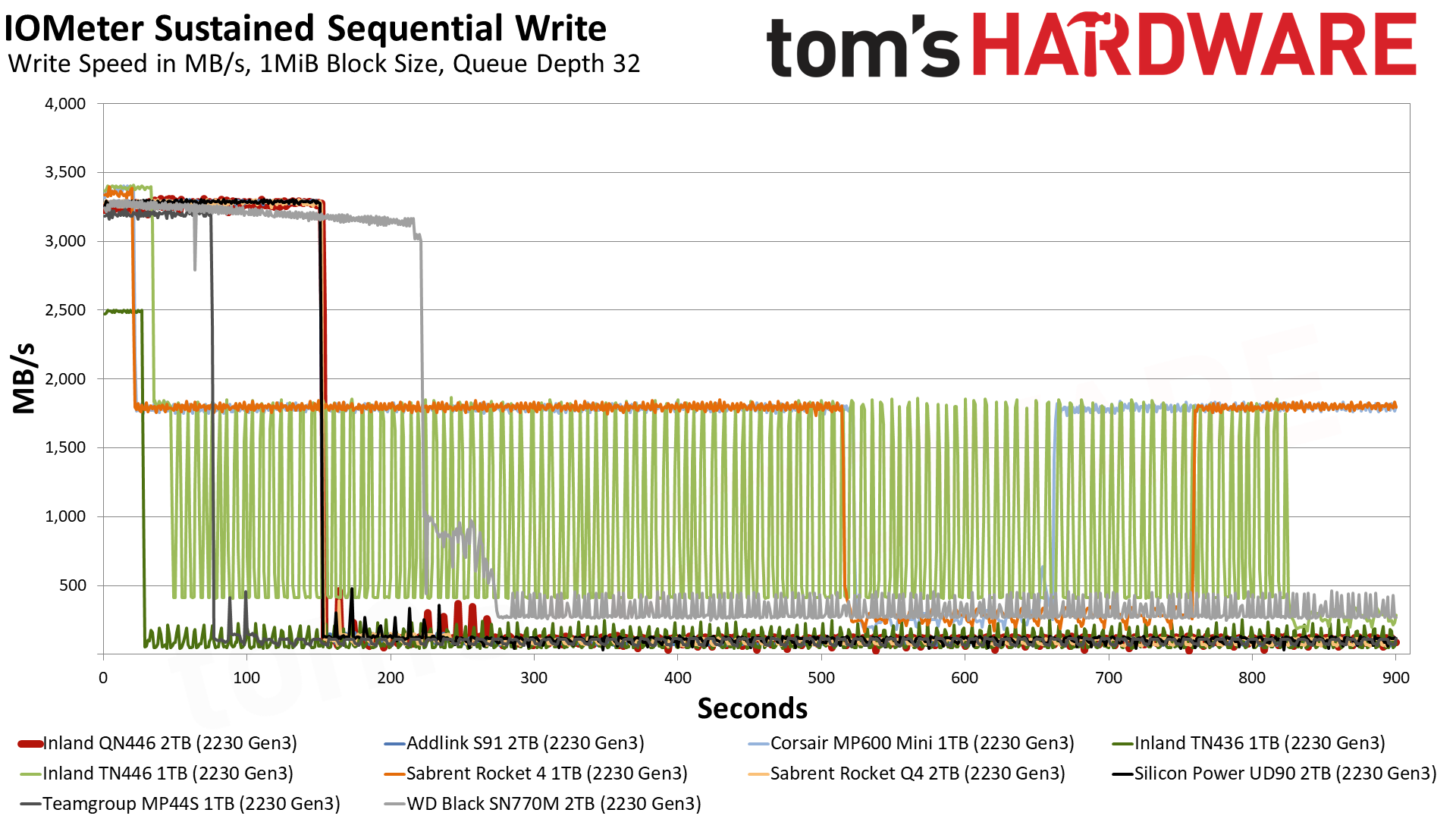
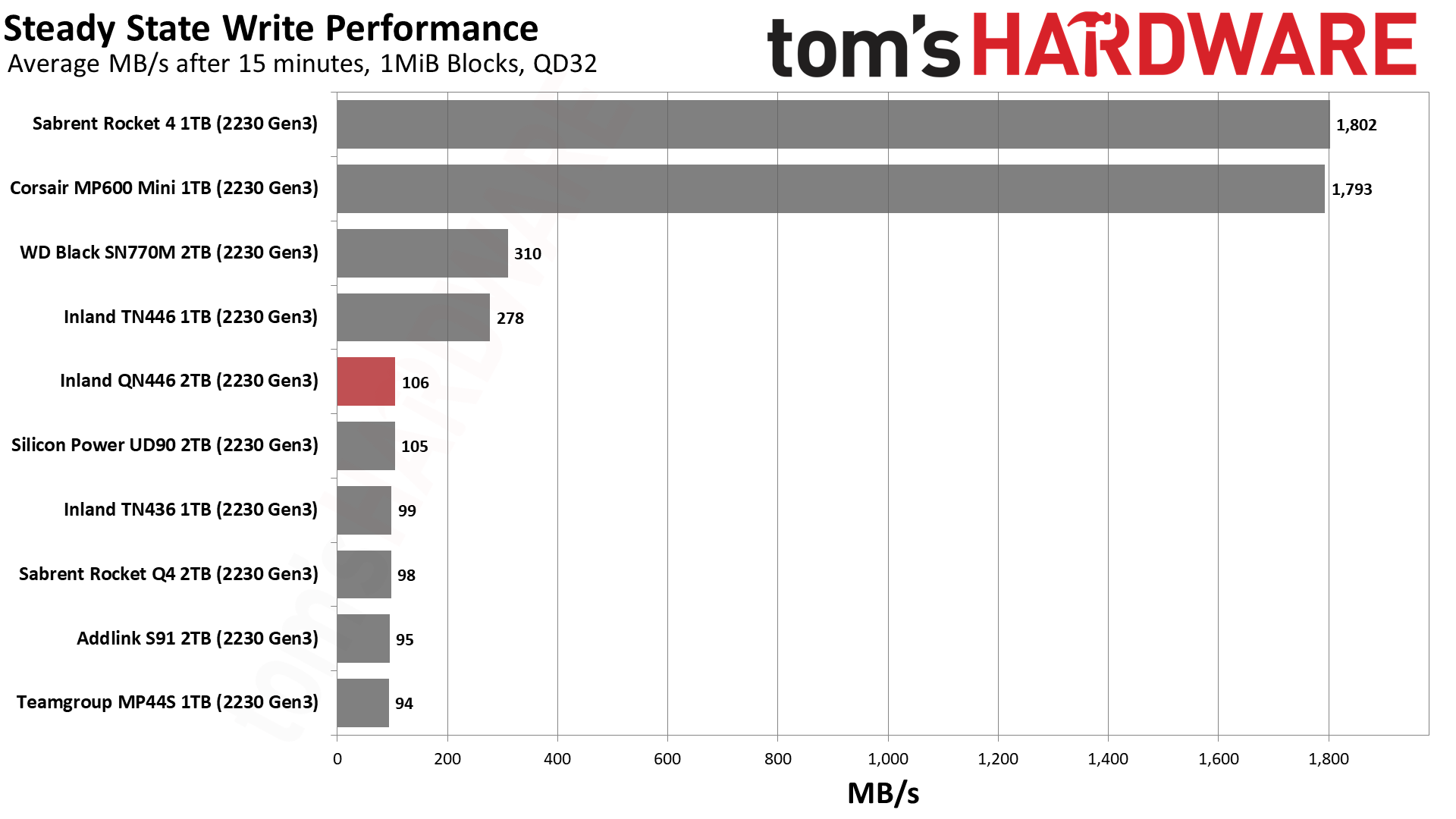
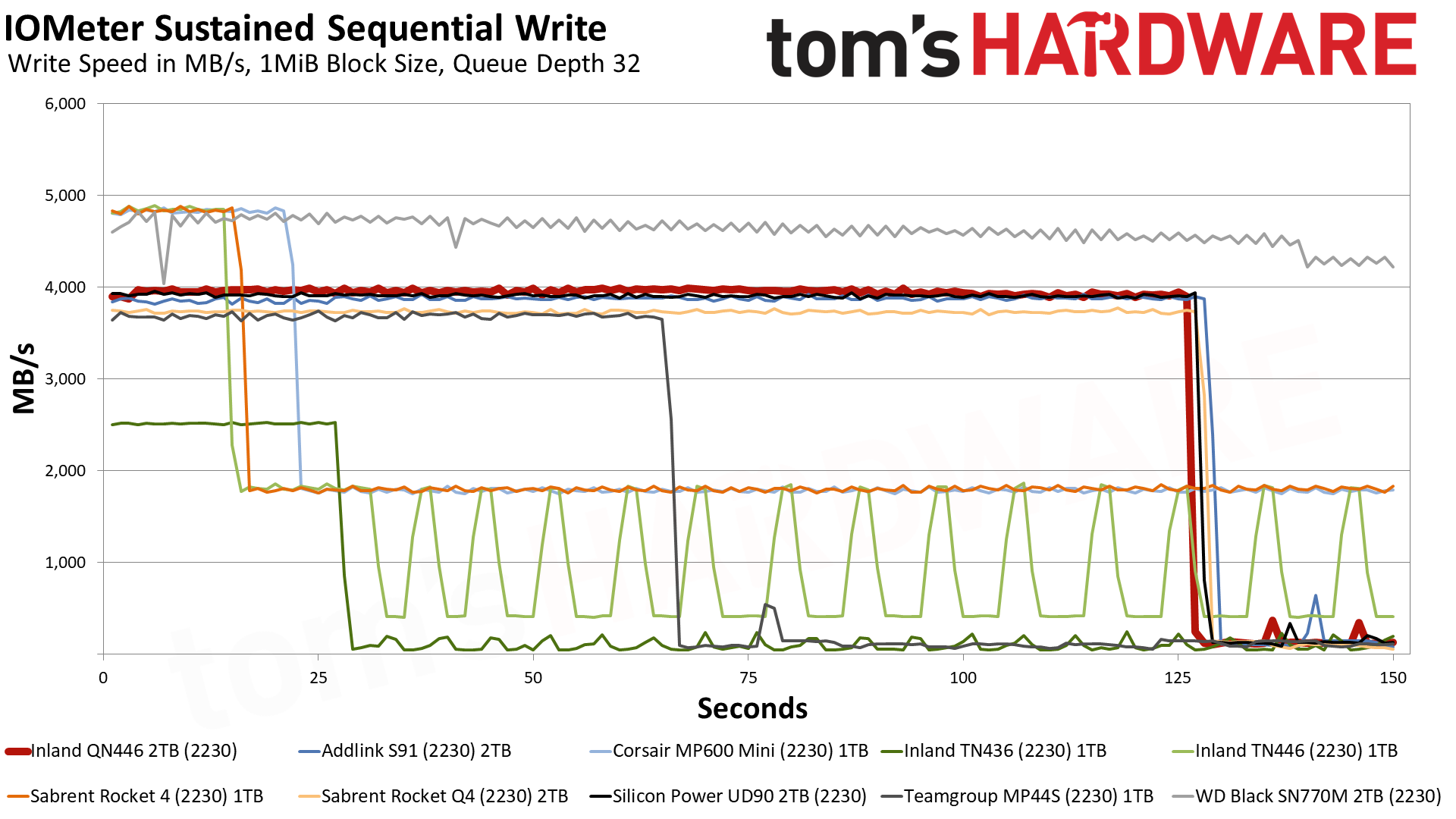
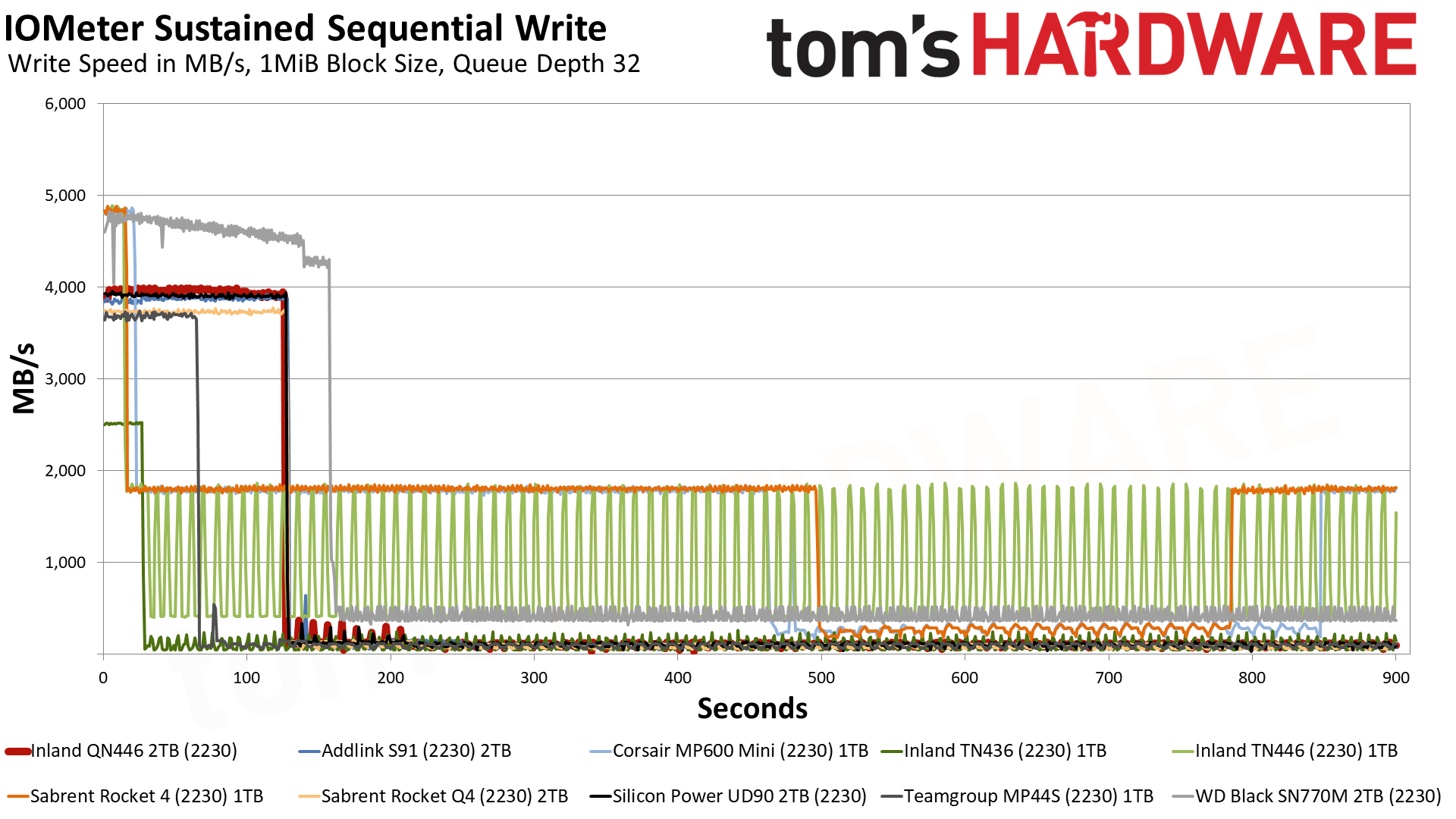

The QN446 writes at up to 3.1 GB/s in PCIe 3.0 mode and over 3.7 GB/s in PCIe 4.0 mode when it can take advantage of the pSLC cache. This cache requires four times its size in native QLC, so its capacity will be at most 1/4th the remaining user space. Here it appears to be even smaller than that, perhaps having a little buffer. The cache can recover some of its capacity fairly quickly with idle time as a result.
Larger, more aggressive caches often recover faster in general, but this can be detrimental to QLC as it’s beneficial to keep written data in the cache for reads and to reduce unnecessary rewrites. It seems that this is accounted for in the design of the QN446 and similar drives, like the Rocket Q4 2230, with a balance that should work well in portable gaming devices. However, large initial transfers - with a new install and the movement of many games - could challenge this design. QLC folding speeds on this drive are only a hair over 100 MB/s, which can feel very slow.
The only TLC 2TB drive on hand is the SN770M, which also uses an aggressively large cache. However, TLC allows for a larger relative cache, and the base performance is up to three times higher. This is not something you might notice often, but if you’re looking for the best performance possible, it’s still the best bet.
PC Power Consumption and Temperature
We use the Quarch HD Programmable Power Module to gain a deeper understanding of power characteristics. Idle power consumption is an important aspect to consider, especially if you're looking for a laptop upgrade as even the best ultrabooks can have mediocre storage.
Some SSDs can consume watts of power at idle while better-suited ones sip just milliwatts. Average workload power consumption and max consumption are two other aspects of power consumption, but performance-per-watt is more important. A drive might consume more power during any given workload, but accomplishing a task faster allows the drive to drop into an idle state more quickly, ultimately saving energy.
For temperature recording we currently poll the drive’s primary composite sensor during testing with a 24C ambient.
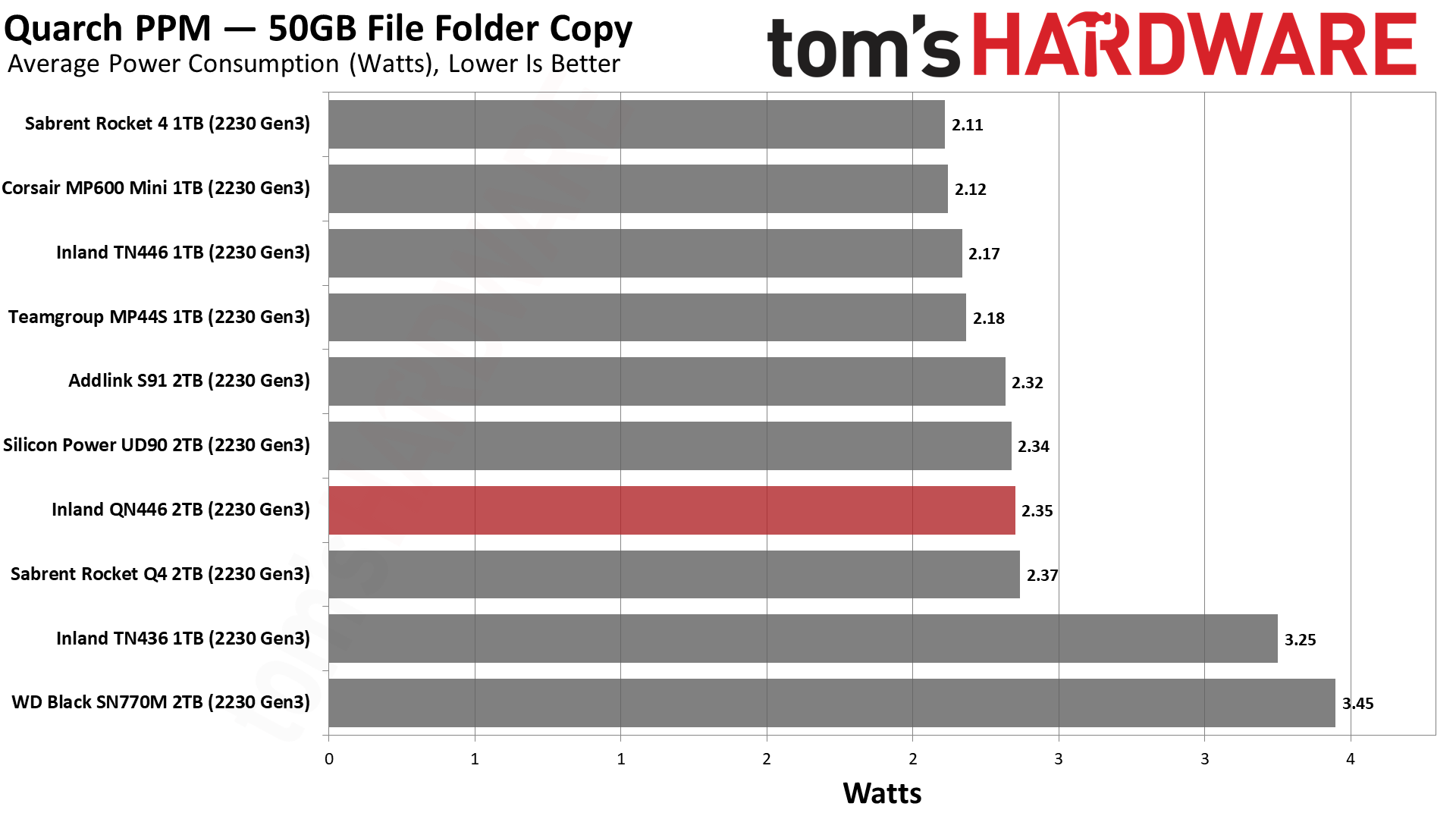
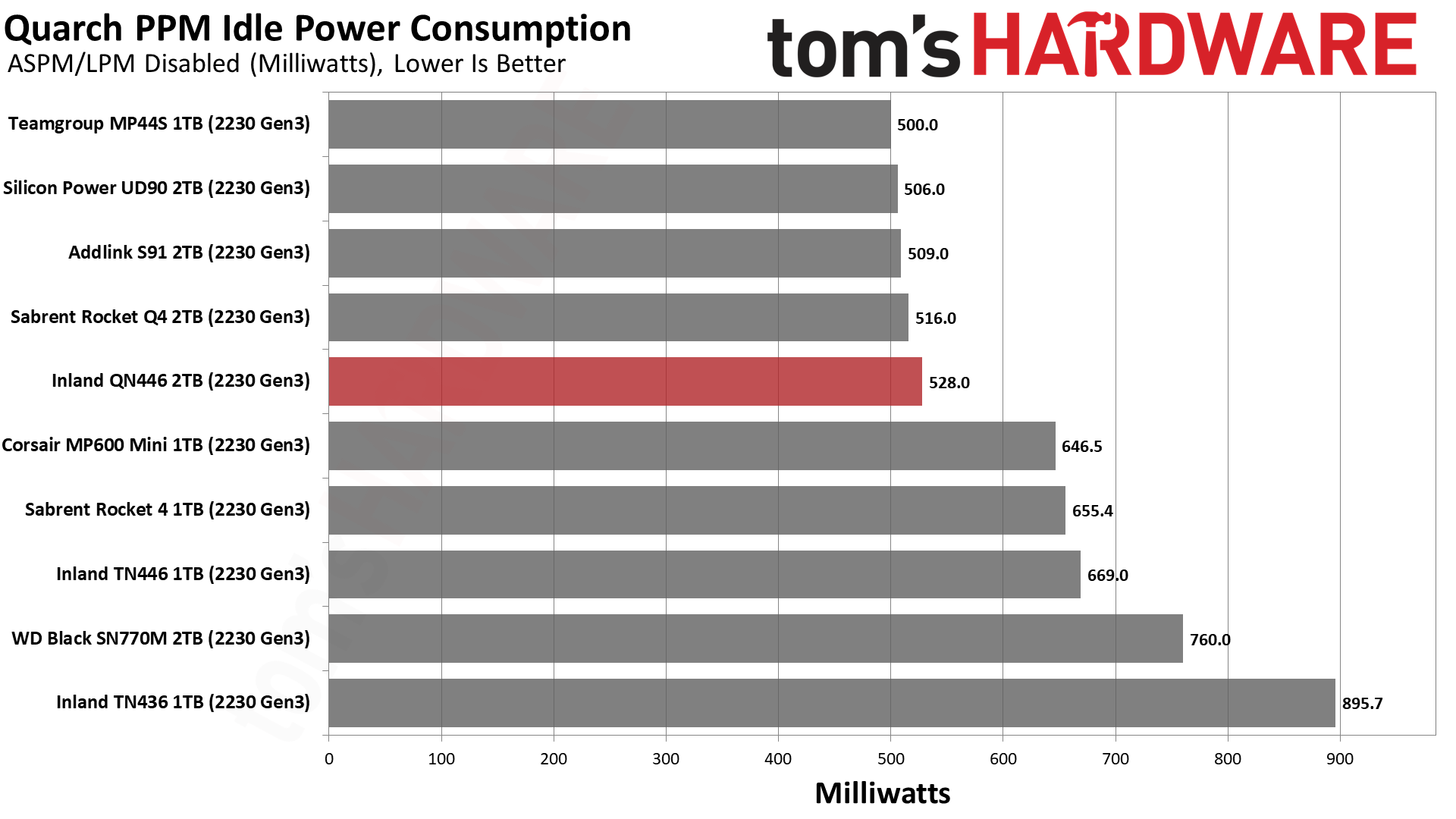
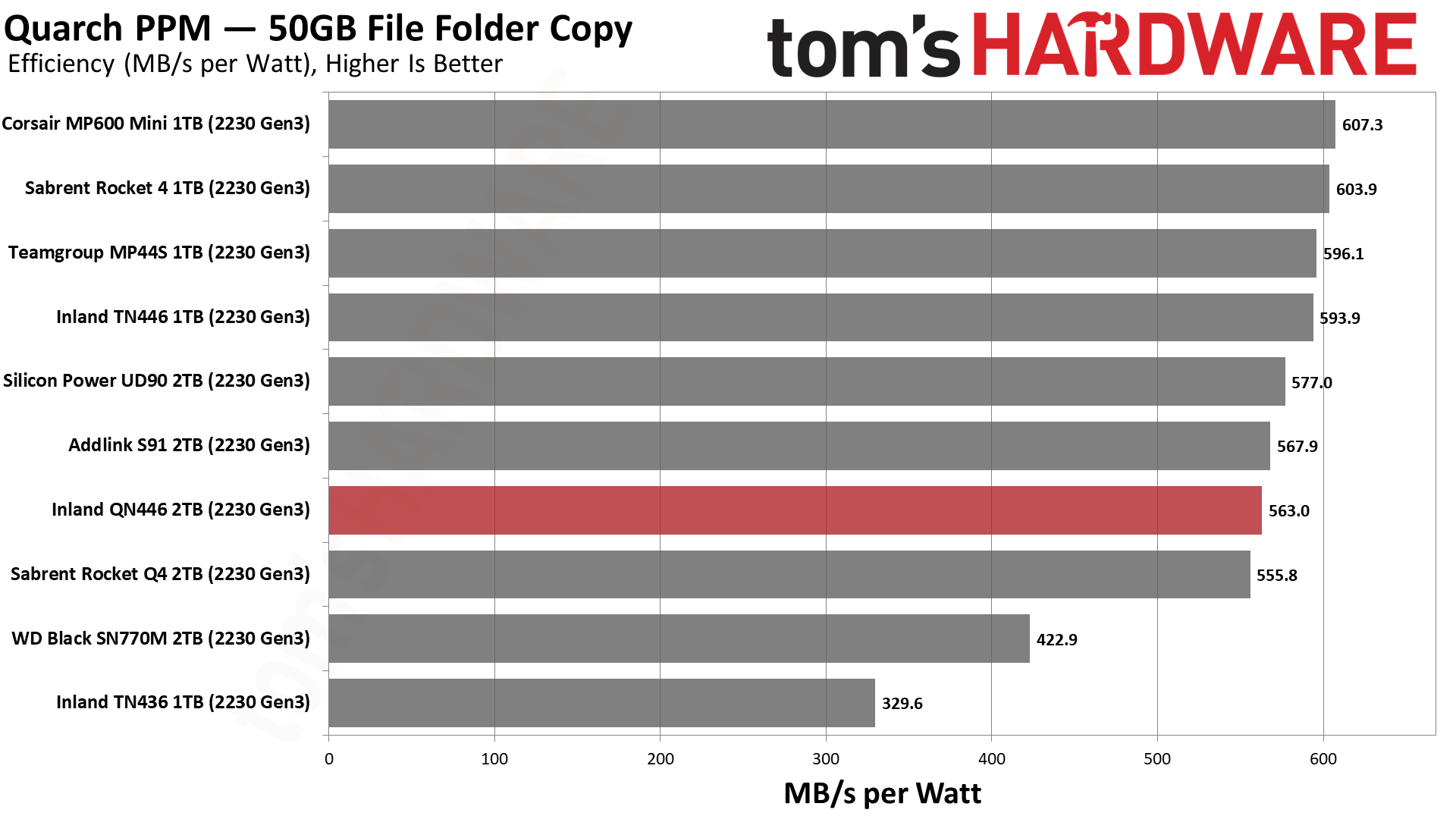
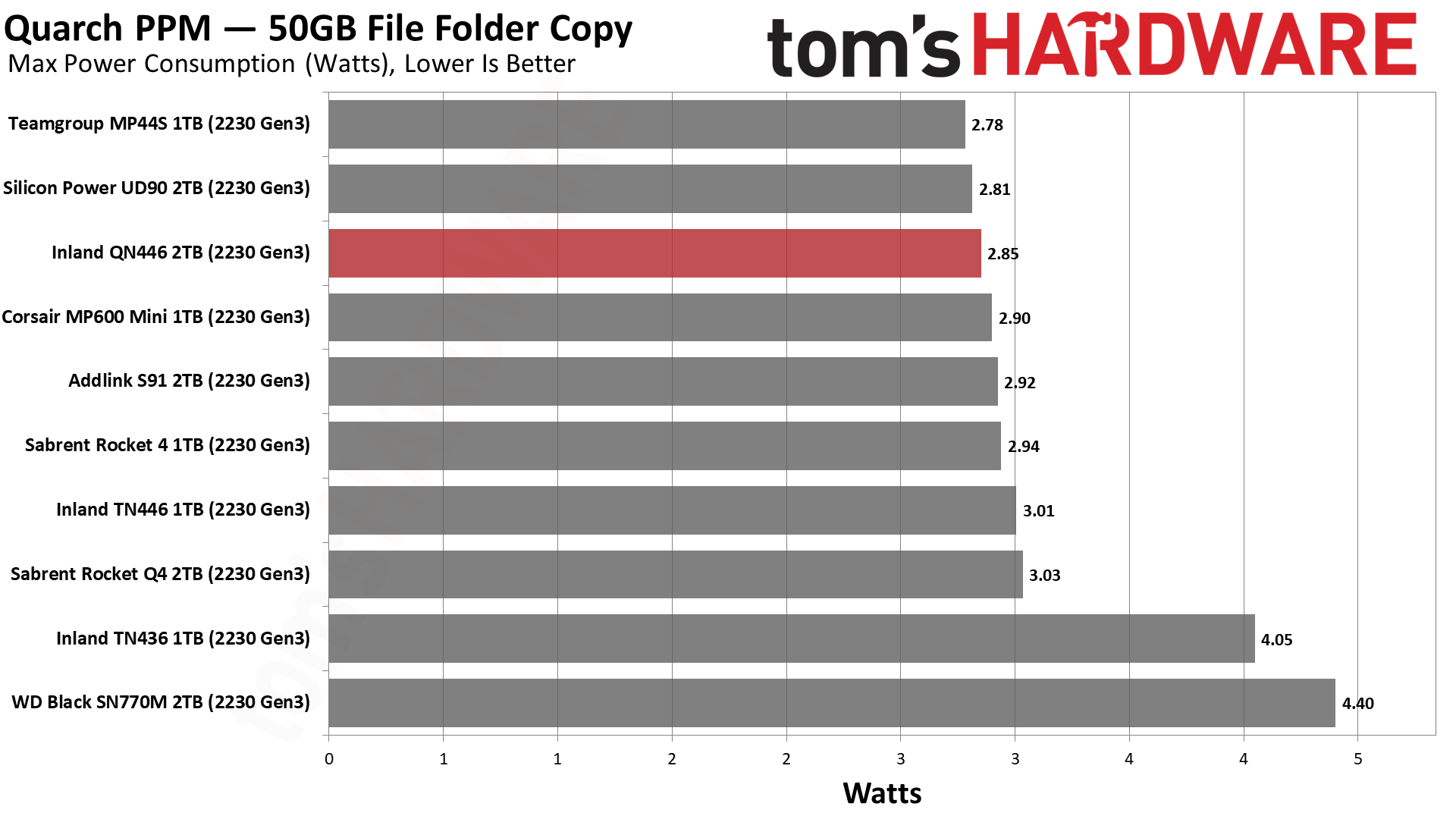
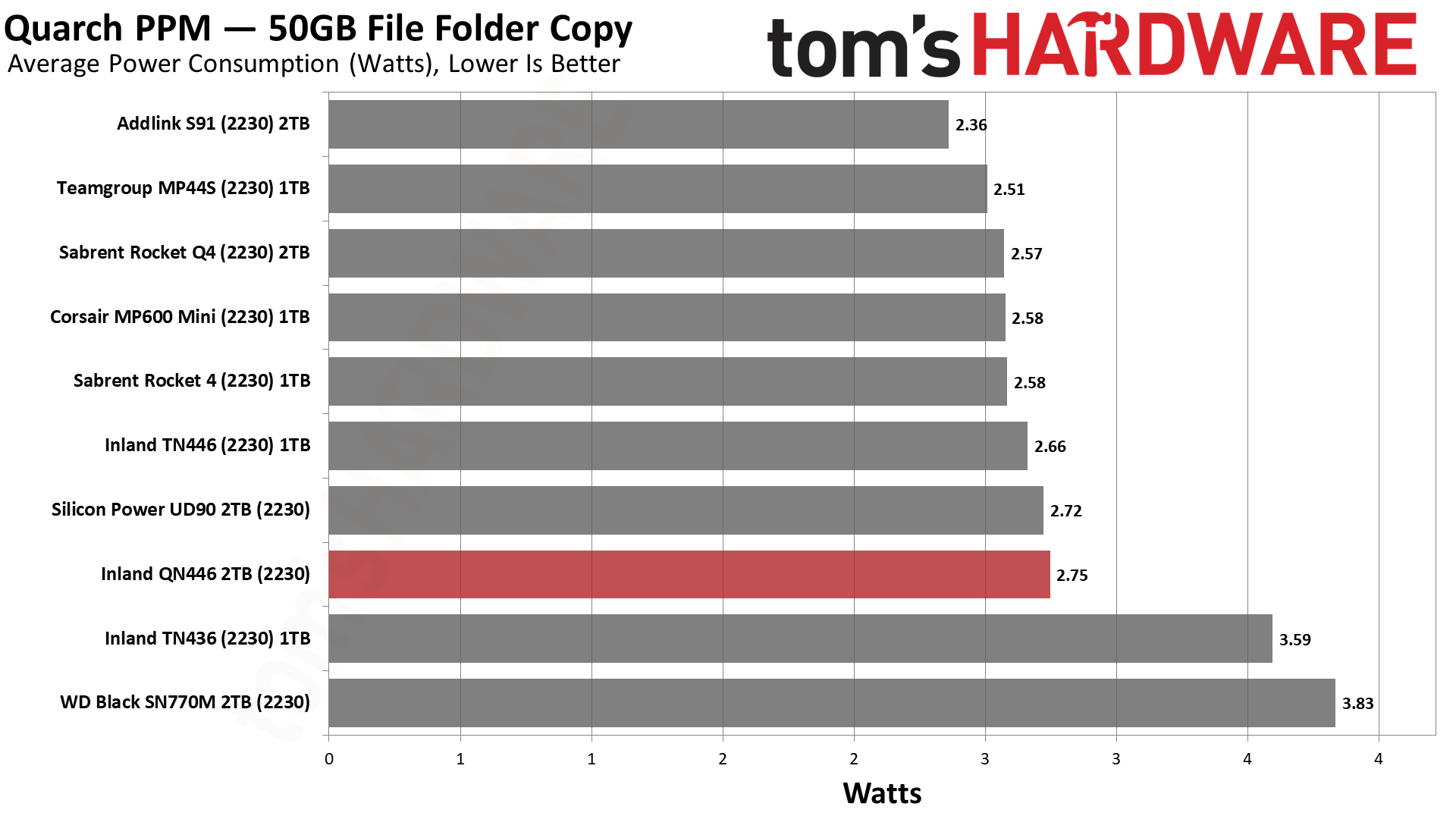
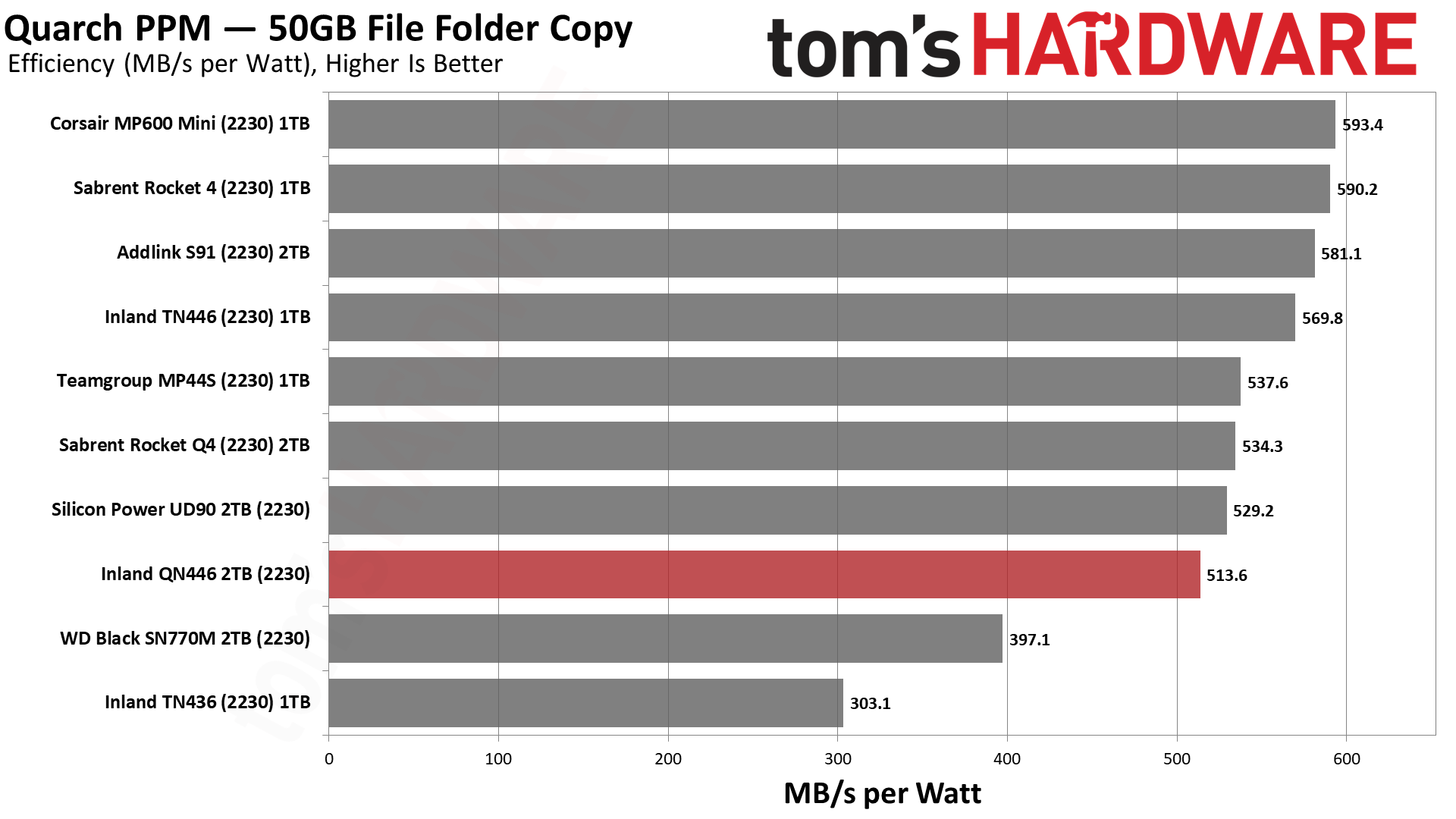

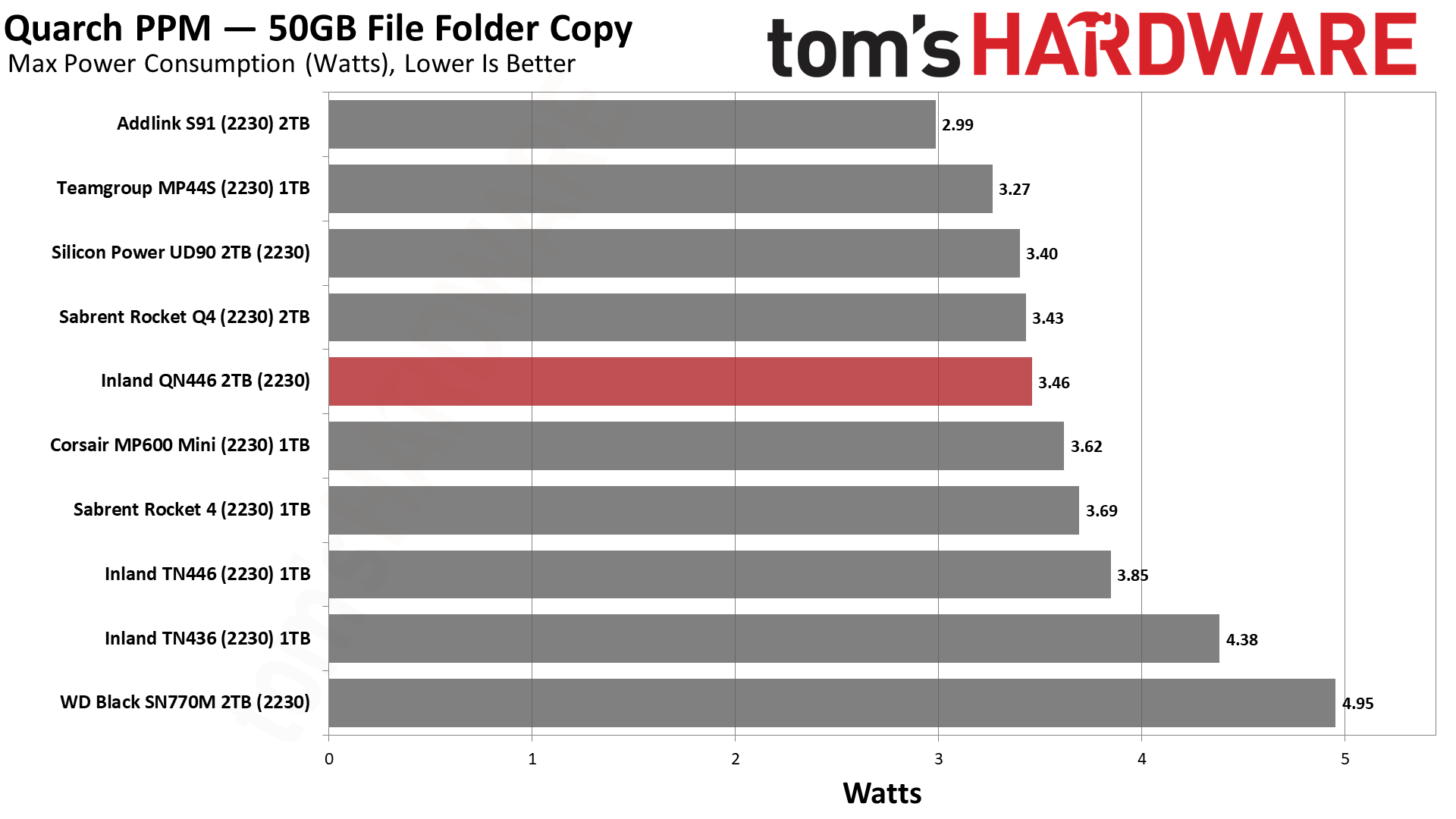
The QN446 is not inefficient, but it also doesn’t score quite as well as its peers. It’s still better than the older TN436 and WD’s SN770M but isn’t particularly impressive otherwise. As with the other drives tested, the QN446 is more efficient in the PCIe 3.0 mode.
During testing, the QN446 peaked at around 60-61C in both modes. This is a good result and much cooler than the SN770M.
Test Bench and Testing Notes
| CPU | Intel Core i9-12900K |
| Motherboard | Asus ROG Maximus Z790 Hero |
| Memory | 2x16GB G.Skill DDR5-5600 CL28 |
| Graphics | Intel Iris Xe UHD Graphics 770 |
| CPU Cooling | Enermax Aquafusion 240 |
| Case | Cooler Master TD500 Mesh V2 |
| Power Supply | Cooler Master V850 i Gold |
| OS Storage | Sabrent Rocket 4 Plus 2TB |
| Operating System | Windows 11 Pro |
We use an Alder Lake platform with most background applications such as indexing, Windows updates, and anti-virus disabled in the OS to reduce run-to-run variability. Each SSD is prefilled to 50% capacity and tested as a secondary device. Unless noted, we use active cooling for all SSDs.
Bottom Line
There weren’t any surprises with the Inland QN446, and it performed largely as expected given our previous experience with similarly-equipped SSDs. In PCIe 3.0 mode, which represents its performance in the Steam Deck and some other devices, it essentially offered the same experience as any of the TLC options. Only with the higher bandwidth provided by a PCIe 4.0 slot did we see it fall behind, and even then, that was mostly with uncommon write workloads. TLC is still faster and more consistent, but you will only notice that in edge cases with what are relatively underpowered portable systems. With more systems and mods available daily, be aware that 2280 drives may be an option, or you can extend a 2230 to 2242+ if needed.
The next consideration is capacity, as currently, there are not many 2TB TLC-based options available in the single-sided, 2230 form factor. The primary choice has been the OEM WD PC SN740, which has been popular but not officially tested. WD has recently released the retail Black SN770M - both it and the SN740 are shorter Black SN770s - which can put the screws to the QLC-based 2TB QN446. However, it runs hotter and pulls more power than any other M.2 2230 SSD we’ve tested, which are important factors to consider. If your device can accommodate additional M.2 cooling, such as DIY thermal padding, we can more safely recommend the SN770M.
Then there’s pricing. The 2TB SN770M is currently more expensive than the competition. M.2 2230 SSDs used to carry one heck of a premium, and still do, in particular at lower capacities, but if you’re reaching for 2TB, you might expect a better price per gigabyte. All components but the NAND are at a fixed cost, and NAND prices have been dropping precipitously. If the real-world experience is identical, saving some money by going with the QN446 makes sense. The drive might be with your Deck for the device's lifetime, and avoiding any reliability concerns from prolonged operation - which can vary over time with dust and wear - may also be a good reason to avoid the SN770M.
The 2TB Inland QN446 has the same makeup as the Sabrent Rocket Q4 2230, the Addlink S91, the Teamgroup MP44S, and the Silicon Power UD90 2230. One exception is the OEM Micron 2400 - available at iFixit at a slightly higher cost - which has a different but presumably less efficient controller. Which one you choose depends on your timing and your priorities. You might have brand loyalty, want the convenience of Micro Center purchases/returns and the extra year of warranty, or maybe you only care about price. Any one of these drives will do just fine. The best we can say is that the QN446 is another great option in an expanding field of 2230 SSDs, which frankly bodes well for the future of portable gaming platforms.
MORE: Best Hard Drives
MORE: Best SSDs
MORE: How We Test HDDs And SSDs

Shane Downing is a Freelance Reviewer for Tom’s Hardware US, covering consumer storage hardware.
-
Loadedaxe Too much! I agree with your conclusion.Reply
While this is a niche ssd, there are cheaper alternatives, $159-165 and the Seagate Firecuda is only $10 more. As stated in your review they are all about the same in performance. Me myself, if I needed a 2230 I would use the Micron, as it is cheaper. I do like the warranty length on Inlands, that is if you can actually get it replaced. Inland has a bad rep for warranties and MC only wants to refund purchase price, so if it goes up in price your out more for a replacement at MC.
inlands version needs to be below $159 to make this worth it. -
cyrusfox The SN740 has been available for months now through Aliexpress for $120-135. Would hope you here at Tom's could acquire as you are missing the king of the hill for value and performance.Reply
For the steamdeck and those caliber of portable devices, any NVME drive in this form factor is good enough, cheapest 2230 at the capacity you need would be my recommendation.
But for platforms with legs, the sn740 runs cool and is the best 2230 gen 4 ssd on the market, for gen 3 I preferred sn530 was my favorite, and the sn520 drives could be trimmed (I cut up a 2280 to work with an angle grinder stand:)).The 2230 market is getting lots more competition this day but unfortunately they all are from 3rd party sellers(Not from NAND manufacturers), outside of the solidigm entry WD has cornered this market
For Inland, I have a QN 2tb I picked up for $70 last black friday(2280), its what you expect from a commodity nand 3rd party player, commodity performance. Now this entry is too expensive at launch, but I am sure it will be discounted and become a worthwhile proposition. Until then, it will serve well as an impulse purchase at microcenter or other retail locations when a 2230 drive is required.
